Paul van Yperen's Blog, page 113
September 2, 2022
Greta Garbo: the silent films
Her triumph with Anna Christie (1930) turned Greta Garbo into one of the brightest MGM stars of the early sound period. Throughout the 1930s, she remained one of Hollywood's idols with her performances as Mata Hari, Queen Christina, Anna Karenina, Camille and Ninotchka. But the silent films Garbo made in Sweden, Berlin and Hollywood are at least as interesting.
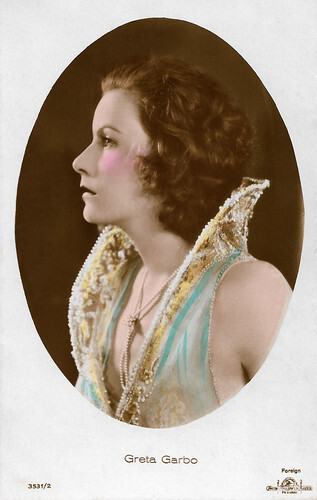
British postcard by Ross Verlag, no. 3531/2, 1928-1929. Photo: MGM. Greta Garbo in Love (Edmund Goulding, 1927).
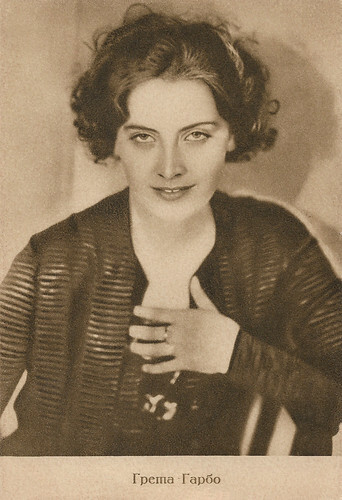
Russian postcard by Goziak, Moscow, series, no. 2, no. 98826, 1927. Photo: Russell Ball. The card was issued in an edition of 20,000 copies.
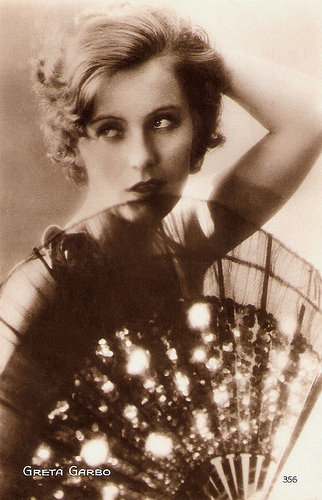
French postcard by Cinémagazine-Edition (CE), Paris, no. 356.
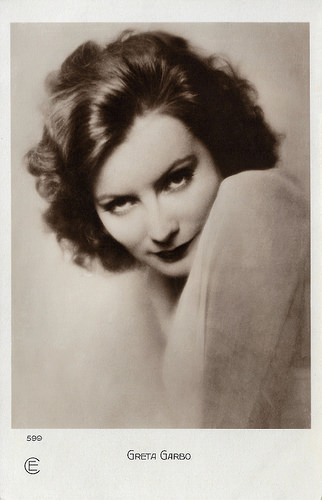
French postcard by Cinémagazine-Edition (CE), Paris, no. 599.
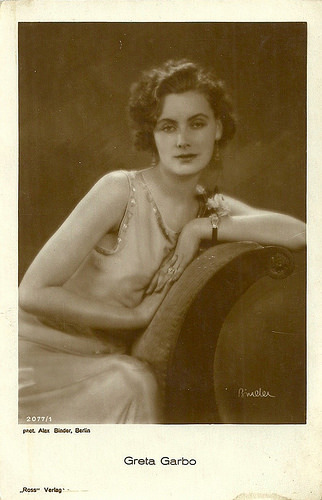
German postcard by Ross Verlag, no. 2077/1, 1927-1928. Photo: Alex Binder, Berlin.
Before going to Hollywood, Garbo starred in the German film Die freudlose Gasse/The Joyless Street (1925) by Georg Wilhelm Pabst. Berlin-based photographer Alex Binder of Atelier Binder made the picture above during the shooting of Die freudlose Gasse in 1924.
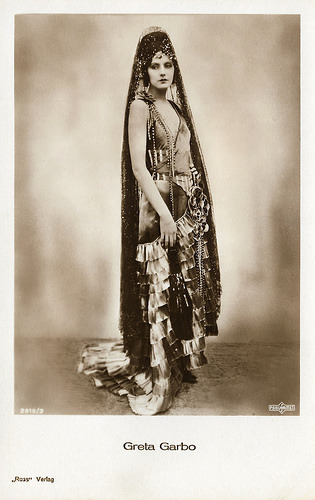
German postcard by Ross Verlag, no. 2010/2, 1927-1928. Photo: Parufamet. Publicity still for Torrent (Monta Bell, 1926).
Following Die freudlose Gasse/The Joyless Street (G.W. Pabst, 1925) both Greta Garbo and her friend and mentor Mauritz Stiller were offered contracts with MGM. Her first film for the studio was the silent production Torrent (Monta Bell, 1926).
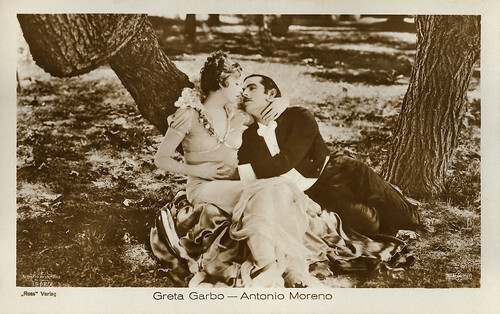
German postcard by Ross Verlag, no. 3062/2, 1928-1929. Photo: Metro-Goldwyn-Mayer / Parufamet. Greta Garbo and Antonio Moreno in The Temptress (Fred Niblo, Mauritz Stiller, 1926).
Department Store Clerk
Greta Garbo was born as Greta Lovisa Gustafsson in Stockholm in 1905. Her parents were Anna Lovisa (Johansdotter), who worked at a jam factory, and Karl Alfred Gustafsson, a labourer. She had an older sister and brother, Alva and Sven. They grew up in a rundown Stockholm district.
Few who knew Greta in her formative years would have predicted her illustrious career. In school, she did little to distinguish herself; nor was her first job, as a barbershop lather girl, indicative of future greatness.
Her father died when she was 14, leaving the family destitute. Greta was forced to leave school and work as a clerk in the PUB department store, where she also would model for newspaper ads.
She photographed beautifully. Her first film aspirations came when she appeared in two short film advertisements, Herr och fru Stockholm/Mr. and Mrs. Stockholm (Ragnar Ring, 1920) and Konsum Stockholm Promo/How Not to Dress (Ragnar Ring, 1921), both were financed by PUB.
Greta also appeared in a one-reel film for a local bakery. The films were seen by director Erik Arthur Petschler who gave her a small part as a bathing beauty in his comedy Luffar-Petter/Peter the Tramp (Erik A. Petschler, 1922).
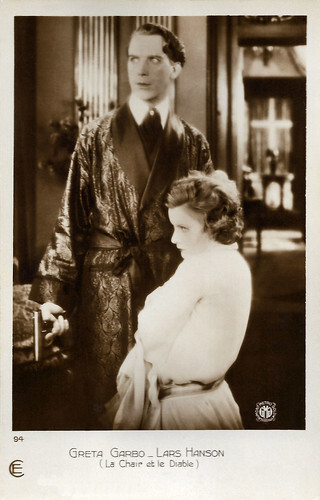
French postcard by Cinémagazine-Edition, no. 94. Photo: Gaumont-Metro. Lars Hanson and Greta Garbo in Flesh and the Devil (Clarence Brown, 1926).
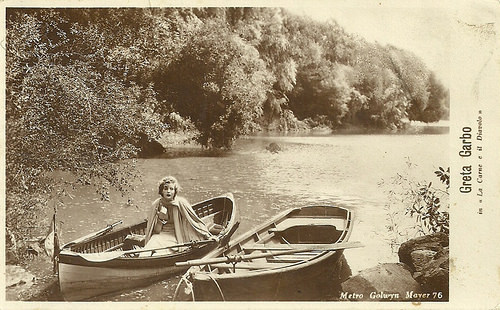
Italian postcard, no. 76. Photo: Metro-Goldwyn-Mayer. Greta Garbo in Flesh and the Devil (Clarence Brown, 1926).
Reportedly, the first scene in Flesh and the Devil between John Gilbert and Greta Garbo in the train station was also the first time Gilbert ever saw Garbo. He falls in love on camera, so completely in love that he never went back home to his wife.
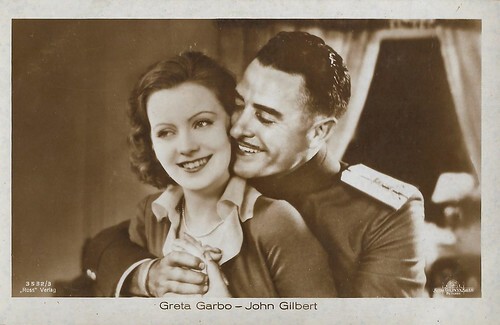
German postcard by Ross Verlag, no. 3532/3, 1928-1929. Photo: Metro-Goldwyn-Mayer. John Gilbert and Greta Garbo in Love (Edmund Goulding, 1927), based on Lev Tolstoy's 'Anna Karenina'.
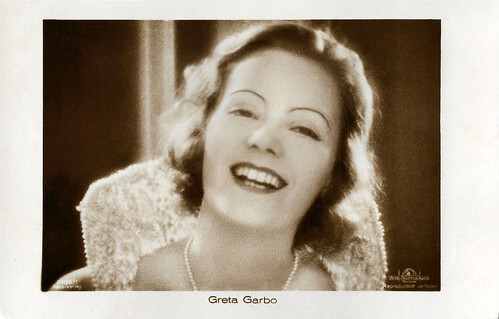
German postcard by Ross Verlag, no. 5106/1, 1930-1931. Photo: Metro-Goldwyn-Mayer. Greta Garbo in Love (Edmund Goulding, 1927).
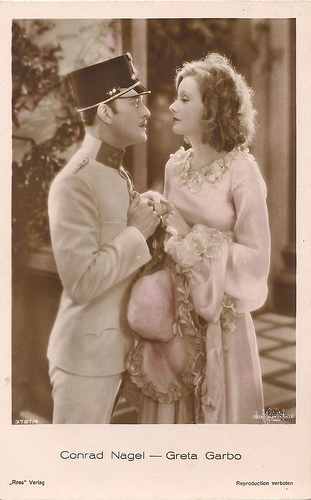
German postcard by Ross Verlag, Foreign, no. 3787/4, 1928-1929. Photo: Metro-Goldwyn-Mayer. Publicity still for The Mysterious Lady (Fred Niblo, 1928) with Conrad Nagel . Collection: Joanna.
We love the taglines for this film: "No man knew what she really was. And no man could resist her exotic beauty. A famous Russian spy, moving through the lives of men, in a maze of intrigue, passion and love."
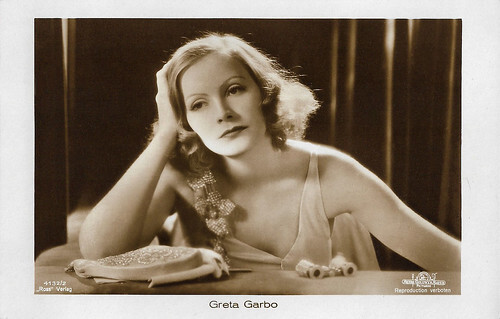
German postcard by Ross Verlag, no. 4132/2, 1929-1930. Photo: Metro Goldwyn Mayer. Greta Garbo in The Mysterious Lady (Fred Niblo, 1928).
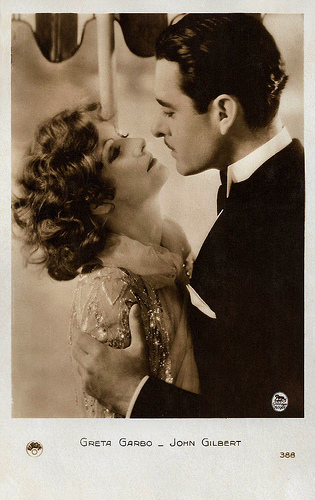
French postcard by Europe, no. 388, distributed in Italy by Casa Editrice Ballerini & Fratini, Firenze. Photo: James Manatt / Metro-Goldwyn-Mayer. Greta Garbo and John Gilbert in A Woman of Affairs (Clarence Brown, 1928).
"Garbo had something behind the eyes that you couldn't see until you photographed her in close-up. You could see thought. If she had to look at one person with jealousy, and another with love, she didn't have to change her expression. You could see it in her eyes as she looked from one to the other. And nobody else could do that on the screen." (director Clarence Brown in a 1968 interview).
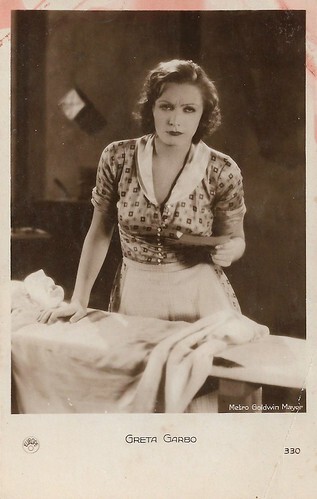
French postcard by Europe, no. 330. Photo: Metro-Goldwyn-Mayer. Greta Garbo in The Divine Woman (Victor Sjöström, 1928).
Minor Star
Greta Gustafson garnered a couple of good trade reviews. It made her confident enough to seek out and win a scholarship to Dramaten, the prestigious Royal Dramatic Theatre in Stockholm. While studying acting there, she appeared in the historical film En lyckoriddare/A Happy Knight (John W. Brunius, 1921) which features Gösta Ekman as the dashing rogue who steals the heart of the ethereal Mary Johnson . Greta played a maid.
Then she met Mauritz Stiller, one of Sweden's foremost film directors in the early 1920s. Stiller trained the 18 years old in cinema acting techniques and gave her the stage name Greta Garbo. He cast her in a major role opposite Lars Hanson in Gösta Berlings Saga/The Legend of Gosta Berling (Mauritz Stiller, 1924). The epic drama was based on a novel by Nobel Prize winner Selma Lagerlöf.
Gösta Berlings Saga was internationally successful and made Greta a minor star. On the strength of this role, she was cast in the German prostitution and depression melodrama Die Freudlose Gasse/The Joyless Street (G.W. Pabst, 1925), in which she co-starred with the Danish screen legend Asta Nielsen .
And then Hollywood called. Louis B. Mayer invited Stiller to work for MGM when Gösta Berlings Saga caught his attention. On viewing the film, Mayer admired Stiller's direction but was not impressed with Garbo's acting and screen presence.
Mauritz Stiller insisted on bringing his protégé to Hollywood, thus, Mayer offered her a contract as well. Later, Garbo’s fame in Hollywood grew while Stiller struggled in the studio system. In 1928 Stiller was abruptly fired from directing Garbo's second MGM film, The Temptress (1926), after repeated arguments with studio execs. After a few more films at another studio, Stiller returned to Sweden, where he died soon after. He was only 45 and reportedly, Garbo was devastated.
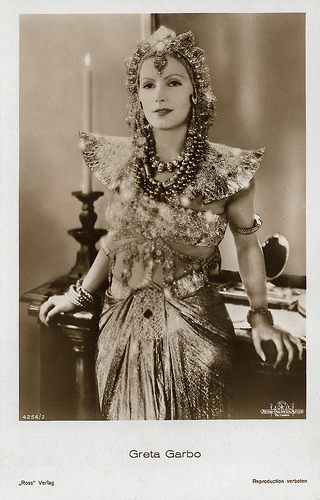
German postcard by Ross Verlag, no. 4256/2, 1929-1930. Photo: Metro-Goldwyn-Mayer. Publicity still for Wild Orchids (Sidney Franklin, 1929).
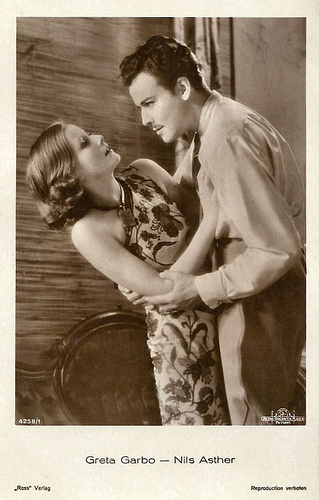
German postcard by Ross Verlag, no. 4258/1, 1929-1930. Photo: Metro-Goldwyn-Mayer. Publicity still for Wild Orchids (Sidney Franklin, 1929) with Nils Asther .
During the production of Wild Orchids, Mauritz Stiller died in Sweden. Devastated by his death, Garbo travelled to Stockholm incognito to mourn his death. Her secretive travel plans were quickly foiled when she was recognised on the voyage.
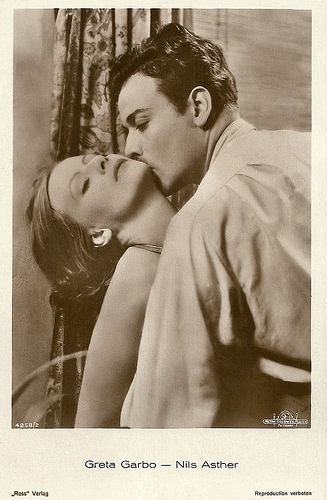
German postcard by Ross Verlag, no. 4258/2, 1929-1930. Photo: Metro-Goldwyn-Mayer. Greta Garbo and Nils Asther in the late silent film Wild Orchids (Sidney Franklin, 1929).
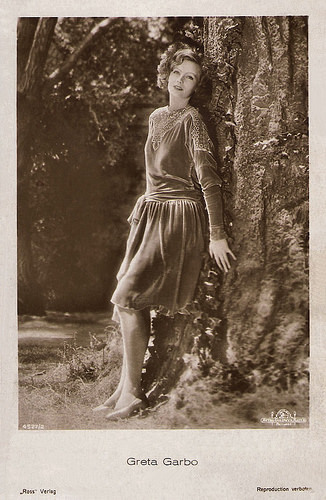
German postcard by Ross Verlag, no. 4527/2, 1929-1930. Photo: Clarence Bull / Metro-Goldwyn-Mayer.
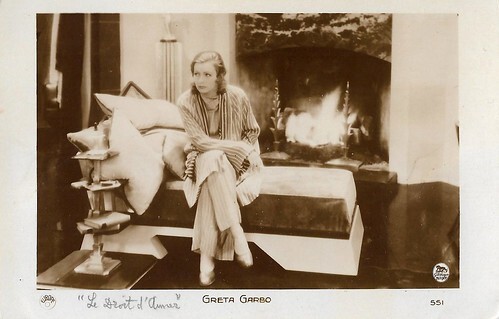
French postcard by Europe, no. 551. Photo: Metro-Goldwyn-Mayer. Greta Garbo in The Single Standard (John S. Robertson, 1929), released in France as Le Droit d'aimer.
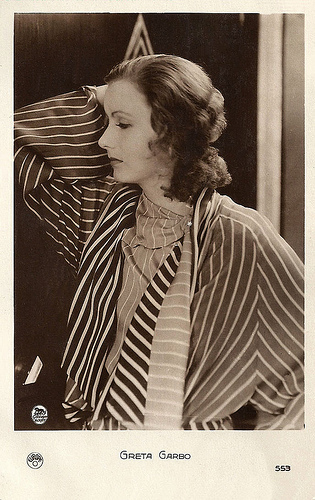
French postcard by Europe, no. 553. Photo: Ruth Harriet Louise / Metro-Goldwyn-Mayer. Publicity still for The Single Standard (John S. Robertson, 1929). Gown by Adrian.
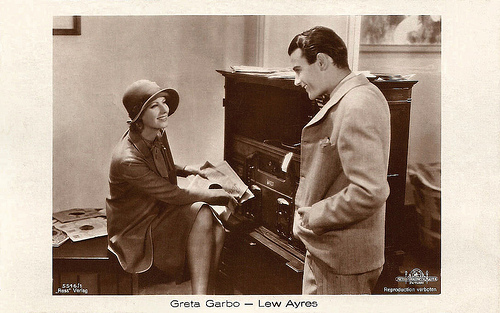
German postcard by Ross Verlag, no. 5516/1, 1930-1931. Photo: Metro-Goldwyn-Mayer (MGM).
Lew Ayres co-starred with Garbo in her last silent film The Kiss (1929), directed by Belgium-born director Jacques Feyder and scripted by German screenwriter Hanns Kräly. After this successful film, Feyder directed Garbo again in the German version of Anna Christie (1930) and then returned to France. There he produced his greatest achievements: Le Grand Jeu (1934), Pension Mimosas (1935) and La Kermesse Héroique/Carnival in Flanders (1935).
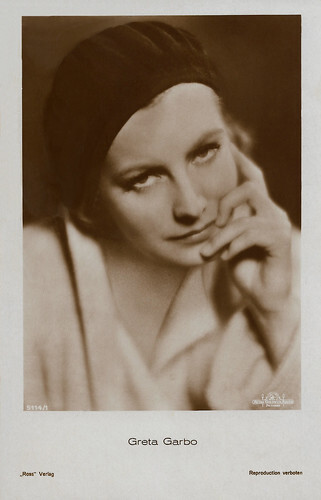
German postcard by Ross Verlag, no. 5114/1, 1930-1931. Photo: Clarence Sinclair Bull / MGM. Publicity still for The Kiss (Jacques Feyder, 1929).
Sources: Garbo Forever and .

British postcard by Ross Verlag, no. 3531/2, 1928-1929. Photo: MGM. Greta Garbo in Love (Edmund Goulding, 1927).

Russian postcard by Goziak, Moscow, series, no. 2, no. 98826, 1927. Photo: Russell Ball. The card was issued in an edition of 20,000 copies.

French postcard by Cinémagazine-Edition (CE), Paris, no. 356.

French postcard by Cinémagazine-Edition (CE), Paris, no. 599.

German postcard by Ross Verlag, no. 2077/1, 1927-1928. Photo: Alex Binder, Berlin.
Before going to Hollywood, Garbo starred in the German film Die freudlose Gasse/The Joyless Street (1925) by Georg Wilhelm Pabst. Berlin-based photographer Alex Binder of Atelier Binder made the picture above during the shooting of Die freudlose Gasse in 1924.

German postcard by Ross Verlag, no. 2010/2, 1927-1928. Photo: Parufamet. Publicity still for Torrent (Monta Bell, 1926).
Following Die freudlose Gasse/The Joyless Street (G.W. Pabst, 1925) both Greta Garbo and her friend and mentor Mauritz Stiller were offered contracts with MGM. Her first film for the studio was the silent production Torrent (Monta Bell, 1926).

German postcard by Ross Verlag, no. 3062/2, 1928-1929. Photo: Metro-Goldwyn-Mayer / Parufamet. Greta Garbo and Antonio Moreno in The Temptress (Fred Niblo, Mauritz Stiller, 1926).
Department Store Clerk
Greta Garbo was born as Greta Lovisa Gustafsson in Stockholm in 1905. Her parents were Anna Lovisa (Johansdotter), who worked at a jam factory, and Karl Alfred Gustafsson, a labourer. She had an older sister and brother, Alva and Sven. They grew up in a rundown Stockholm district.
Few who knew Greta in her formative years would have predicted her illustrious career. In school, she did little to distinguish herself; nor was her first job, as a barbershop lather girl, indicative of future greatness.
Her father died when she was 14, leaving the family destitute. Greta was forced to leave school and work as a clerk in the PUB department store, where she also would model for newspaper ads.
She photographed beautifully. Her first film aspirations came when she appeared in two short film advertisements, Herr och fru Stockholm/Mr. and Mrs. Stockholm (Ragnar Ring, 1920) and Konsum Stockholm Promo/How Not to Dress (Ragnar Ring, 1921), both were financed by PUB.
Greta also appeared in a one-reel film for a local bakery. The films were seen by director Erik Arthur Petschler who gave her a small part as a bathing beauty in his comedy Luffar-Petter/Peter the Tramp (Erik A. Petschler, 1922).

French postcard by Cinémagazine-Edition, no. 94. Photo: Gaumont-Metro. Lars Hanson and Greta Garbo in Flesh and the Devil (Clarence Brown, 1926).

Italian postcard, no. 76. Photo: Metro-Goldwyn-Mayer. Greta Garbo in Flesh and the Devil (Clarence Brown, 1926).
Reportedly, the first scene in Flesh and the Devil between John Gilbert and Greta Garbo in the train station was also the first time Gilbert ever saw Garbo. He falls in love on camera, so completely in love that he never went back home to his wife.

German postcard by Ross Verlag, no. 3532/3, 1928-1929. Photo: Metro-Goldwyn-Mayer. John Gilbert and Greta Garbo in Love (Edmund Goulding, 1927), based on Lev Tolstoy's 'Anna Karenina'.

German postcard by Ross Verlag, no. 5106/1, 1930-1931. Photo: Metro-Goldwyn-Mayer. Greta Garbo in Love (Edmund Goulding, 1927).

German postcard by Ross Verlag, Foreign, no. 3787/4, 1928-1929. Photo: Metro-Goldwyn-Mayer. Publicity still for The Mysterious Lady (Fred Niblo, 1928) with Conrad Nagel . Collection: Joanna.
We love the taglines for this film: "No man knew what she really was. And no man could resist her exotic beauty. A famous Russian spy, moving through the lives of men, in a maze of intrigue, passion and love."

German postcard by Ross Verlag, no. 4132/2, 1929-1930. Photo: Metro Goldwyn Mayer. Greta Garbo in The Mysterious Lady (Fred Niblo, 1928).

French postcard by Europe, no. 388, distributed in Italy by Casa Editrice Ballerini & Fratini, Firenze. Photo: James Manatt / Metro-Goldwyn-Mayer. Greta Garbo and John Gilbert in A Woman of Affairs (Clarence Brown, 1928).
"Garbo had something behind the eyes that you couldn't see until you photographed her in close-up. You could see thought. If she had to look at one person with jealousy, and another with love, she didn't have to change her expression. You could see it in her eyes as she looked from one to the other. And nobody else could do that on the screen." (director Clarence Brown in a 1968 interview).

French postcard by Europe, no. 330. Photo: Metro-Goldwyn-Mayer. Greta Garbo in The Divine Woman (Victor Sjöström, 1928).
Minor Star
Greta Gustafson garnered a couple of good trade reviews. It made her confident enough to seek out and win a scholarship to Dramaten, the prestigious Royal Dramatic Theatre in Stockholm. While studying acting there, she appeared in the historical film En lyckoriddare/A Happy Knight (John W. Brunius, 1921) which features Gösta Ekman as the dashing rogue who steals the heart of the ethereal Mary Johnson . Greta played a maid.
Then she met Mauritz Stiller, one of Sweden's foremost film directors in the early 1920s. Stiller trained the 18 years old in cinema acting techniques and gave her the stage name Greta Garbo. He cast her in a major role opposite Lars Hanson in Gösta Berlings Saga/The Legend of Gosta Berling (Mauritz Stiller, 1924). The epic drama was based on a novel by Nobel Prize winner Selma Lagerlöf.
Gösta Berlings Saga was internationally successful and made Greta a minor star. On the strength of this role, she was cast in the German prostitution and depression melodrama Die Freudlose Gasse/The Joyless Street (G.W. Pabst, 1925), in which she co-starred with the Danish screen legend Asta Nielsen .
And then Hollywood called. Louis B. Mayer invited Stiller to work for MGM when Gösta Berlings Saga caught his attention. On viewing the film, Mayer admired Stiller's direction but was not impressed with Garbo's acting and screen presence.
Mauritz Stiller insisted on bringing his protégé to Hollywood, thus, Mayer offered her a contract as well. Later, Garbo’s fame in Hollywood grew while Stiller struggled in the studio system. In 1928 Stiller was abruptly fired from directing Garbo's second MGM film, The Temptress (1926), after repeated arguments with studio execs. After a few more films at another studio, Stiller returned to Sweden, where he died soon after. He was only 45 and reportedly, Garbo was devastated.

German postcard by Ross Verlag, no. 4256/2, 1929-1930. Photo: Metro-Goldwyn-Mayer. Publicity still for Wild Orchids (Sidney Franklin, 1929).

German postcard by Ross Verlag, no. 4258/1, 1929-1930. Photo: Metro-Goldwyn-Mayer. Publicity still for Wild Orchids (Sidney Franklin, 1929) with Nils Asther .
During the production of Wild Orchids, Mauritz Stiller died in Sweden. Devastated by his death, Garbo travelled to Stockholm incognito to mourn his death. Her secretive travel plans were quickly foiled when she was recognised on the voyage.

German postcard by Ross Verlag, no. 4258/2, 1929-1930. Photo: Metro-Goldwyn-Mayer. Greta Garbo and Nils Asther in the late silent film Wild Orchids (Sidney Franklin, 1929).

German postcard by Ross Verlag, no. 4527/2, 1929-1930. Photo: Clarence Bull / Metro-Goldwyn-Mayer.

French postcard by Europe, no. 551. Photo: Metro-Goldwyn-Mayer. Greta Garbo in The Single Standard (John S. Robertson, 1929), released in France as Le Droit d'aimer.

French postcard by Europe, no. 553. Photo: Ruth Harriet Louise / Metro-Goldwyn-Mayer. Publicity still for The Single Standard (John S. Robertson, 1929). Gown by Adrian.

German postcard by Ross Verlag, no. 5516/1, 1930-1931. Photo: Metro-Goldwyn-Mayer (MGM).
Lew Ayres co-starred with Garbo in her last silent film The Kiss (1929), directed by Belgium-born director Jacques Feyder and scripted by German screenwriter Hanns Kräly. After this successful film, Feyder directed Garbo again in the German version of Anna Christie (1930) and then returned to France. There he produced his greatest achievements: Le Grand Jeu (1934), Pension Mimosas (1935) and La Kermesse Héroique/Carnival in Flanders (1935).

German postcard by Ross Verlag, no. 5114/1, 1930-1931. Photo: Clarence Sinclair Bull / MGM. Publicity still for The Kiss (Jacques Feyder, 1929).
Sources: Garbo Forever and .
Published on September 02, 2022 22:00
September 1, 2022
Ann Blyth
American actress and singer Ann Blyth (1928) was often cast in Hollywood musicals, but she was also successful in dramatic roles. Her performance as Veda Pierce in Mildred Pierce (Michael Curtiz, 1945) was nominated for an Academy Award for Best Supporting Actress. She is one of the last surviving stars from the Golden Age of Hollywood.
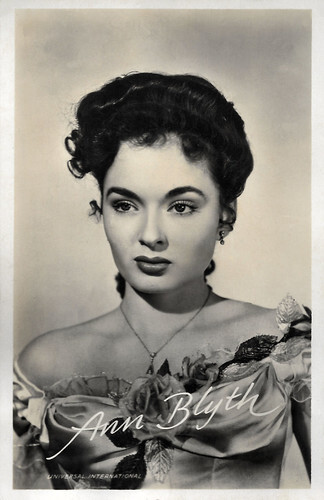
Dutch postcard by Foto-archief Film en Toneel, no. 3370. Photo: Universal-International. Ann Blyth in Another Part of the Forest (Michael Gordon, 1948).
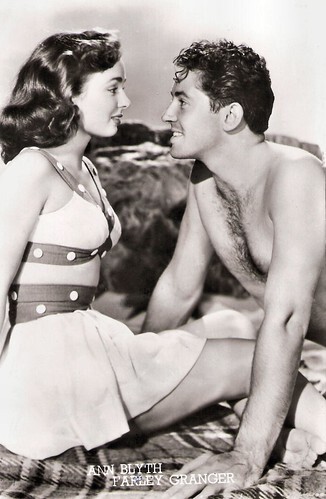
Vintage postcard. Photo: Universal International. Farley Granger and Ann Blyth in Our Very Own (David Miller, 1950).
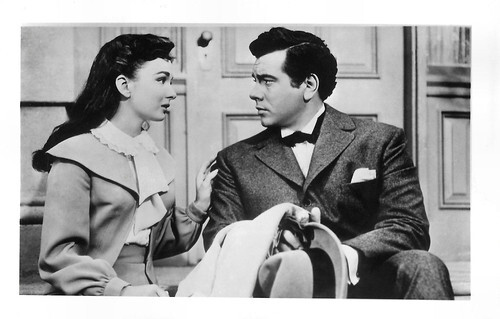
German photo-card. Photo: Metro-Goldwyn-Mayer. Mario Lanza and Ann Blyth in The Great Caruso (Richard Thorpe, 1951).
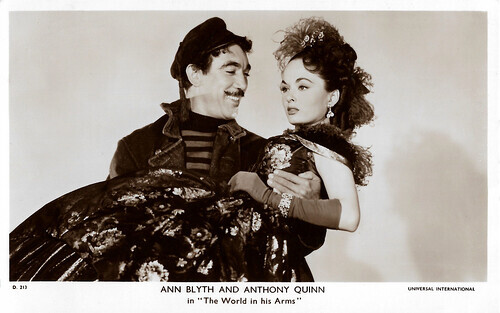
British postcard in the Picturegoer Series, London, no. D. 213. Photo: Universal International. Anthony Quinn and Ann Blyth in The World in his Arms (Raoul Walsh, 1952).
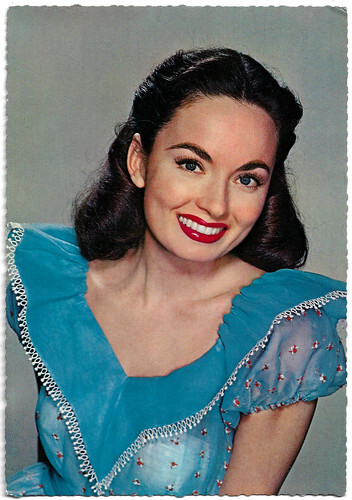
West-German postcard by Krüger, no. 902/6.
A scheming, ungrateful daughter
Ann Blyth was born in 1928 in Mount Kisco, New York, to Harry and Nan Lynch Blyth. After her parents separated, she, her mother and her sister moved to a walk-up apartment on East 31st Street in New York City, where her mother took in ironing. Ann attended St. Patrick's School in Manhattan.
Blyth performed on children's radio shows in New York for six years, making her first appearance when she was five. When she was nine she joined the New York Children's Opera Company. Her first acting role was on Broadway at age 13 in Lillian Hellman's WWII drama 'Watch on the Rhine' (1941-1942). She played the part of Paul Lukas 's and Mady Christians 's daughter, Babette. The play ran for 378 performances and won the New York Drama Critics' Circle Award.
After the New York run, the play went on tour, and while performing at the Biltmore Theatre in Los Angeles, Blyth was noticed by director Henry Koster and given a screen testoffered a contract with Universal Studios. Blyth began her acting career initially as "Anne Blyth", but changed the spelling of her first name back to "Ann" at the beginning of her film career. She made her film debut in 1944, teamed with Donald O'Connor and Peggy Ryan in the teenage musical Chip Off the Old Block (Charles Lamont, 1944). She followed it with two similar films: The Merry Monahans (Charles Lamont, 1944) with O'Connor and Ryan again, and Babes on Swing Street (Edward C. Lilley, 1944) with Ryan.
She had a support role in the bigger budgeted Bowery to Broadway (Charles Lamont, 1944), a showcase of Universal musical talent. On loan to Warner Brothers, Blyth was cast 'against type' as Veda Pierce, the scheming, ungrateful daughter of Joan Crawford in Mildred Pierce (Michael Curtiz, 1945). Her dramatic portrayal won her outstanding reviews, and she received a nomination for an Academy Award for Best Supporting Actress.
Blyth was only 16 when she made the film, for which Crawford won the Best Actress award. After Mildred Pierce, Blyth sustained a broken back while tobogganing in Snow Valley, and was not able to fully capitalise on the film's success. After a long convalescence (over a year and a half in a back brace), she made two films for Mark Hellinger's unit at Universal: Swell Guy (Frank Tuttle, 1946), with Sonny Tufts, and Brute Force (Jules Dassin, 1947) with Burt Lancaster . During this time her father died.
Metro-Goldwyn-Mayer borrowed her to play the female lead in Killer McCoy (Roy Rowland, 1947), a boxing film with Mickey Rooney that was a box office hit. Back at Universal, she did a Film Noir with Charles Boyer , A Woman's Vengeance (Zoltan Korda, 1948). She was then cast in the part of Regina Hubbard in Lillian Hellman's Another Part of the Forest (Michael Gordon, 1948), an adaptation of the 1946 play where Regina had been played by Patricia Neal. The play was a prequel to 'The Little Foxes'.
Blyth followed it with Mr. Peabody and the Mermaid (Irving Pichel, 1948) with William Powell. She was top-billed in Red Canyon (George Sherman, 1949), a Western with Howard Duff. Paramount borrowed Blyth to play the female lead in Top o' the Morning (David Miller, 1949), a daughter of Barry Fitzgerald who is romanced by Bing Crosby. It was the first time she sang on screen. Back at Universal, she was teamed with Robert Montgomery in Once More, My Darling (Robert Montgomery, 1949), meaning she had to drop out of Desert Legion. She did a comedy with Robert Cummings, Free for All (Charles Barton, 1949). In April 1949, Universal suspended her for refusing a lead role in Abandoned (1949). Gale Storm played it.
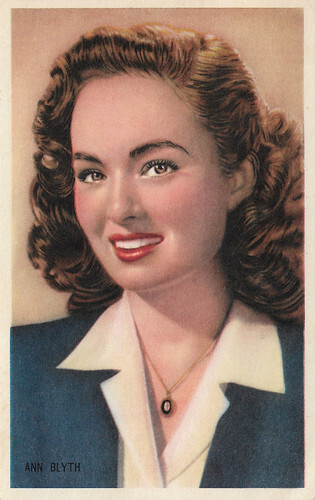
Belgian card by Kwatta, Bois d'Haine, no. C. 206. Ann Blyth in Killer McCoy (Roy Rowland, 1947).
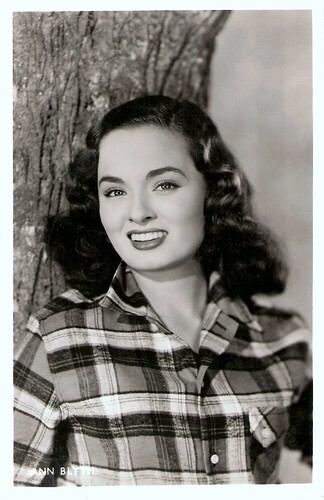
Dutch postcard by J. Sleding N.V., Amsterdam, no. 1250.
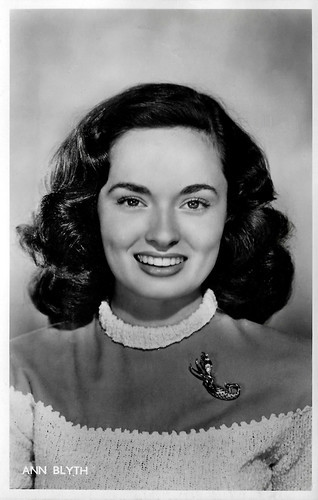
Dutch postcard.
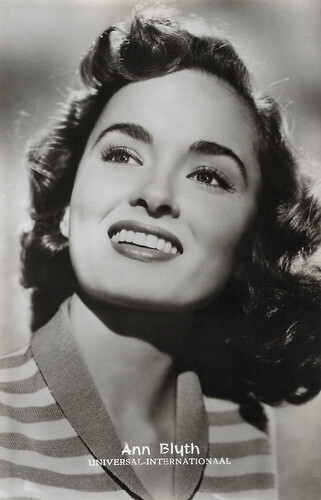
Belgian postcard, no. 11. Photo: Universal-International.
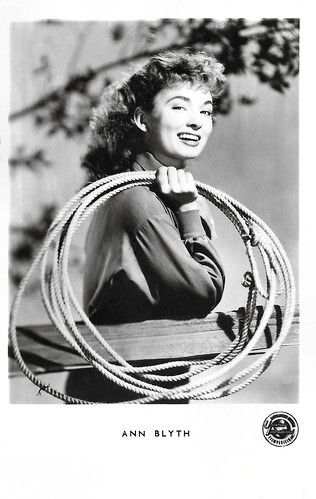
West-German postcard by Netter's Star Verlag, Berlin. Photo: Universal International. A publicity still for Red Canyon (George Sherman, 1949).
A massive box office hit
Ann Blyth was borrowed by Sam Goldwyn to star opposite Farley Granger in Our Very Own (David Miller, 1950). Universal gave her top billing in a romantic comedy, Katie Did It (Frederick De Cordova, 1951). Blyth was borrowed by MGM for The Great Caruso (Richard Thorpe, 1951) opposite Mario Lanza which was a massive box office hit. She made Thunder on the Hill (Douglas Sirk, 1951) with Claudette Colbert and had the female lead in The Golden Horde (George Sherman, 1951) with David Farrar.
Then, 20th Century Fox borrowed her to star opposite Tyrone Power in I'll Never Forget You (Roy Ward Baker, 1952), a last-minute replacement for Constance Smith. She appeared on TV in Family Theater in an episode called 'The World's Greatest Mother' alongside Ethel Barrymore. Universal teamed Blyth with Gregory Peck in The World in His Arms (Raoul Walsh, 1952). She was top-billed in the comedy Sally and Saint Anne (Rudolph Maté, 1952) and was borrowed by RKO for One Minute to Zero (Tay Garnett, 1952), a Korean War drama with Robert Mitchum where she replaced Claudette Colbert who came down with pneumonia.
MGM had been interested in Blyth since The Great Caruso. In December 1953, Blyth left Universal and she signed a long term contract with MGM. She was the leading lady in All the Brothers Were Valiant (Richard Thorpe, 1953) with Stewart Granger and Robert Taylor , stepping in for Elizabeth Taylor who had to drop out due to pregnancy. On television, she was in a version of A Place in the Sun for Lux Video Theatre alongside John Derek. Back at MGM, Blyth had the lead in the remake of Rose Marie (Mervyn LeRoy, 1954) with Howard Keel, which earned over $5 million but lost money due to high costs.
She was meant to be reteamed with Lanza in The Student Prince (Richard Thorpe, 1954) but he was fired from the studio and was replaced in the picture by Edmund Purdom . The film did well at the box office. Blyth and Purdom were reunited on a swashbuckler, The King's Thief (Robert Z. Leonard, 1955). She was teamed again with Keel on the musical Kismet (Vincente Minnelli, 1955). Despite strong reviews, the film was a financial flop.
She was named for the female lead in The Adventures of Quentin Durward (1955) but was eventually not cast in the film. MGM put Blyth in Slander (Roy Rowland, 1957) with Van Johnson. Sidney Sheldon cast Blyth in The Buster Keaton Story (Sidney Sheldon, 1957) with Donald O'Connor at Paramount. Warner Bros then cast her in the title role of The Helen Morgan Story (Michael Curtiz, 1957) with Paul Newman . Blyth reportedly beat 40 other actors for the part. Even though her voice was more like the original Helen Morgan, her vocals were dubbed by Gogi Grant. That soundtrack was much more successful than the film itself.
Blyth made no further films. In 1957, she sued Benedict Bogeaus for $75,000 for not making the film Conquest. From the late 1950s into the 1970s, Blyth worked in musical theatre and summer stock, starring in the shows 'The King and I', 'The Sound of Music', and 'Show Boat'. She also appeared on television, including co-starring opposite James Donald in The Citadel (1960), an adaptation of A.J. Cronin's novel. She guest-starred on episodes of such series as The DuPont Show with June Allyson, The Dick Powell Theatre, Saints and Sinners, The Christophers, Wagon Train, The Twilight Zone, and Burke's Law. Several of these appearances were for Four Star Television with whom Blyth signed a multi-appearance contract.
Blyth also became the spokesperson for Hostess Cupcakes. Her last television appearances were in episodes of Switch (1983), Quincy, M.E. (1983) and Murder, She Wrote (1985). In 1985, she officially retired. For her contributions to the film industry, Blyth has a motion pictures star on the Hollywood Walk of Fame at 6733 Hollywood Boulevard.
In 1953, Ann Blyth married obstetrician James McNulty, brother of singer Dennis Day, who had introduced them. After her marriage, Blyth took somewhat of a reprieve from her career to focus on raising their five children, Timothy Patrick (1954); Maureen Ann (1955); Kathleen Mary (1957); Terence Grady (1960); and Eileen Alana (1963). Blyth continues to be seen occasionally at social functions and conventions.
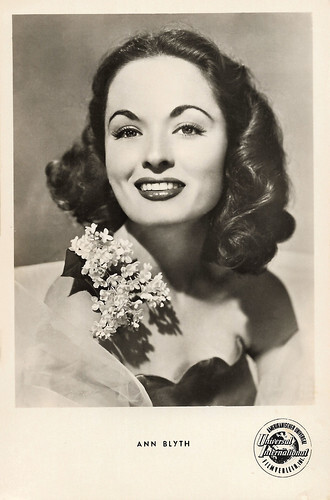
West-German postcard by Kunst und Bild, Berlin, no. A 414. Photo: Universal International.
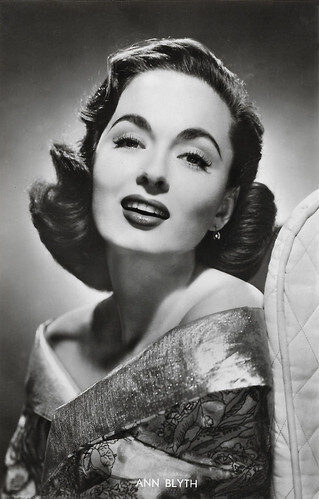
Belgian postcard. Photo: M.G.M.
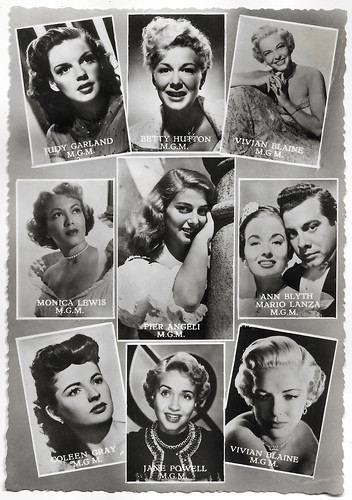
Dutch postcard by Sparo (Gebr. Spanjersberg N.V., Rotterdam). Photos: Metro-Goldwyn-Mayer. The picture stars are Judy Garland , Betty Hutton, Vivian Blaine (twice), Monica Lewis, Pier Angeli , Ann Blyth and Mario Lanza , Coleen Gray, and Jane Powell. The postcard must date from ca. 1951 when Blyth and Lanza starred together in The Great Caruso (Richard Thorpe, 1951).
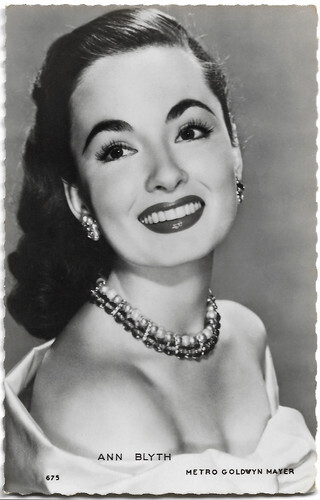
French postcard by Editions P.I., Paris, no. 675. Photo: Metro-Goldwyn-Mayer. 1952.
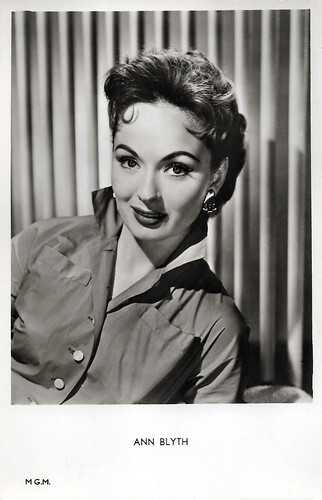
Belgian postcard, no. 11. Photo: MGM.
Sources: (IMDb), Wikipedia (Dutch and English) and .

Dutch postcard by Foto-archief Film en Toneel, no. 3370. Photo: Universal-International. Ann Blyth in Another Part of the Forest (Michael Gordon, 1948).

Vintage postcard. Photo: Universal International. Farley Granger and Ann Blyth in Our Very Own (David Miller, 1950).

German photo-card. Photo: Metro-Goldwyn-Mayer. Mario Lanza and Ann Blyth in The Great Caruso (Richard Thorpe, 1951).

British postcard in the Picturegoer Series, London, no. D. 213. Photo: Universal International. Anthony Quinn and Ann Blyth in The World in his Arms (Raoul Walsh, 1952).

West-German postcard by Krüger, no. 902/6.
A scheming, ungrateful daughter
Ann Blyth was born in 1928 in Mount Kisco, New York, to Harry and Nan Lynch Blyth. After her parents separated, she, her mother and her sister moved to a walk-up apartment on East 31st Street in New York City, where her mother took in ironing. Ann attended St. Patrick's School in Manhattan.
Blyth performed on children's radio shows in New York for six years, making her first appearance when she was five. When she was nine she joined the New York Children's Opera Company. Her first acting role was on Broadway at age 13 in Lillian Hellman's WWII drama 'Watch on the Rhine' (1941-1942). She played the part of Paul Lukas 's and Mady Christians 's daughter, Babette. The play ran for 378 performances and won the New York Drama Critics' Circle Award.
After the New York run, the play went on tour, and while performing at the Biltmore Theatre in Los Angeles, Blyth was noticed by director Henry Koster and given a screen testoffered a contract with Universal Studios. Blyth began her acting career initially as "Anne Blyth", but changed the spelling of her first name back to "Ann" at the beginning of her film career. She made her film debut in 1944, teamed with Donald O'Connor and Peggy Ryan in the teenage musical Chip Off the Old Block (Charles Lamont, 1944). She followed it with two similar films: The Merry Monahans (Charles Lamont, 1944) with O'Connor and Ryan again, and Babes on Swing Street (Edward C. Lilley, 1944) with Ryan.
She had a support role in the bigger budgeted Bowery to Broadway (Charles Lamont, 1944), a showcase of Universal musical talent. On loan to Warner Brothers, Blyth was cast 'against type' as Veda Pierce, the scheming, ungrateful daughter of Joan Crawford in Mildred Pierce (Michael Curtiz, 1945). Her dramatic portrayal won her outstanding reviews, and she received a nomination for an Academy Award for Best Supporting Actress.
Blyth was only 16 when she made the film, for which Crawford won the Best Actress award. After Mildred Pierce, Blyth sustained a broken back while tobogganing in Snow Valley, and was not able to fully capitalise on the film's success. After a long convalescence (over a year and a half in a back brace), she made two films for Mark Hellinger's unit at Universal: Swell Guy (Frank Tuttle, 1946), with Sonny Tufts, and Brute Force (Jules Dassin, 1947) with Burt Lancaster . During this time her father died.
Metro-Goldwyn-Mayer borrowed her to play the female lead in Killer McCoy (Roy Rowland, 1947), a boxing film with Mickey Rooney that was a box office hit. Back at Universal, she did a Film Noir with Charles Boyer , A Woman's Vengeance (Zoltan Korda, 1948). She was then cast in the part of Regina Hubbard in Lillian Hellman's Another Part of the Forest (Michael Gordon, 1948), an adaptation of the 1946 play where Regina had been played by Patricia Neal. The play was a prequel to 'The Little Foxes'.
Blyth followed it with Mr. Peabody and the Mermaid (Irving Pichel, 1948) with William Powell. She was top-billed in Red Canyon (George Sherman, 1949), a Western with Howard Duff. Paramount borrowed Blyth to play the female lead in Top o' the Morning (David Miller, 1949), a daughter of Barry Fitzgerald who is romanced by Bing Crosby. It was the first time she sang on screen. Back at Universal, she was teamed with Robert Montgomery in Once More, My Darling (Robert Montgomery, 1949), meaning she had to drop out of Desert Legion. She did a comedy with Robert Cummings, Free for All (Charles Barton, 1949). In April 1949, Universal suspended her for refusing a lead role in Abandoned (1949). Gale Storm played it.

Belgian card by Kwatta, Bois d'Haine, no. C. 206. Ann Blyth in Killer McCoy (Roy Rowland, 1947).

Dutch postcard by J. Sleding N.V., Amsterdam, no. 1250.

Dutch postcard.

Belgian postcard, no. 11. Photo: Universal-International.

West-German postcard by Netter's Star Verlag, Berlin. Photo: Universal International. A publicity still for Red Canyon (George Sherman, 1949).
A massive box office hit
Ann Blyth was borrowed by Sam Goldwyn to star opposite Farley Granger in Our Very Own (David Miller, 1950). Universal gave her top billing in a romantic comedy, Katie Did It (Frederick De Cordova, 1951). Blyth was borrowed by MGM for The Great Caruso (Richard Thorpe, 1951) opposite Mario Lanza which was a massive box office hit. She made Thunder on the Hill (Douglas Sirk, 1951) with Claudette Colbert and had the female lead in The Golden Horde (George Sherman, 1951) with David Farrar.
Then, 20th Century Fox borrowed her to star opposite Tyrone Power in I'll Never Forget You (Roy Ward Baker, 1952), a last-minute replacement for Constance Smith. She appeared on TV in Family Theater in an episode called 'The World's Greatest Mother' alongside Ethel Barrymore. Universal teamed Blyth with Gregory Peck in The World in His Arms (Raoul Walsh, 1952). She was top-billed in the comedy Sally and Saint Anne (Rudolph Maté, 1952) and was borrowed by RKO for One Minute to Zero (Tay Garnett, 1952), a Korean War drama with Robert Mitchum where she replaced Claudette Colbert who came down with pneumonia.
MGM had been interested in Blyth since The Great Caruso. In December 1953, Blyth left Universal and she signed a long term contract with MGM. She was the leading lady in All the Brothers Were Valiant (Richard Thorpe, 1953) with Stewart Granger and Robert Taylor , stepping in for Elizabeth Taylor who had to drop out due to pregnancy. On television, she was in a version of A Place in the Sun for Lux Video Theatre alongside John Derek. Back at MGM, Blyth had the lead in the remake of Rose Marie (Mervyn LeRoy, 1954) with Howard Keel, which earned over $5 million but lost money due to high costs.
She was meant to be reteamed with Lanza in The Student Prince (Richard Thorpe, 1954) but he was fired from the studio and was replaced in the picture by Edmund Purdom . The film did well at the box office. Blyth and Purdom were reunited on a swashbuckler, The King's Thief (Robert Z. Leonard, 1955). She was teamed again with Keel on the musical Kismet (Vincente Minnelli, 1955). Despite strong reviews, the film was a financial flop.
She was named for the female lead in The Adventures of Quentin Durward (1955) but was eventually not cast in the film. MGM put Blyth in Slander (Roy Rowland, 1957) with Van Johnson. Sidney Sheldon cast Blyth in The Buster Keaton Story (Sidney Sheldon, 1957) with Donald O'Connor at Paramount. Warner Bros then cast her in the title role of The Helen Morgan Story (Michael Curtiz, 1957) with Paul Newman . Blyth reportedly beat 40 other actors for the part. Even though her voice was more like the original Helen Morgan, her vocals were dubbed by Gogi Grant. That soundtrack was much more successful than the film itself.
Blyth made no further films. In 1957, she sued Benedict Bogeaus for $75,000 for not making the film Conquest. From the late 1950s into the 1970s, Blyth worked in musical theatre and summer stock, starring in the shows 'The King and I', 'The Sound of Music', and 'Show Boat'. She also appeared on television, including co-starring opposite James Donald in The Citadel (1960), an adaptation of A.J. Cronin's novel. She guest-starred on episodes of such series as The DuPont Show with June Allyson, The Dick Powell Theatre, Saints and Sinners, The Christophers, Wagon Train, The Twilight Zone, and Burke's Law. Several of these appearances were for Four Star Television with whom Blyth signed a multi-appearance contract.
Blyth also became the spokesperson for Hostess Cupcakes. Her last television appearances were in episodes of Switch (1983), Quincy, M.E. (1983) and Murder, She Wrote (1985). In 1985, she officially retired. For her contributions to the film industry, Blyth has a motion pictures star on the Hollywood Walk of Fame at 6733 Hollywood Boulevard.
In 1953, Ann Blyth married obstetrician James McNulty, brother of singer Dennis Day, who had introduced them. After her marriage, Blyth took somewhat of a reprieve from her career to focus on raising their five children, Timothy Patrick (1954); Maureen Ann (1955); Kathleen Mary (1957); Terence Grady (1960); and Eileen Alana (1963). Blyth continues to be seen occasionally at social functions and conventions.

West-German postcard by Kunst und Bild, Berlin, no. A 414. Photo: Universal International.

Belgian postcard. Photo: M.G.M.

Dutch postcard by Sparo (Gebr. Spanjersberg N.V., Rotterdam). Photos: Metro-Goldwyn-Mayer. The picture stars are Judy Garland , Betty Hutton, Vivian Blaine (twice), Monica Lewis, Pier Angeli , Ann Blyth and Mario Lanza , Coleen Gray, and Jane Powell. The postcard must date from ca. 1951 when Blyth and Lanza starred together in The Great Caruso (Richard Thorpe, 1951).

French postcard by Editions P.I., Paris, no. 675. Photo: Metro-Goldwyn-Mayer. 1952.

Belgian postcard, no. 11. Photo: MGM.
Sources: (IMDb), Wikipedia (Dutch and English) and .
Published on September 01, 2022 22:00
August 31, 2022
Maria Schell
Pretty, wide-eyed Austrian leading lady Maria Schell (1926-2005) became one of the first film idols of the European post-war generation. With her 'smile under tears', she appeared in dozens of German and Austrian popular films, but she also starred in British, French, Italian, and Hollywood productions.
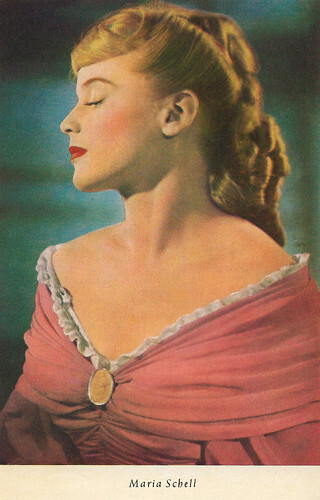
West-German postcard by WS-Druck, Wanne-Eickel. Photo: Schorchtfilm-Verleih. Maria Schell in Es kommt ein Tag/A Day Will Come (Rudolf Jugert, 1950).
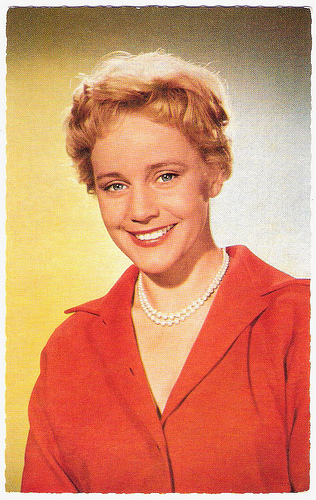
German postcard by Kolibri-Verlag G.m.b.H., Minden/Westf., no. F 27. Retail price: 25 Pfg. Photo: Ringpress / Vogelmann.
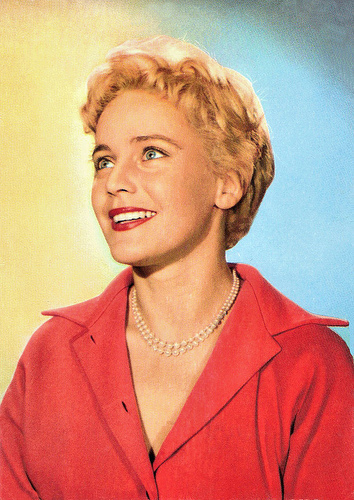
French postcard by Editions P.I., Paris, no. 74. Photo: Ufa / Vogelmann.
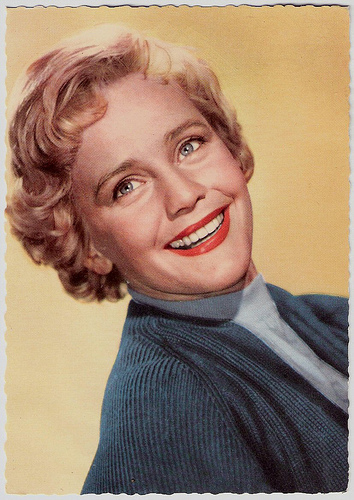
German postcard by Ufa (Universum-Film Aktiengesellschaft), Berlin-Tempelhof, no. CK-75. Retail price: 30 Pfg. Photo: Columbia Film.
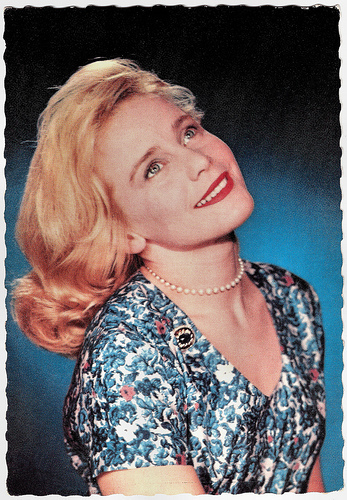
French postcard by Editions du Globe, Paris, no. 24. Photo: Sam Lévin.
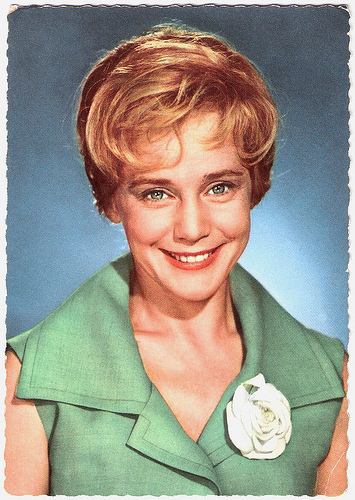
German postcard by UFA, no. CK-225. Retail price: 30 Pfg. Photo: Sam Lévin / UFA. Collection: Geoffrey Donaldson Institute.
Escape
Margarete Schell was born in Vienna in 1926 as the daughter of the Swiss author Ferdinand Hermann Schell and Austrian actress Margarete Schell Noé. She was the older sister of the actors Immy, Carl, and Maximilian Schell .
Her family had to escape from the Nazi regime in 1938, and she received dramatic training in Zurich, Switzerland. To pay for her studies she worked as a secretary.
Billed as Gritli Schell, she made her screen debut at 16 in the Swiss-filmed drama Steibruch (Sigfrit Steiner, 1942).
It would be six years before she'd appear before the cameras again in Der Engel mit der Posaune (Karl Hartl, 1948). This Austro-German production was simultaneously filmed in an English-language version, The Angel With the Trumpet (Anthony Bushell, 1950), which brought her to the attention of international filmgoers.
In the 1950s Maria often played the sweet and innocent Mädchen in numerous Austrian and German films. She starred opposite Dieter Borsche in popular melodramas like Es kommt ein Tag/A Day Will Come (Rudolf Jugert, 1950) and Dr. Holl (Rolf Hansen, 1951).
With O.W. Fischer she formed one of the 'Dream Couples of the German cinema' in romantic melodramas like Bis wir uns wiedersehen/Till We Meet Again (Gustav Ucicky, 1952), Der träumende Mund/Dreaming Lips (Josef von Báky, 1953), and Solange Du da bist/As Long As You're Near Me (Rolf Hansen, 1953).
She also starred in British productions like The Magic Box (John Boulting, 1951) with Robert Donat , and The Heart of the Matter (George More O'Ferrall, 1953) opposite Trevor Howard .
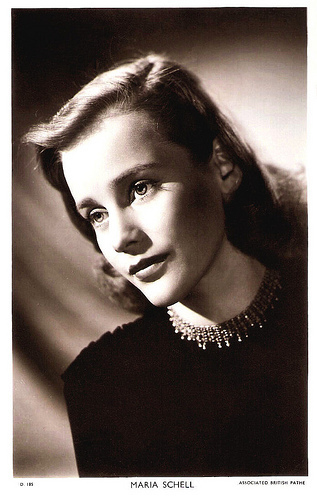
British postcard in the Picturegoer Series, London, no. D 185. Photo: Associated British Pathé.
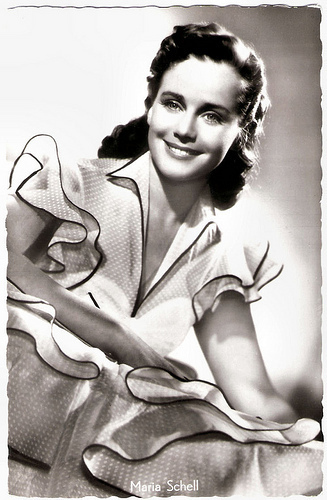
German postcard by Kolibri-Verlag, Minden/Westf., no. 831. Photo: NDF / Schorchtfilm.
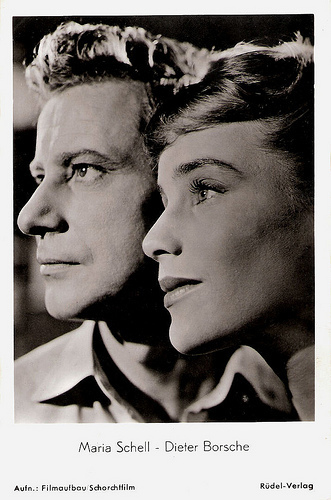
With Dieter Borsche . German postcard by F.J. Rüdel, Filmpostkartenverlag, Hamburg-Bergedorf, no. 560. Photo: Filmaufbau Schorchfilm. Publicity still for Es komt ein Tag/A Day Will Come (Rudolf Jugert, 1950).
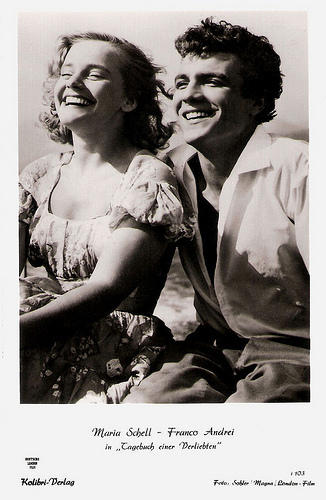
With Franco Andrei . German postcard by Kolibri-Verlag, no. I 103. Photo: Sohler / Magna / London-Film. Publicity still for Tagebuch einer Verliebten/The Diary of a Married Woman (Josef von Báky, 1953).
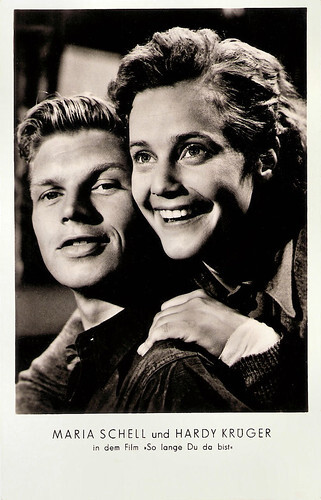
East-German postcard by Reichenbach, no. 691/56. Photo: NDF / Schorchtfilm. Maria Schell and Hardy Krüger in So lange Du da bist/As Long as You're Near Me (Harald Braun, 1953).
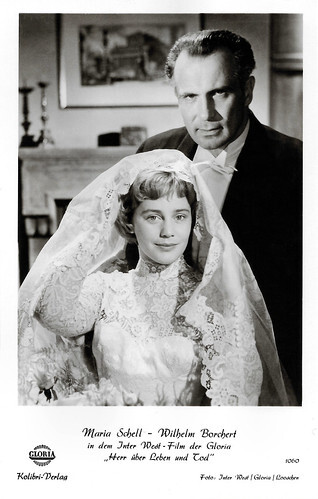
West-German postcard by Kolibri-Verlag, no. 1060. Photo: Inter West / Gloria / Looschen. Maria Schell and Wilhelm Borchert in Herr über Leben und Tod/Master Over Life and Death (Victor Vicas, 1955).
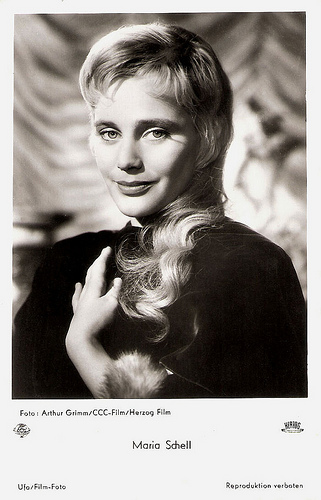
German postcard by Ufa, Berlin-Tempelhof, no. FK 3063. Photo: Arthur Grimm / CCC-Film / Herzog-Film.
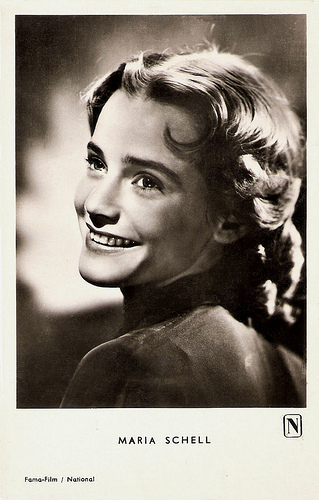
German postcard by Kunst und Bild, Berlin, no. A 038. Photo: Fama-Film / National.
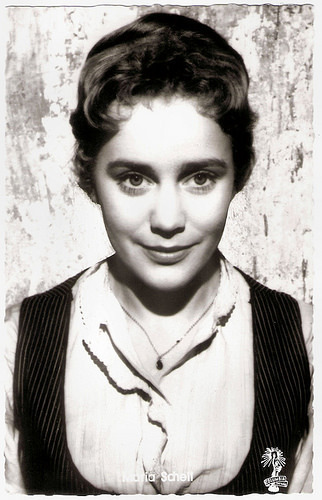
German postcard by Kolibri-Verlag, Minden/Westf., no. 2230. Photo: Columbia. Publicity still for Gervaise (René Clément, 1956).
Best roles
In 1954, Maria Schell won a Cannes Film Festival award for her dramatic portrayal of a German nurse imprisoned in wartime Yugoslavia in Die letzte Brücke/The Last Bridge (Helmut Käutner, 1954).
Two years later, she claimed a Venice Film Festival prize for her role in Gervaise (René Clément, 1956). In this adaptation of Emile Zola’s 'L’Assommoir', she played one of her best roles as a hardworking laundress surrounded by drunks.
Other important films were Robert Siodmak’s thriller Die Ratten/The Rats (1955), and Luchino Visconti ’s romantic Fyodor Dostoyevski adaptation Le notti bianche/White Nights (1957), with Schell as the young and innocent girl in love with Jean Marais but loved by Marcello Mastroianni .
Hollywood called and Maria Schell was contracted to star as Grushenka opposite Yul Brynner in The Brothers Karamazov (Richard Brooks, 1958), a messy adaptation of another classic novel by Dostoyevsky.
This was followed by roles in the Gary Cooper Western The Hanging Tree (Delmer Daves, 1959), the remake of Edna Ferber's Cimarron (Anthony Mann, 1961), and The Mark (Guy Green, 1961), opposite Academy Award nominee Stuart Whitman.
Then she returned to Germany for the family drama Das Riesenrad/The Giant Ferris Wheel (Géza von Radványi, 1961), again with O. W. Fischer .
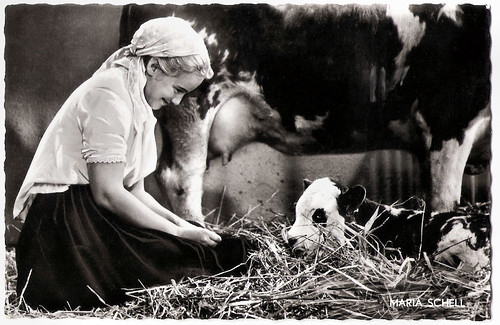
Dutch postcard by N.V. Int. Filmpers (I.F.P.), Amsterdam, no. 1075. Photo: Bavaria Filmkunst. Maria Schell in Rose Bernd/The Sins of Rose Bernd (Wolgang Staudte, 1957).
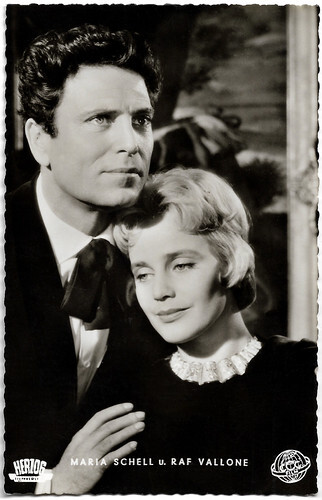
West-German postcard by Kunst und Bild, Berlin, no. V 379. Photo: Herzog-Filmverleih / CCC-Film / Arthur Grimm. Maria Schell and Raf Vallone in Liebe/Love (Horst Hächler, 1956).
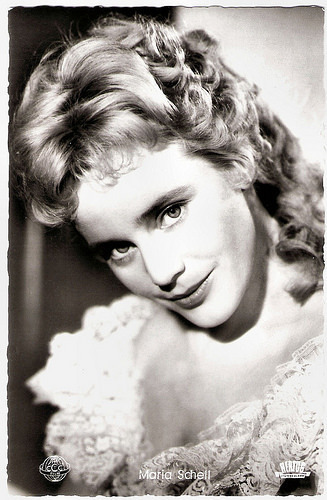
German postcard by Kolibri-Verlag, Minden/Westf., no. 1970. Photo: CCC Film / Herzog-film / Grimm. Publicity still for Liebe/Love (Horst Hächler, 1956).
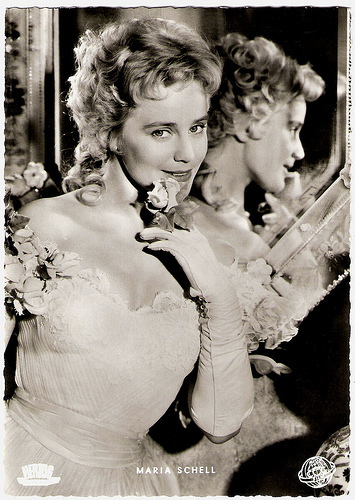
German postcard by Kunst und Bild, no F 7. Photo: CCC-Film / Herzog-Film / Grimm. Publicity still for Liebe/Love (Horst Hächler, 1956).
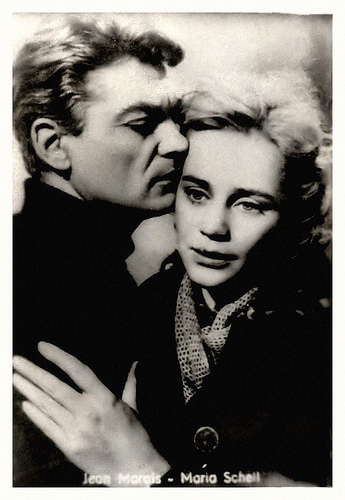
With Jean Marais . Photocard. Publicity still for Le notti bianche/ White Nights (Luchino Visconti, 1957).
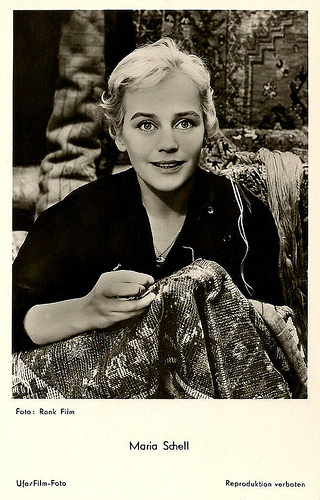
German postcard by Ufa. Photo: Rank. Still from Le notti bianche/White Nights (Luchino Visconti, 1957).
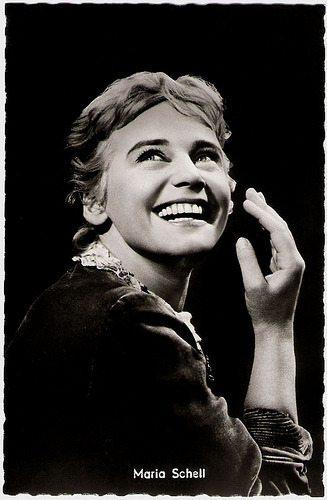
German postcard by Kolibri-Verlag G.m.b.H., Minden/Westf., no. 2754. Photo: Rank-Film. Publicity still for Le notti bianche/White Nights (Luchino Visconti, 1957).
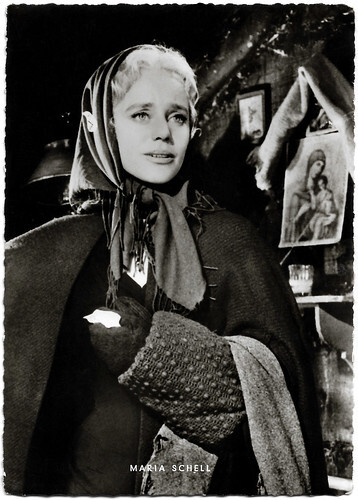
West-German postcard by IRMA-Verlag, Stuttgart, no. 1584. Photo: MGM. Maria Schell in The Brothers Karamazov (Richard Brooks, 1958).
Come-back
In 1963, dissatisfied with the diminishing value of the characters she was called upon to play, Maria Schell retired.
But in 1969 she made a come-back with the witty French comedy Le diable par la queue/The Devil By The Tail (Philippe de Broca, 1969) opposite Yves Montand .
Then followed two horror films by cult director Jesus Franco, Der Heisse Tod/ 99 Women (1969), and Il trono di fuoco/Throne of the Blood Monster (1970), starring Christopher Lee .
Among her later assignments were Voyage of the Damned (Stuart Rosenberg, 1976), Superman: The Movie (Richard Donner, 1978), Schöner Gigolo, armer Gigolo/Just A Gigolo (David Hemmings, 1978) with David Bowie and Marlene Dietrich .
On TV she portrayed the mother of Nazi architect Albert Speer ( Rutger Hauer ) in Inside the Third Reich (Marvin J. Chomsky, 1992). She also played Mother Maria in the TV sequel to Lilies of the Field called Christmas Lilies of the Field (Ralph Nelson, 1982), and she did guest appearances in popular crime series like Der Kommissar (1969-1975) starring Erik Ode, Kojak (1976) starring Telly Savalas, Derrick (1977-1978), and Tatort (1975-1996).
Besides being a film star; Maria Schell appeared in plays in Zurich, Basel, Vienna, Berlin, and Munich, at the Salzburg Festival, and she went on provincial tours from 1963.
Among the plays she performed were such classics as William Shakespeare 's 'Hamlet', Goethe's 'Faust', and modern classics such as 'Pygmalion' by George Bernard Shaw.
With her brother Maximilian Schell Maria only appeared in one film, the thriller The Odessa File (Ronald Neame, 1974).
In 2002 Maximilian made a documentary about her called Meine Schwester, Maria/My Sister, Maria, in which he documented how her mental health deteriorated along with her finances during her later years.
In 2005 Maria Schell died at age 79 of heart failure in her sleep. She was twice married, first to film director Horst Hächler and later to another film director, Veit Relin.
She was the mother of actor Oliver Schell, and of actress Marie-Therese Relin, who is married to Bavarian playwright Franz Xaver Kroetz, and has three children.
In 1974 Maria Schell was awarded the Bundesverdienstkreuz (Germany's Cross of Merit) and in 1977 the Filmband in Gold for her impressive contributions to the German cinema.
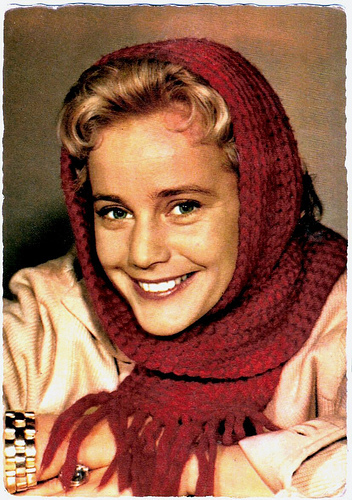
German postcard by Franz Josef Rüdel Filmpostkartenverlag, Hamburg-Bergedorf, no. FT 21. Photo: Bavaria / Schorcht / Gabriele. Publicity photo for Rose Bernd (Wolfgang Staudte, 1957).
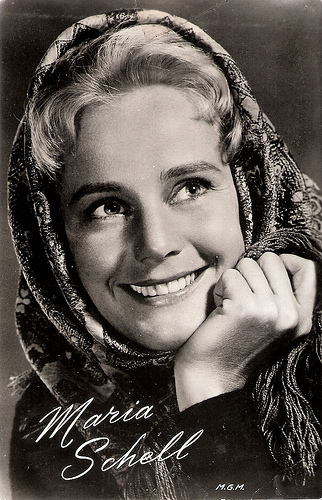
Dutch postcard by Uitg. Takken, Utrecht, no. 3752. Photo: M.G.M.
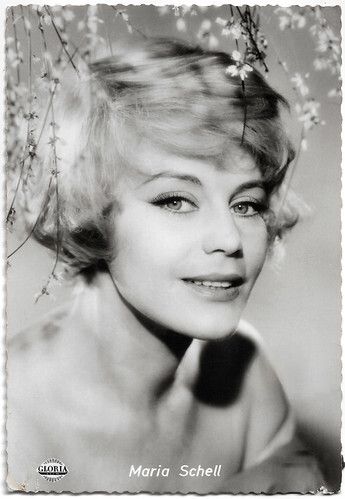
West-German postcard by Kolibri-Verlag G.m.b.H, Minden/Westf. Photo: CCC / Gloria / Arthur Grimm. Maria Schell in Das Riesenrad/The Giant Wheel (Géza von Radványi, 1961).
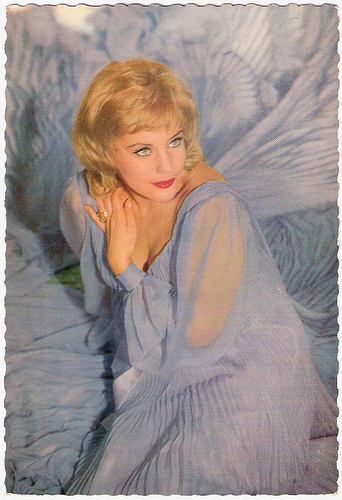
German postcard by Ufa (Universum-Film Aktiengesellschaft), Berlin-Tempelhof, no. CK 420. Retail price: 30 Pfg. Photo: Arthur Grimm / Ufa.
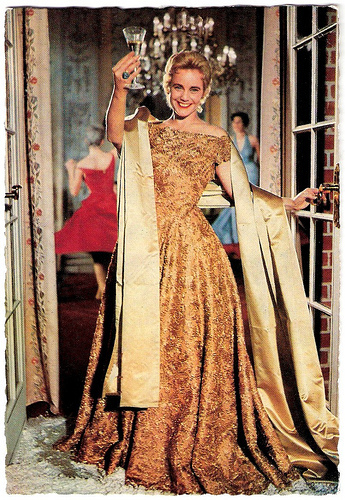
German postcard by WS Druck, Wanne-Eickel, no. F 68. Photo: Joe Niczky.
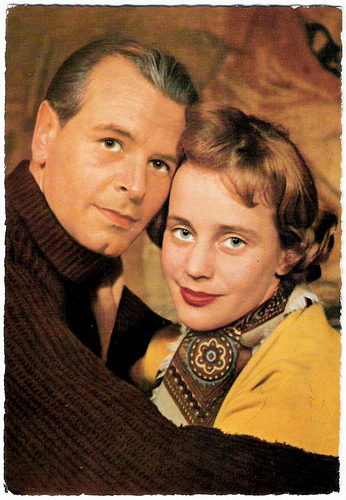
With O. W. Fischer . German postcard by WS-Druck, Wanne-Eickel, no. F 44. Photo: Klaus Collignon.
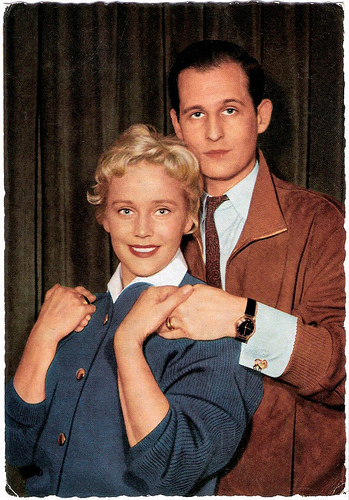
German card by WS-Druck, Wanne-Eickel, no. F 69. Photo: Ringpress. Maria Schell and director/writer/producer Horst Hächler were married from 1957 till 1965. They met during the production of Die Letzte Brücke/The Last Bridge (Helmut Käutner, 1954), for which he was the assistant director. Maria Schell played in two films directed by her husband, Liebe/Love (1957) and Raubfischer in Hellas/As the Sea Rages (1959).
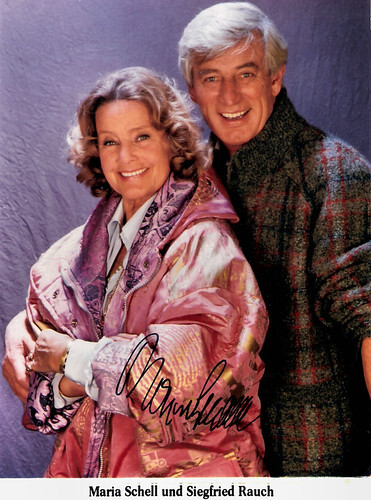
German autograph card. Maria Schell and Siegfried Rauch in the TV series Die glückliche Familie/The Happy Family (1987-1991).
The final scene from The Hanging Tree with Gary Cooper and Maria Schell. Source: Psychodad 1860 (YouTube).
Trailer for Le Notti Bianche with Maria Schell and Marcello Mastroianni . Source: The Criterion Collection (YouTube).
Maria Schell: The actress that can smile while crying. A video tribute by Yamsala (YouTube).
Sources: Stephanie D'Heil (Steffie-line), (IMDb), Hal Erickson (AllMovie), Wikipedia, and .

West-German postcard by WS-Druck, Wanne-Eickel. Photo: Schorchtfilm-Verleih. Maria Schell in Es kommt ein Tag/A Day Will Come (Rudolf Jugert, 1950).

German postcard by Kolibri-Verlag G.m.b.H., Minden/Westf., no. F 27. Retail price: 25 Pfg. Photo: Ringpress / Vogelmann.

French postcard by Editions P.I., Paris, no. 74. Photo: Ufa / Vogelmann.

German postcard by Ufa (Universum-Film Aktiengesellschaft), Berlin-Tempelhof, no. CK-75. Retail price: 30 Pfg. Photo: Columbia Film.

French postcard by Editions du Globe, Paris, no. 24. Photo: Sam Lévin.

German postcard by UFA, no. CK-225. Retail price: 30 Pfg. Photo: Sam Lévin / UFA. Collection: Geoffrey Donaldson Institute.
Escape
Margarete Schell was born in Vienna in 1926 as the daughter of the Swiss author Ferdinand Hermann Schell and Austrian actress Margarete Schell Noé. She was the older sister of the actors Immy, Carl, and Maximilian Schell .
Her family had to escape from the Nazi regime in 1938, and she received dramatic training in Zurich, Switzerland. To pay for her studies she worked as a secretary.
Billed as Gritli Schell, she made her screen debut at 16 in the Swiss-filmed drama Steibruch (Sigfrit Steiner, 1942).
It would be six years before she'd appear before the cameras again in Der Engel mit der Posaune (Karl Hartl, 1948). This Austro-German production was simultaneously filmed in an English-language version, The Angel With the Trumpet (Anthony Bushell, 1950), which brought her to the attention of international filmgoers.
In the 1950s Maria often played the sweet and innocent Mädchen in numerous Austrian and German films. She starred opposite Dieter Borsche in popular melodramas like Es kommt ein Tag/A Day Will Come (Rudolf Jugert, 1950) and Dr. Holl (Rolf Hansen, 1951).
With O.W. Fischer she formed one of the 'Dream Couples of the German cinema' in romantic melodramas like Bis wir uns wiedersehen/Till We Meet Again (Gustav Ucicky, 1952), Der träumende Mund/Dreaming Lips (Josef von Báky, 1953), and Solange Du da bist/As Long As You're Near Me (Rolf Hansen, 1953).
She also starred in British productions like The Magic Box (John Boulting, 1951) with Robert Donat , and The Heart of the Matter (George More O'Ferrall, 1953) opposite Trevor Howard .

British postcard in the Picturegoer Series, London, no. D 185. Photo: Associated British Pathé.

German postcard by Kolibri-Verlag, Minden/Westf., no. 831. Photo: NDF / Schorchtfilm.

With Dieter Borsche . German postcard by F.J. Rüdel, Filmpostkartenverlag, Hamburg-Bergedorf, no. 560. Photo: Filmaufbau Schorchfilm. Publicity still for Es komt ein Tag/A Day Will Come (Rudolf Jugert, 1950).

With Franco Andrei . German postcard by Kolibri-Verlag, no. I 103. Photo: Sohler / Magna / London-Film. Publicity still for Tagebuch einer Verliebten/The Diary of a Married Woman (Josef von Báky, 1953).

East-German postcard by Reichenbach, no. 691/56. Photo: NDF / Schorchtfilm. Maria Schell and Hardy Krüger in So lange Du da bist/As Long as You're Near Me (Harald Braun, 1953).

West-German postcard by Kolibri-Verlag, no. 1060. Photo: Inter West / Gloria / Looschen. Maria Schell and Wilhelm Borchert in Herr über Leben und Tod/Master Over Life and Death (Victor Vicas, 1955).

German postcard by Ufa, Berlin-Tempelhof, no. FK 3063. Photo: Arthur Grimm / CCC-Film / Herzog-Film.

German postcard by Kunst und Bild, Berlin, no. A 038. Photo: Fama-Film / National.

German postcard by Kolibri-Verlag, Minden/Westf., no. 2230. Photo: Columbia. Publicity still for Gervaise (René Clément, 1956).
Best roles
In 1954, Maria Schell won a Cannes Film Festival award for her dramatic portrayal of a German nurse imprisoned in wartime Yugoslavia in Die letzte Brücke/The Last Bridge (Helmut Käutner, 1954).
Two years later, she claimed a Venice Film Festival prize for her role in Gervaise (René Clément, 1956). In this adaptation of Emile Zola’s 'L’Assommoir', she played one of her best roles as a hardworking laundress surrounded by drunks.
Other important films were Robert Siodmak’s thriller Die Ratten/The Rats (1955), and Luchino Visconti ’s romantic Fyodor Dostoyevski adaptation Le notti bianche/White Nights (1957), with Schell as the young and innocent girl in love with Jean Marais but loved by Marcello Mastroianni .
Hollywood called and Maria Schell was contracted to star as Grushenka opposite Yul Brynner in The Brothers Karamazov (Richard Brooks, 1958), a messy adaptation of another classic novel by Dostoyevsky.
This was followed by roles in the Gary Cooper Western The Hanging Tree (Delmer Daves, 1959), the remake of Edna Ferber's Cimarron (Anthony Mann, 1961), and The Mark (Guy Green, 1961), opposite Academy Award nominee Stuart Whitman.
Then she returned to Germany for the family drama Das Riesenrad/The Giant Ferris Wheel (Géza von Radványi, 1961), again with O. W. Fischer .

Dutch postcard by N.V. Int. Filmpers (I.F.P.), Amsterdam, no. 1075. Photo: Bavaria Filmkunst. Maria Schell in Rose Bernd/The Sins of Rose Bernd (Wolgang Staudte, 1957).

West-German postcard by Kunst und Bild, Berlin, no. V 379. Photo: Herzog-Filmverleih / CCC-Film / Arthur Grimm. Maria Schell and Raf Vallone in Liebe/Love (Horst Hächler, 1956).

German postcard by Kolibri-Verlag, Minden/Westf., no. 1970. Photo: CCC Film / Herzog-film / Grimm. Publicity still for Liebe/Love (Horst Hächler, 1956).

German postcard by Kunst und Bild, no F 7. Photo: CCC-Film / Herzog-Film / Grimm. Publicity still for Liebe/Love (Horst Hächler, 1956).

With Jean Marais . Photocard. Publicity still for Le notti bianche/ White Nights (Luchino Visconti, 1957).

German postcard by Ufa. Photo: Rank. Still from Le notti bianche/White Nights (Luchino Visconti, 1957).

German postcard by Kolibri-Verlag G.m.b.H., Minden/Westf., no. 2754. Photo: Rank-Film. Publicity still for Le notti bianche/White Nights (Luchino Visconti, 1957).

West-German postcard by IRMA-Verlag, Stuttgart, no. 1584. Photo: MGM. Maria Schell in The Brothers Karamazov (Richard Brooks, 1958).
Come-back
In 1963, dissatisfied with the diminishing value of the characters she was called upon to play, Maria Schell retired.
But in 1969 she made a come-back with the witty French comedy Le diable par la queue/The Devil By The Tail (Philippe de Broca, 1969) opposite Yves Montand .
Then followed two horror films by cult director Jesus Franco, Der Heisse Tod/ 99 Women (1969), and Il trono di fuoco/Throne of the Blood Monster (1970), starring Christopher Lee .
Among her later assignments were Voyage of the Damned (Stuart Rosenberg, 1976), Superman: The Movie (Richard Donner, 1978), Schöner Gigolo, armer Gigolo/Just A Gigolo (David Hemmings, 1978) with David Bowie and Marlene Dietrich .
On TV she portrayed the mother of Nazi architect Albert Speer ( Rutger Hauer ) in Inside the Third Reich (Marvin J. Chomsky, 1992). She also played Mother Maria in the TV sequel to Lilies of the Field called Christmas Lilies of the Field (Ralph Nelson, 1982), and she did guest appearances in popular crime series like Der Kommissar (1969-1975) starring Erik Ode, Kojak (1976) starring Telly Savalas, Derrick (1977-1978), and Tatort (1975-1996).
Besides being a film star; Maria Schell appeared in plays in Zurich, Basel, Vienna, Berlin, and Munich, at the Salzburg Festival, and she went on provincial tours from 1963.
Among the plays she performed were such classics as William Shakespeare 's 'Hamlet', Goethe's 'Faust', and modern classics such as 'Pygmalion' by George Bernard Shaw.
With her brother Maximilian Schell Maria only appeared in one film, the thriller The Odessa File (Ronald Neame, 1974).
In 2002 Maximilian made a documentary about her called Meine Schwester, Maria/My Sister, Maria, in which he documented how her mental health deteriorated along with her finances during her later years.
In 2005 Maria Schell died at age 79 of heart failure in her sleep. She was twice married, first to film director Horst Hächler and later to another film director, Veit Relin.
She was the mother of actor Oliver Schell, and of actress Marie-Therese Relin, who is married to Bavarian playwright Franz Xaver Kroetz, and has three children.
In 1974 Maria Schell was awarded the Bundesverdienstkreuz (Germany's Cross of Merit) and in 1977 the Filmband in Gold for her impressive contributions to the German cinema.

German postcard by Franz Josef Rüdel Filmpostkartenverlag, Hamburg-Bergedorf, no. FT 21. Photo: Bavaria / Schorcht / Gabriele. Publicity photo for Rose Bernd (Wolfgang Staudte, 1957).

Dutch postcard by Uitg. Takken, Utrecht, no. 3752. Photo: M.G.M.

West-German postcard by Kolibri-Verlag G.m.b.H, Minden/Westf. Photo: CCC / Gloria / Arthur Grimm. Maria Schell in Das Riesenrad/The Giant Wheel (Géza von Radványi, 1961).

German postcard by Ufa (Universum-Film Aktiengesellschaft), Berlin-Tempelhof, no. CK 420. Retail price: 30 Pfg. Photo: Arthur Grimm / Ufa.

German postcard by WS Druck, Wanne-Eickel, no. F 68. Photo: Joe Niczky.

With O. W. Fischer . German postcard by WS-Druck, Wanne-Eickel, no. F 44. Photo: Klaus Collignon.

German card by WS-Druck, Wanne-Eickel, no. F 69. Photo: Ringpress. Maria Schell and director/writer/producer Horst Hächler were married from 1957 till 1965. They met during the production of Die Letzte Brücke/The Last Bridge (Helmut Käutner, 1954), for which he was the assistant director. Maria Schell played in two films directed by her husband, Liebe/Love (1957) and Raubfischer in Hellas/As the Sea Rages (1959).

German autograph card. Maria Schell and Siegfried Rauch in the TV series Die glückliche Familie/The Happy Family (1987-1991).
The final scene from The Hanging Tree with Gary Cooper and Maria Schell. Source: Psychodad 1860 (YouTube).
Trailer for Le Notti Bianche with Maria Schell and Marcello Mastroianni . Source: The Criterion Collection (YouTube).
Maria Schell: The actress that can smile while crying. A video tribute by Yamsala (YouTube).
Sources: Stephanie D'Heil (Steffie-line), (IMDb), Hal Erickson (AllMovie), Wikipedia, and .
Published on August 31, 2022 22:00
August 30, 2022
Zita Szeleczky
Beautiful Zita Szeleczky (1915-1999) was a Hungarian stage and film actress who peaked in Hungarian cinema and in the late 1930s and early 1940s. From 1936 to 1944 she starred in 26 Hungarian films, mostly musical comedies.
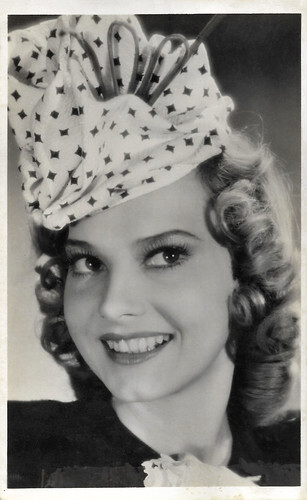
Hungarian postcard by Filmbolt. Photo: Z. Horvath-Imago Film. Zita Szeleczky in Leányvásár (1941).
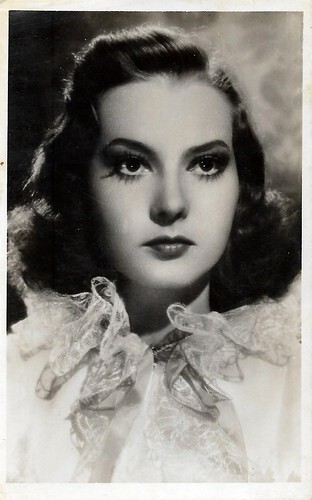
Hungarian postcard by Filmbolt. Photo: Hunnia-Takacs Film. Zita Szeleczky in Egy éjszaka Erdélyben/A Night in Transylvania (Frigyes Bán, 1941).
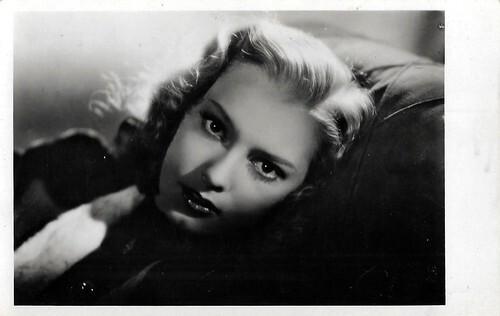
Hungarian postcard by Magyar Filmiroda. Photo: Bethlen Gabor/Colosseum-Atelier-film. Zita Szeleczky in Tentazione (1942).
Leading in 26 Hungarian films
Zita Szeleczky was born Szeleczky Zita Klára Terézia in Nekézseny, Hungary, in 1915 as the daughter of Manó Szeleczky (Emmánuel) and Amália Négyessy.
She graduated from the Veres Pálné Gymnasium in Budapest in 1933 and from the Academy of Drama in 1937. She became a scholarship holder and then a full member of the National Theatre (1936-1941).
In addition to Hungarian plays, Szeleczky acted in plays by William Shakespeare ('Romeo and Juliet'), Molière ('Tartuffe'), Henrik Ibsen ('Rosmersholm', 'Peer Gynt'), Dario Niccodemi, and Luigi Pirandello.
From 1936 to 1944 Zita Szeleczky played the leading female roles in 26 Hungarian films, mostly musical comedies. She also became a regular at Hungary’s Nazi rallies and was the darling of the Arrow Cross. Szelecky started her film career with Bela Balogh's Méltóságos kisasszony/The Superior Mother (Bela Balogh, 1936-1937).
She followed her debut with such films as Fekete gyémántok/Black Diamonds (Ladislao Vajda, 1938) with Pál Jávor , Azurexpress/Azure Express (Bela Balogh, 1938) with Antal Pager, and Beszállásolás/Billeting (Sándor Szlatinay, 1938) again with Pager. The latter was screened at the Venice Film Festival.
With Javor and Pager, she starred in A varieté csillagai/Stars of Variety, the alternate Hungarian language version of Menschen vom Variete (Josef von Báky, 1939). Then she appeared in Karosszék/The Armchair (Béla Balogh, Kálmán Nádasdy, 1939) with Gábor Rajnay and László Szilassy, and the historical comedy Egy éjszaka Erdélyben/A Night in Transylvania (Frigyes Bán, 1941) with Pager.
In 1942 she starred in one Italian film, Tentazione/Temptation by Aldo Frosi and Hans Hinrich, with Otello Toso in the male lead. Szeleczky's last fiction film in Hungary during the war was Nászinduló/The Wedding March (Zoltán Farkas, 1944) with László Szilassy.
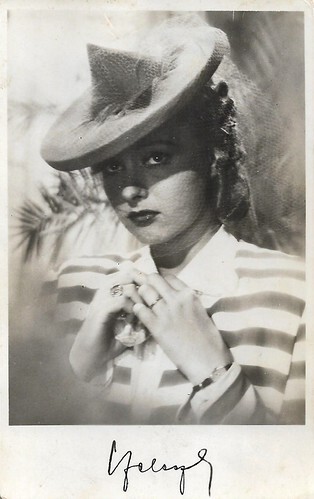
Hungarian postcard by Magyar Filmiroda, Budapest, no. 6218. Photo: Bethlen Gabor. Zita Szeleczky in Karosszék (1939).
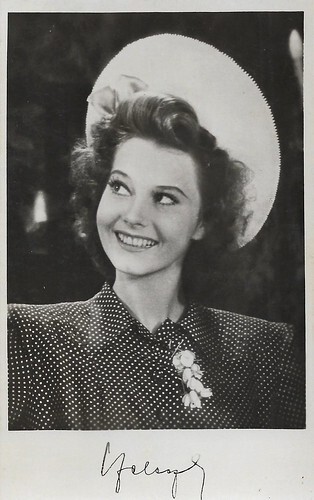
Hungarian postcard by Magyar Filmiroda, no. 6353. Photo: Bethlen Gabor.
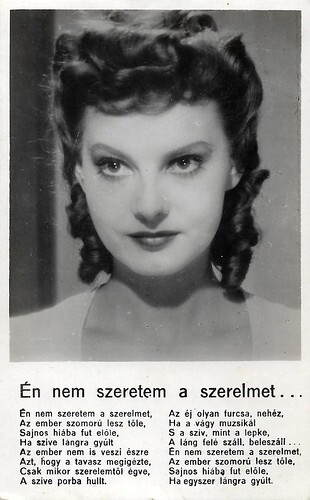
Hungarian postcard by NIF Palatinus / Filmbolt. Zita Szeleczky in Karosszék (Béla Balogh, Kálmán Nádasdy, 1939). The caption translates 'I don't like love'.
A Hungarist Evening
On 8 June 1940, Zita Szeleczky married Gyula Haltenberger, a mechanical engineer three years her senior and a sympathiser of the fascist movement and the Szálasi-regime. In 1942-1943, she was engaged by the Budapest Operetta Theatre.
In early 1944, she made a guest appearance at the Madách Theatre. On 16 April 1945, the Budapest daily A Reggel reported that she had committed suicide in Sopron. Gyula Haltenberger, who was arrested by the political department of the Buda police, confirmed this information, which later proved to be a fake.
In 1945, Szeleczky left the country and was convicted in absentia by the People's Court for her wartime behaviour, among other things because in November 1944, in the context of a so-called "Hungarist Evening", she recited a Petőfi poem entitled "Up to the Holy War!", which was broadcast by Hungarian Radio.
She first lived in Austria and Italy, then moved to Argentina in 1948, where she initially performed in the Hungarian Dramatic Society . She also played a supporting part in the Argentine film Vivir un instante/Julia (Tulio Demicheli, 1951) under the stage name Diana Toldy. It was her final film.
Between 1949 and 1974, she visited Hungarian communities all over the world with her own shows. She did operettas, poetry recitals and variety shows.
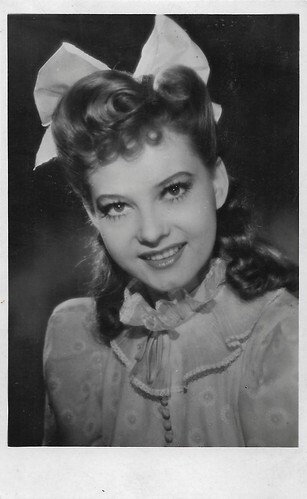
Hungarian postcard by Filmbolt, no. A.149. Photo: Kárpát-Film. Zita Szeleczky in Eladó birtok (1941).
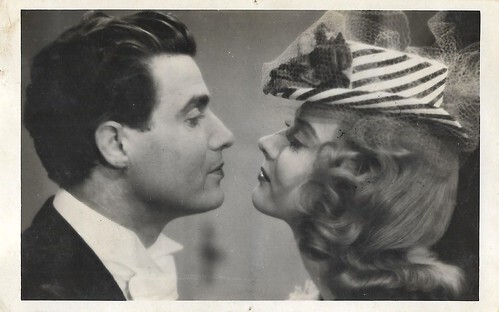
Hungarian postcard by Filmbolt, no. A.180. Photo: Terra Film. Zita Szeleczky and Janos Sardy in Leányvásár (1941).
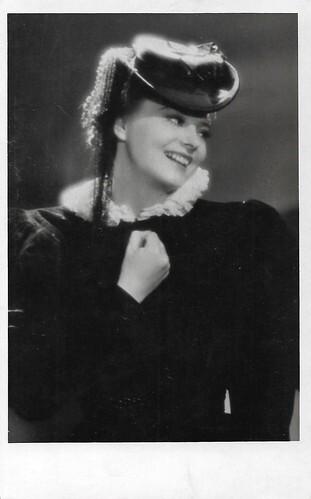
Hungarian postcard by Filmbolt, no. A.279. Photo: Kárpát-Film. Zita Szeleczky in Eladó birtok (1941).
Full rehabilitation
In 1962, Zita Szeleczky moved to the United States, where she married an American of Hungarian origin, Paul Illés. The marriage didn’t last, but she could stay in California. In the US, she almost immediately made contact with novelist Albert Wass. Their correspondence reveals that they subsequently worked closely together in the service of the universal Hungarian cause.
She also released several recordings. While with her attractive looks, stage presence, and intelligent and natural acting, she portrayed young girls, lyrical heroines and naïve women in her short career in Hungary, she expanded her performing activities in emigration into a cultural mission.
In 1974 she married an Australian actor, Sándor Novák. That marriage did not last either. In the autumn of 1988, she returned to her homeland and lived in Érd. In 1993, the Supreme Court acquitted her of trumped-up charges from 1947 and granted her full rehabilitation. Later that year, together with Albert Wass, she was awarded the Order of Merit of the Republic of Hungary.
Zita Szeleczky died on 12 July 1999, aged 84, childless. In accordance with her will, she was laid to rest in the family crypt in Nekézseny. In 2007 she was awarded the Hungarian Heritage Award posthumously. The Hungarian Postal Service issued a stamp commemorating the 100th anniversary of Szeleczky in 2015.
György Lázár, a Hungarian emigrant in the USA, writes on the site Hungarian Free Press that he was disturbed that the Hungarian Postal Service issued the stamp. He writes that Szeleczky's support of Hungarian fascism was "nothing less than shameful" and blames the actress for her involvement in the Hungarista movement. Lázár thinks that the stamp is "another example of the Orbán Government’s relentless drive to whitewash wartime fascists and rewrite history". However, Szeleczky saw herself as an entertainer who strove to boost the morale of the troops, performing at the front and in hospitals for the wounded soldiers.
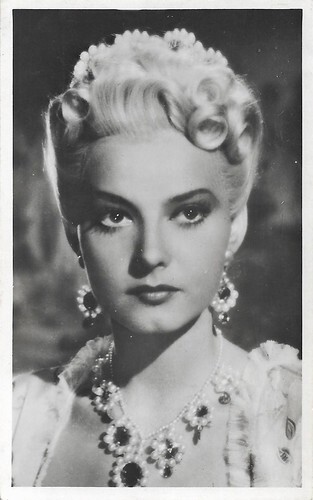
Hungarian postcard by Magyar Filmiroda. Photo: Bethlen Gabor. Zita Szeleczky in Egy éjszaka Erdélyben/A Night in Transylvania (1941).
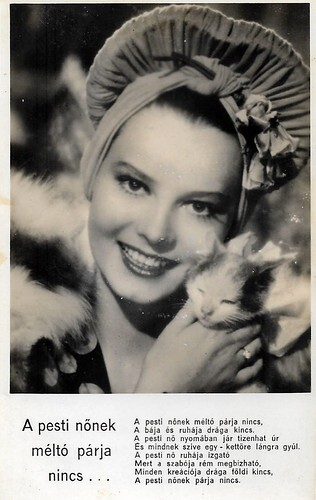
Hungarian postcard by Ed. Tempo Budapest. Zita Szeleczky in Sziámi macska (László Kalmár, 1943). The caption translates as 'The women of Pest don't have a partner.'
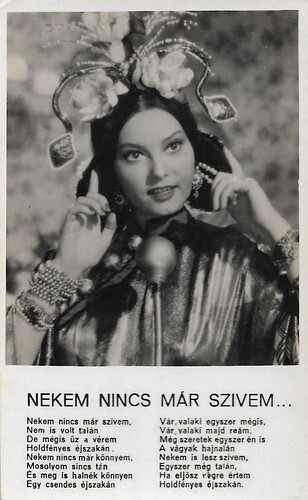
Hungarian postcard by Ed. Tempo, Budapest. Zita Szeleczky in Sziámi macska (1943). The caption translates as 'I no longer have a heart...'.
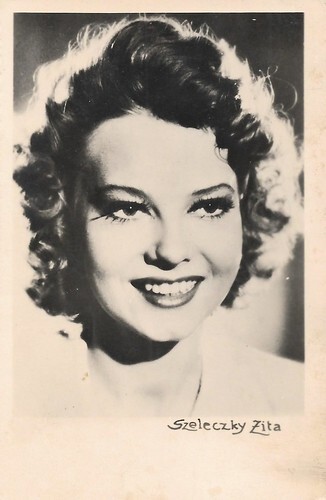
Hungarian postcard.
Sources: György Lázár (Hungarian Free Press), Wikipedia (Hungarian and English), and .

Hungarian postcard by Filmbolt. Photo: Z. Horvath-Imago Film. Zita Szeleczky in Leányvásár (1941).

Hungarian postcard by Filmbolt. Photo: Hunnia-Takacs Film. Zita Szeleczky in Egy éjszaka Erdélyben/A Night in Transylvania (Frigyes Bán, 1941).

Hungarian postcard by Magyar Filmiroda. Photo: Bethlen Gabor/Colosseum-Atelier-film. Zita Szeleczky in Tentazione (1942).
Leading in 26 Hungarian films
Zita Szeleczky was born Szeleczky Zita Klára Terézia in Nekézseny, Hungary, in 1915 as the daughter of Manó Szeleczky (Emmánuel) and Amália Négyessy.
She graduated from the Veres Pálné Gymnasium in Budapest in 1933 and from the Academy of Drama in 1937. She became a scholarship holder and then a full member of the National Theatre (1936-1941).
In addition to Hungarian plays, Szeleczky acted in plays by William Shakespeare ('Romeo and Juliet'), Molière ('Tartuffe'), Henrik Ibsen ('Rosmersholm', 'Peer Gynt'), Dario Niccodemi, and Luigi Pirandello.
From 1936 to 1944 Zita Szeleczky played the leading female roles in 26 Hungarian films, mostly musical comedies. She also became a regular at Hungary’s Nazi rallies and was the darling of the Arrow Cross. Szelecky started her film career with Bela Balogh's Méltóságos kisasszony/The Superior Mother (Bela Balogh, 1936-1937).
She followed her debut with such films as Fekete gyémántok/Black Diamonds (Ladislao Vajda, 1938) with Pál Jávor , Azurexpress/Azure Express (Bela Balogh, 1938) with Antal Pager, and Beszállásolás/Billeting (Sándor Szlatinay, 1938) again with Pager. The latter was screened at the Venice Film Festival.
With Javor and Pager, she starred in A varieté csillagai/Stars of Variety, the alternate Hungarian language version of Menschen vom Variete (Josef von Báky, 1939). Then she appeared in Karosszék/The Armchair (Béla Balogh, Kálmán Nádasdy, 1939) with Gábor Rajnay and László Szilassy, and the historical comedy Egy éjszaka Erdélyben/A Night in Transylvania (Frigyes Bán, 1941) with Pager.
In 1942 she starred in one Italian film, Tentazione/Temptation by Aldo Frosi and Hans Hinrich, with Otello Toso in the male lead. Szeleczky's last fiction film in Hungary during the war was Nászinduló/The Wedding March (Zoltán Farkas, 1944) with László Szilassy.

Hungarian postcard by Magyar Filmiroda, Budapest, no. 6218. Photo: Bethlen Gabor. Zita Szeleczky in Karosszék (1939).

Hungarian postcard by Magyar Filmiroda, no. 6353. Photo: Bethlen Gabor.

Hungarian postcard by NIF Palatinus / Filmbolt. Zita Szeleczky in Karosszék (Béla Balogh, Kálmán Nádasdy, 1939). The caption translates 'I don't like love'.
A Hungarist Evening
On 8 June 1940, Zita Szeleczky married Gyula Haltenberger, a mechanical engineer three years her senior and a sympathiser of the fascist movement and the Szálasi-regime. In 1942-1943, she was engaged by the Budapest Operetta Theatre.
In early 1944, she made a guest appearance at the Madách Theatre. On 16 April 1945, the Budapest daily A Reggel reported that she had committed suicide in Sopron. Gyula Haltenberger, who was arrested by the political department of the Buda police, confirmed this information, which later proved to be a fake.
In 1945, Szeleczky left the country and was convicted in absentia by the People's Court for her wartime behaviour, among other things because in November 1944, in the context of a so-called "Hungarist Evening", she recited a Petőfi poem entitled "Up to the Holy War!", which was broadcast by Hungarian Radio.
She first lived in Austria and Italy, then moved to Argentina in 1948, where she initially performed in the Hungarian Dramatic Society . She also played a supporting part in the Argentine film Vivir un instante/Julia (Tulio Demicheli, 1951) under the stage name Diana Toldy. It was her final film.
Between 1949 and 1974, she visited Hungarian communities all over the world with her own shows. She did operettas, poetry recitals and variety shows.

Hungarian postcard by Filmbolt, no. A.149. Photo: Kárpát-Film. Zita Szeleczky in Eladó birtok (1941).

Hungarian postcard by Filmbolt, no. A.180. Photo: Terra Film. Zita Szeleczky and Janos Sardy in Leányvásár (1941).

Hungarian postcard by Filmbolt, no. A.279. Photo: Kárpát-Film. Zita Szeleczky in Eladó birtok (1941).
Full rehabilitation
In 1962, Zita Szeleczky moved to the United States, where she married an American of Hungarian origin, Paul Illés. The marriage didn’t last, but she could stay in California. In the US, she almost immediately made contact with novelist Albert Wass. Their correspondence reveals that they subsequently worked closely together in the service of the universal Hungarian cause.
She also released several recordings. While with her attractive looks, stage presence, and intelligent and natural acting, she portrayed young girls, lyrical heroines and naïve women in her short career in Hungary, she expanded her performing activities in emigration into a cultural mission.
In 1974 she married an Australian actor, Sándor Novák. That marriage did not last either. In the autumn of 1988, she returned to her homeland and lived in Érd. In 1993, the Supreme Court acquitted her of trumped-up charges from 1947 and granted her full rehabilitation. Later that year, together with Albert Wass, she was awarded the Order of Merit of the Republic of Hungary.
Zita Szeleczky died on 12 July 1999, aged 84, childless. In accordance with her will, she was laid to rest in the family crypt in Nekézseny. In 2007 she was awarded the Hungarian Heritage Award posthumously. The Hungarian Postal Service issued a stamp commemorating the 100th anniversary of Szeleczky in 2015.
György Lázár, a Hungarian emigrant in the USA, writes on the site Hungarian Free Press that he was disturbed that the Hungarian Postal Service issued the stamp. He writes that Szeleczky's support of Hungarian fascism was "nothing less than shameful" and blames the actress for her involvement in the Hungarista movement. Lázár thinks that the stamp is "another example of the Orbán Government’s relentless drive to whitewash wartime fascists and rewrite history". However, Szeleczky saw herself as an entertainer who strove to boost the morale of the troops, performing at the front and in hospitals for the wounded soldiers.

Hungarian postcard by Magyar Filmiroda. Photo: Bethlen Gabor. Zita Szeleczky in Egy éjszaka Erdélyben/A Night in Transylvania (1941).

Hungarian postcard by Ed. Tempo Budapest. Zita Szeleczky in Sziámi macska (László Kalmár, 1943). The caption translates as 'The women of Pest don't have a partner.'

Hungarian postcard by Ed. Tempo, Budapest. Zita Szeleczky in Sziámi macska (1943). The caption translates as 'I no longer have a heart...'.

Hungarian postcard.
Sources: György Lázár (Hungarian Free Press), Wikipedia (Hungarian and English), and .
Published on August 30, 2022 22:00
August 29, 2022
Directed by Louis Feuillade
Louis Feuillade (1873-1925) was a pioneering French film director best known for his internationally popular film serials Fantômas (1913-1914), Les Vampires (1915-1916) and Judex (1916). His serials were the most influential French films of the period around World War I. With his crowd-pleasing productions, Feuillade made Gaumont the second largest French film studio after Pathé Frères. In total, he made around 800 films for Gaumont, of which around eighty per cent are lost.
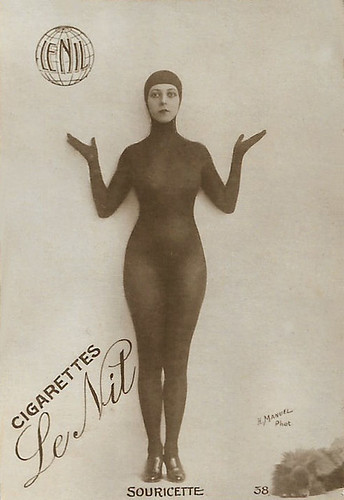
French cigarette card by Cigarettes Le Nil, no. 38. Photo: H. Manuel. Musidora as Irma Vep.
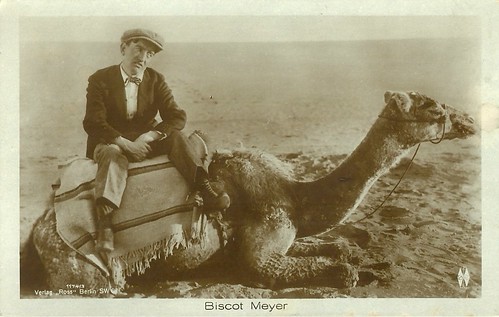
German postcard by Ross Verlag, Berlin, no. 1174/3, 1927-1928. Georges Biscot , presented in Germany as 'Biscot Meyer', in L'orpheline/The orphan (Louis Feuillade, 1921).
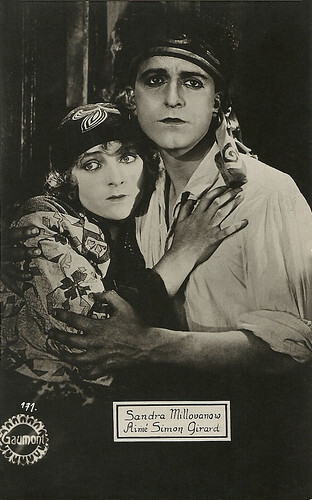
French Postcard, no. 171. Photo: Gaumont. Sandra Milowanoff and Aimé Simon-Girard in Le fils du filibustier/The Son of the Pirate (Louis Feuillade, 1922). Collection: Didier Hanson.
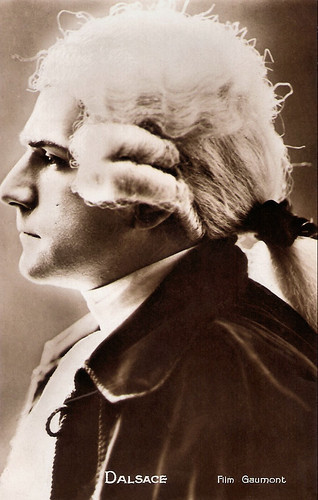
French postcard. Photo: Film Gaumont. Lucien Dalsace in Vindicta (Louis Feuillade, 1923).
The leading director of early French cinema
Louis Jean Feuillade was born in 1873 in Lunel in the Languedoc, France. He was the son of Barthélémy Feuillade, a modest wine merchant, and Marie Avesque. The young Louis quickly showed a taste for literature. He wrote numerous plays, dramas and vaudevilles, and published poems in the local press. He was trained as a journalist, but Feuillade first worked with his father and brother in the family wine shop and had his literary ambitions on the side. In 1898, after the death of his parents, he left the family business in the hands of his brother and went to Paris where he started as a journalist for the daily newspaper La Croix.
Feuillade managed to have a few plays performed, such as 'Le Clos', a verse play presented in Béziers in 1905, of which he was the co-author. The same year he presented a few scripts to Gaumont, a company originally focused on photography, but which was developing cinematographic ambitions. Alice Guy , the artistic director at Gaumont and also the first female director in the history of cinema, commissioned him to write his first screenplays in 1905.
Soon Feuillade became Guy's regular scriptwriter. After her marriage to the later director and producer Herbert Blaché in 1907, Alice Guy went to Berlin and later to New York. She suggested to Léon Gaumont that Feuillade be appointed artistic director. From 1 April 1907, he was responsible for the artistic choices of the French film company whose ambition was to compete with Pathé. Louis Feuillade would hold this position - in Paris until 1918, then in Nice - until his death.
Feuillade had the opportunity to direct films himself. In 1906, he breathed life into Alice Guy 's ideas for short bullfighting films with Course de taureaux à Nîmes (Alice Guy, Louis Feuillade, 1906) with passes of the toreador Machaquito, shot in the Nîmes amphitheatre. His first personal film was the comedy C'est papa qui prend la purge/It was Dad who took the purge (1907). In 1910, to counterbalance Le Film d'art known for L'assassinat du duc de Guise/The Assassination of the Duke of Guise (André Calmettes, Charles Le Bargy, 1908), Louis Feuillade promoted the Gaumont series 'Le Film Esthétique', for which he directed religious works, Le Pater/The Lord's Prayer (1910), Les sept péchés capitaux/The Seven Deadly Sins (1910), La nativité/The Nativity (1910), and stories inspired by Greco-Roman civilisation. However, this attempt at 'high-brow' cinema was financially unsuccessful.
Instead, Feuillade became known in France with the serial film series La vie telle qu'elle est/Life as It Is (1911), a more realistic but somewhat melodramatic depiction of contemporary life. He often filmed with children and established them as series stars, including Clément Mary alias Bébé (more than 70 episodes, 1910-1913) and René Poyen alias Bout-de-Zan (more than 50 episodes, 1912-1916). Feuillade was a jack-of-all-trades. He made trick films, comedies, ancient dramas, bible films, exotic adventure films and police films. He brought naturalness to film and would become the leading director of early French cinema, especially with serials about criminals and detectives with realistic, sometimes even surrealistic backgrounds.
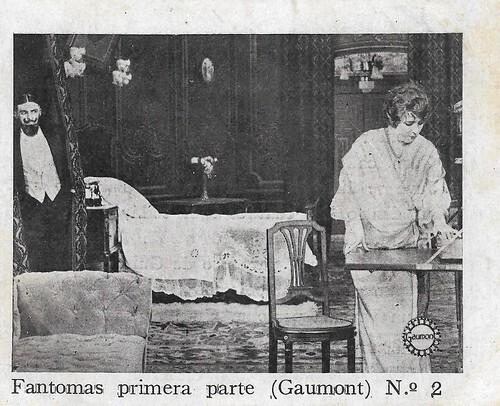
Spanish minicard series by Reclam Films, Mallorca, first episode, card 2 of 6. Photo: Gaumont. René Navarre and Jane Faber in Fantômas (Louis Feuillade, 1913). With a fake beard, Fantômas ( René Navarre ) observes Princess Danidoff (Jane Faber) in her hotel suite. He will rob her of her pearls and money and leave her a business card that only afterwards reveals its name: Fantômas.
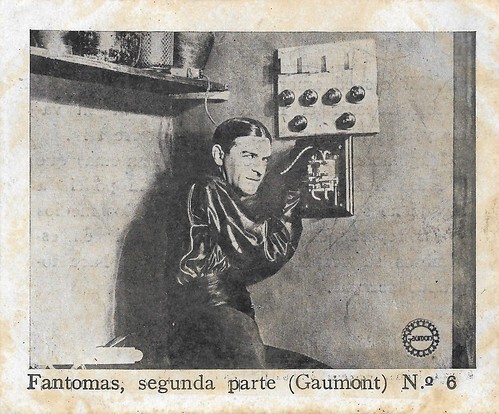
Spanish minicards (collectors' cards). Reclam Films, Mallorca. René Navarre as Fantomas in a scene from the serial Fantomas, second series, Juve versus Fantômas/ Juve contre Fantômas (Louis Feuillade, Gaumont, 1913), card no. 6. Fantomas aka The Man in Black dynamites the villa in which Juve and Fandor are.
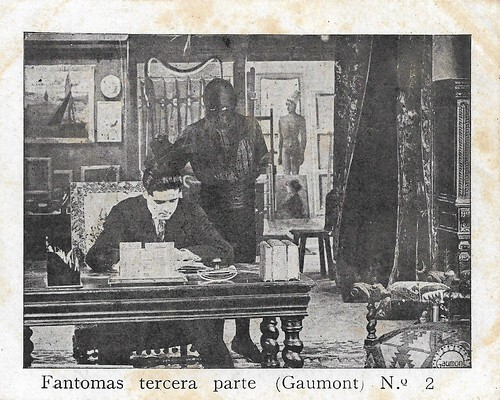
Spanish minicard by Reclam Films, Mallorca. Photo: Gaumont. Scene from the third episode of the French silent crime serial Fantomas, Le Mort qui tue (Louis Feuillade, Gaumont 1913). Fantomas ( René Navarre ), dressed as the Black Man, is about to chloroform the painter Jacques Dollon ( André Luguet ).
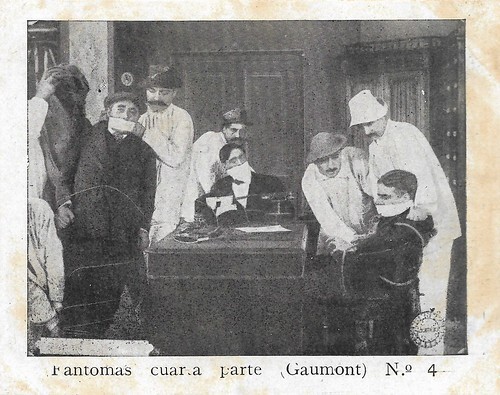
Spanish minicard by Reclam Films, Mallorca, card 4 of 6. Photo: Gaumont. Scene from Fantômas contre Fantômas (Louis Feuillade, G1914), the fourth episode of the serial Fantomas. Fantomas' gang, dressed as workmen, tie up the policemen, including the juge d'instruction Fuselier, and kidnap Juve (Edmund Breon).
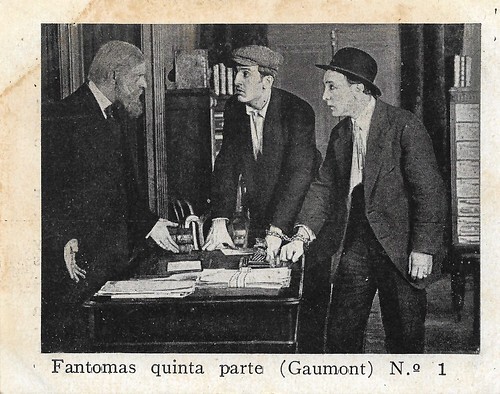
Spanish minicard by Reclam Films, Mallorca, card 1 of 6. Photo: Gaumont. René Navarre in Le faux magistrat (Louis Feuillade, 1914), the fifth episode of the serial Fantomas. Pretending to be judge Pradier, Fantômas ( René Navarre ) orders the arrested gang members Paulet and L'Elève to make sure Juve will be killed.
A seductive and disturbing incarnation of the forces of evil
In 1913, Louis Feuillade adapted Marcel Allain and Pierre Souvestre's novel Fantômas for the big screen. The film serial Fantômas - À l'ombre de la guillotine/Fantomas (1913-1914) about the mysterious criminal Fantômas starring René Navarre made the hero of the successful detective novel series even more popular. Its swift-moving, intricate plot features a series of thrilling episodes involving clever disguises, trapdoors, kidnappings, hairbreadth escapes, and rooftop chases. René Navarre transformed into a crime emperor, while Georges Melchior was the journalist Fandor and Edmond Bréon the inspector Juve. Audiences were thrilled and kept coming back for more. The success was phenomenal. Five episodes were made: Fantômas (1913), Juve Contre Fantômas/Juve Against Fantomas (1913), Le Mort qui tue/The Dead Man Who Killed (1913), Fantômas contre Fantômas/Fantomas Against Fantomas (1914) and Le Faux Magistrat/The False Magistrate (1914).
Fantômas established Feuillade's popularity in both France and the United States. Then Pathé announced the French presentation of the episodic film Les Mystères de New York/The Exploits of Elaine (Louis J. Gasnier, George B. Seitz, Leopold Wharton, Theodore Wharton, 1914) presented in the form of a cine-novel: the public read the serial in the press before going to see the film in theatres. Gaumont's answer was Les Vampires/The Vampires (1915-1916), a ten-part series about the criminal organisation Les Vampires. Feuillade needed an actress capable of competing with Pearl White . He chose Musidora , who had been working with him since the previous year. She became Irma Vep, the muse of the mysterious 'Vampires' gang. Dressed in a tight-fitting black full-body suit, Irma Vep is a seductive and disturbing incarnation of the forces of evil. The lead actor, Édouard Mathé , replaced Navarre in the cast. As reporter Philippe Guérande, he struggles against these dark forces with the help of a repentant 'vampire', Mazamette, played by comedian Marcel Lévesque.
Les Vampires/The Vampires consists of 10 episodes presented over as many consecutive weeks. The film serial thrilled contemporary audiences not least because of the appearance of Musidora . The Surrealists were so fascinated by Feuillades' crime serials that Max Jacob founded a 'Société des Amis de Fantômas', which the entire group promptly joined. The characters Fantômas and Irma Vep, the femme fatale and strategist of crime embodied by Musidora from Les Vampires/The Vampires, are encountered in the collages of Max Ernst, poems by Paul Éluard and Robert Desnos (set to music by Kurt Weill) and films by Jean Cocteau. The motif of transformation and disguise is omnipresent in Surrealist cinema.
Feuillade then shot another very popular serial, Judex (12 episodes, 1916). He cast the actor René Cresté as the positive hero of the film series Judex, of which a sequel was made under the title La nouvelle mission de Judex/The New Mission of Judex (12 episodes, 1916-1917). Cresté played a daring detective with a sweeping black cape, a righter of wrongs who was the prototype of many future film heroes. The tremendous success of the |Judex series saved the French film industry, which had been threatened by competition from foreign imports.
René Cresté also appeared in two less-known Feuillade serials: Tih Minh (12 episodes, 1918) and Vendémiaire (1918). Especially Tih Minh with the exotic Hong Kong-born British actress Mary Harald is aesthetically pleasing. In Vendémiaire (1919), a hymn to the vine as a source of life and a return to the origins of the Hérault region, Louis Feuillade portrays an officer who has become blind as a result of a wound in battle and who takes in refugees from the First World War on his property. Feuillade's last crime serial was Barrabas (1919), with the veteran Gaston Michel in the role of the master criminal. Georges Biscot took over from Marcel Lévesque as the comic sidekick.
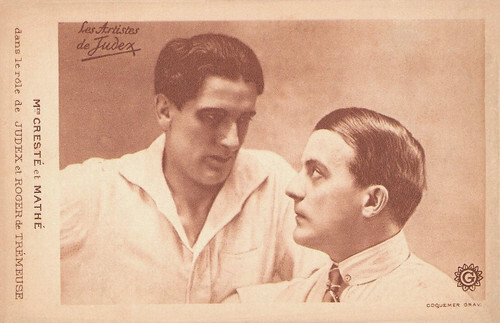
French postcard by Coquemer Gravures, Paris. Photo: Gaumont. René Cresté as Judex and Edouard Mathé in La nouvelle mission de Judex (Louis Feuillade 1917-1918).
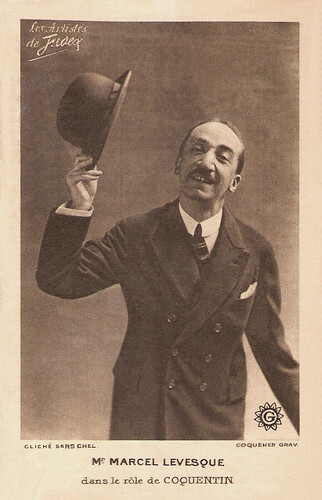
French postcard by Coquemer Gravures, Paris. Photo: Gerschel / Gaumont. Marcel Levesque in the role of Coquentin in La nouvelle mission de Judex (Louis Feuillade, 1917-1918).
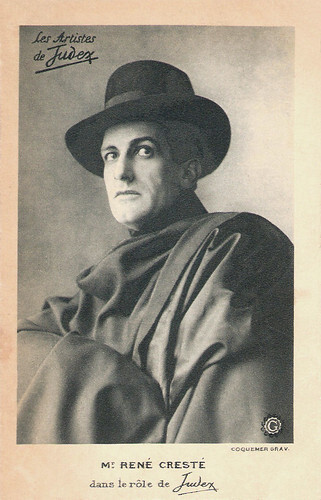
French postcard by Coquemer Gravures. Photo: Gaumont. René Cresté as Judex in La nouvelle mission de Judex (1917-1918).
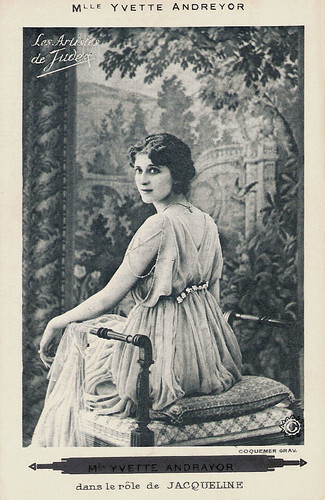
French postcard in the 'Les Artistes de Judex' series by Coquemer Grav. Photo: Gaumont. Publicity still for La nouvelle mission de Judex (Louis Feuillade 1917-1918) with Yvette Andreyor as Jacqueline.
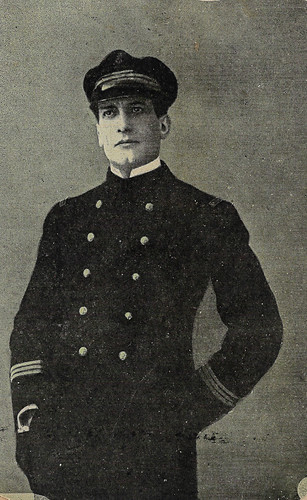
Spanish collector's card by Chocolate Pi, Barcelona, no. 1. Photo: Gaumont. René Cresté in La déserteuse (Louis Feuillade, 1917). The Spanish release title was Tortura de madre.
Persecuted innocence
After the First World War, the triumphant crime in Louis Feuillade's films gave way to persecuted innocence. He started to focus on melodramas such as Les Deux Gamines/The Two Girls (1921). The family story, which had previously been underlying Feuillade's episodic films, now came to the fore. To his usual cast of actors, the director added dancer Sandra Milowanoff , from Serge Diaghilev's Ballets Russes. Les Deux Gamines, presented at the Gaumont-Palace from January to April 1921, was a huge success. Feuillade's subsequent serials were always popular but he never achieved such a triumph as with Les Deux Gamines.
Feuillade's next two serials, L'Orpheline/The orphan (1918) and Parisette (1922) featured Sandra Milowanoff , but also a young, leading man named René Clair. Between these two serials, the indefatigable Feuillade directed, five comedies with Georges Biscot in the 'Belle Humeur' series, between 1921 and 1922. Although these comedies were not always very light, the series was always really effective and did not contradict its title.
Le Fils du Flibustier/The Son of the Pirate (1922) was his final serial in 12 episodes. It is more adventure-oriented and gives Aimé Simon-Girard , fresh from his success in Henri Diamant-Berger's Les Trois Mousquetaires/The Three Musketeers (1921), the opportunity to recompose a twirling and battling character in a work where reality and imagination are skilfully mixed. In 1922, he returned to the bullfighting thread and made with Musidora the films Sol y sombra/Sun and shadow (Jacques Lasseyne, Musidora, José Sobrado de Onega, 1922) and La Tierra de los toros/The Cradle of God (Fred LeRoy Granville, 1924), starring Cordoba-based rejoneador Antonio Cañero.
In 1923, the fashion for serials began to fade. Vindicta (1923), set in the eighteenth century in Provence and the Islands, had only five 'periods'. A six-year-old girl, Bouboule, discovered by Mistinguett , presented herself with fantastic spontaneity. From her first appearance in Le Gamin de Paris/Paris urchin (1923), the public had eyes only for her. Yet she had only a modest role in this film in which Sandra Milowanoff and René Poyen , the former Bout-de-Zan who had become a teenager, were the main characters. Feuillade devoted the whole of 1924 to his new young star, with René Poyen as her regular partner. After La Gosseline/The gossamer (1924) and La Fille bien gardée/The well-kept daughter (1924), he directed them in a six-part serial, L'Orphelin de Paris/The orphan of Paris (1924). Their two best films, however, are Pierrot, Pierrette (Maurice Champreux, Louis Feuillade, 1924) and Lucette (Maurice Champreux, Louis Feuillade, 1924), in which the two young stars both are very moving.
Exhausted by a life of uninterrupted work, Louis Feuillade was forced to take a complete rest in the summer of 1924. He made his last two films with the help of his son-in-law, Maurice Champreux. Only a few days after completing Le Stigmate/The Stigma, Louis Feuillade passed away in 1925 in Nice, at the age of 52. His death was a result of peritonitis. He is buried in the Saint-Gérard de Lunel cemetery. He was the father-in-law of Maurice Champreux and grandfather of Jacques Champreux. Forgotten with the arrival of sound film, Louis Feuillade's rehabilitation began after the Second World War thanks to Henri Langlois, who saved his films from 1936 onwards when the Cinémathèque française was founded.
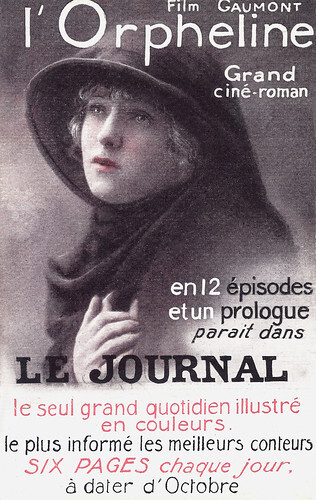
French postcard for the Gaumont serial L'Orphéline (Louis Feuillade 1921), starring Sandra Milowanoff .
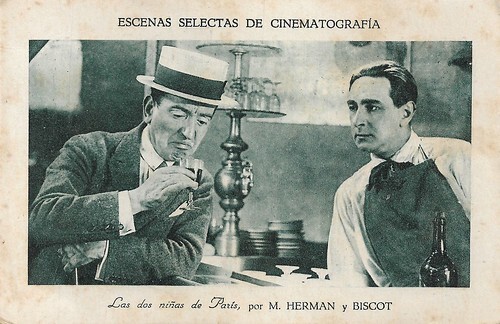
Spanish collectors card in the Escenas selectas de cinematografía, Series, B, No. 20. Photo: Gaumont. Georges Biscot and Fernand Herrmann in Les deux gamines/The two kids (Louis Feuillade, 1921), presented in Spain as Las dos niñas de París.
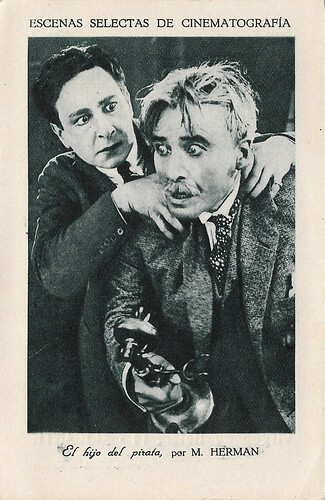
Spanish minicard in the Escenas selectas de cinematografía series, series B, no. 3, for Juan Garcia, Chocolates Gavilan, Alicante. Fernand Herrmann and Bernard Derigal in Le fils du flibustier/The buccaneer's son (Louis Feuillade, 1922). The Spanish title is El hijo del pirata.
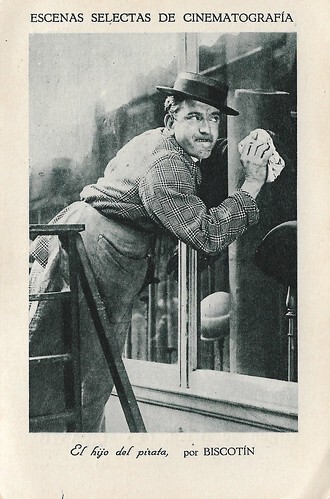
Spanish minicard in the Escenas selectas de cinematografía series, series B, no. 4, for Juan Garcia, Chocolates Gavilan, Alicante. Georges Biscot in Le fils du flibustier/The buccaneer's son (Louis Feuillade, 1922). The Spanish title is El hijo del pirata.
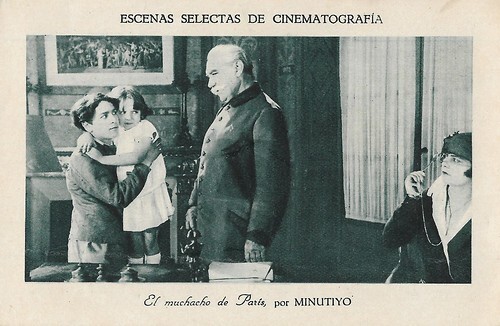
Spanish minicard in the Escenas selectas de cinematografía series, series B, no. 13, for Juan Garcia, Chocolates Gavilan, Alicante. René Poyen (Bout de Zan) as war orphan Joseph (left) in Le gamin de Paris/Paris urchin (Louis Feuillade, 1923). The little girl he holds was Bouboule as Gaby, the general was played by Adolphe Candé, and the lady at right, Madame de Mersange, by Renée van Delly. Spanish title is El muchacho de Paris. As a child star, René Poyen was known in France as Bout de Zan and in Spain as Minutiyo.
Sources: Britannica, Wikipedia (Dutch, German, English, and French), and .
For Ivo. Congratulations!

French cigarette card by Cigarettes Le Nil, no. 38. Photo: H. Manuel. Musidora as Irma Vep.

German postcard by Ross Verlag, Berlin, no. 1174/3, 1927-1928. Georges Biscot , presented in Germany as 'Biscot Meyer', in L'orpheline/The orphan (Louis Feuillade, 1921).

French Postcard, no. 171. Photo: Gaumont. Sandra Milowanoff and Aimé Simon-Girard in Le fils du filibustier/The Son of the Pirate (Louis Feuillade, 1922). Collection: Didier Hanson.

French postcard. Photo: Film Gaumont. Lucien Dalsace in Vindicta (Louis Feuillade, 1923).
The leading director of early French cinema
Louis Jean Feuillade was born in 1873 in Lunel in the Languedoc, France. He was the son of Barthélémy Feuillade, a modest wine merchant, and Marie Avesque. The young Louis quickly showed a taste for literature. He wrote numerous plays, dramas and vaudevilles, and published poems in the local press. He was trained as a journalist, but Feuillade first worked with his father and brother in the family wine shop and had his literary ambitions on the side. In 1898, after the death of his parents, he left the family business in the hands of his brother and went to Paris where he started as a journalist for the daily newspaper La Croix.
Feuillade managed to have a few plays performed, such as 'Le Clos', a verse play presented in Béziers in 1905, of which he was the co-author. The same year he presented a few scripts to Gaumont, a company originally focused on photography, but which was developing cinematographic ambitions. Alice Guy , the artistic director at Gaumont and also the first female director in the history of cinema, commissioned him to write his first screenplays in 1905.
Soon Feuillade became Guy's regular scriptwriter. After her marriage to the later director and producer Herbert Blaché in 1907, Alice Guy went to Berlin and later to New York. She suggested to Léon Gaumont that Feuillade be appointed artistic director. From 1 April 1907, he was responsible for the artistic choices of the French film company whose ambition was to compete with Pathé. Louis Feuillade would hold this position - in Paris until 1918, then in Nice - until his death.
Feuillade had the opportunity to direct films himself. In 1906, he breathed life into Alice Guy 's ideas for short bullfighting films with Course de taureaux à Nîmes (Alice Guy, Louis Feuillade, 1906) with passes of the toreador Machaquito, shot in the Nîmes amphitheatre. His first personal film was the comedy C'est papa qui prend la purge/It was Dad who took the purge (1907). In 1910, to counterbalance Le Film d'art known for L'assassinat du duc de Guise/The Assassination of the Duke of Guise (André Calmettes, Charles Le Bargy, 1908), Louis Feuillade promoted the Gaumont series 'Le Film Esthétique', for which he directed religious works, Le Pater/The Lord's Prayer (1910), Les sept péchés capitaux/The Seven Deadly Sins (1910), La nativité/The Nativity (1910), and stories inspired by Greco-Roman civilisation. However, this attempt at 'high-brow' cinema was financially unsuccessful.
Instead, Feuillade became known in France with the serial film series La vie telle qu'elle est/Life as It Is (1911), a more realistic but somewhat melodramatic depiction of contemporary life. He often filmed with children and established them as series stars, including Clément Mary alias Bébé (more than 70 episodes, 1910-1913) and René Poyen alias Bout-de-Zan (more than 50 episodes, 1912-1916). Feuillade was a jack-of-all-trades. He made trick films, comedies, ancient dramas, bible films, exotic adventure films and police films. He brought naturalness to film and would become the leading director of early French cinema, especially with serials about criminals and detectives with realistic, sometimes even surrealistic backgrounds.

Spanish minicard series by Reclam Films, Mallorca, first episode, card 2 of 6. Photo: Gaumont. René Navarre and Jane Faber in Fantômas (Louis Feuillade, 1913). With a fake beard, Fantômas ( René Navarre ) observes Princess Danidoff (Jane Faber) in her hotel suite. He will rob her of her pearls and money and leave her a business card that only afterwards reveals its name: Fantômas.

Spanish minicards (collectors' cards). Reclam Films, Mallorca. René Navarre as Fantomas in a scene from the serial Fantomas, second series, Juve versus Fantômas/ Juve contre Fantômas (Louis Feuillade, Gaumont, 1913), card no. 6. Fantomas aka The Man in Black dynamites the villa in which Juve and Fandor are.

Spanish minicard by Reclam Films, Mallorca. Photo: Gaumont. Scene from the third episode of the French silent crime serial Fantomas, Le Mort qui tue (Louis Feuillade, Gaumont 1913). Fantomas ( René Navarre ), dressed as the Black Man, is about to chloroform the painter Jacques Dollon ( André Luguet ).

Spanish minicard by Reclam Films, Mallorca, card 4 of 6. Photo: Gaumont. Scene from Fantômas contre Fantômas (Louis Feuillade, G1914), the fourth episode of the serial Fantomas. Fantomas' gang, dressed as workmen, tie up the policemen, including the juge d'instruction Fuselier, and kidnap Juve (Edmund Breon).

Spanish minicard by Reclam Films, Mallorca, card 1 of 6. Photo: Gaumont. René Navarre in Le faux magistrat (Louis Feuillade, 1914), the fifth episode of the serial Fantomas. Pretending to be judge Pradier, Fantômas ( René Navarre ) orders the arrested gang members Paulet and L'Elève to make sure Juve will be killed.
A seductive and disturbing incarnation of the forces of evil
In 1913, Louis Feuillade adapted Marcel Allain and Pierre Souvestre's novel Fantômas for the big screen. The film serial Fantômas - À l'ombre de la guillotine/Fantomas (1913-1914) about the mysterious criminal Fantômas starring René Navarre made the hero of the successful detective novel series even more popular. Its swift-moving, intricate plot features a series of thrilling episodes involving clever disguises, trapdoors, kidnappings, hairbreadth escapes, and rooftop chases. René Navarre transformed into a crime emperor, while Georges Melchior was the journalist Fandor and Edmond Bréon the inspector Juve. Audiences were thrilled and kept coming back for more. The success was phenomenal. Five episodes were made: Fantômas (1913), Juve Contre Fantômas/Juve Against Fantomas (1913), Le Mort qui tue/The Dead Man Who Killed (1913), Fantômas contre Fantômas/Fantomas Against Fantomas (1914) and Le Faux Magistrat/The False Magistrate (1914).
Fantômas established Feuillade's popularity in both France and the United States. Then Pathé announced the French presentation of the episodic film Les Mystères de New York/The Exploits of Elaine (Louis J. Gasnier, George B. Seitz, Leopold Wharton, Theodore Wharton, 1914) presented in the form of a cine-novel: the public read the serial in the press before going to see the film in theatres. Gaumont's answer was Les Vampires/The Vampires (1915-1916), a ten-part series about the criminal organisation Les Vampires. Feuillade needed an actress capable of competing with Pearl White . He chose Musidora , who had been working with him since the previous year. She became Irma Vep, the muse of the mysterious 'Vampires' gang. Dressed in a tight-fitting black full-body suit, Irma Vep is a seductive and disturbing incarnation of the forces of evil. The lead actor, Édouard Mathé , replaced Navarre in the cast. As reporter Philippe Guérande, he struggles against these dark forces with the help of a repentant 'vampire', Mazamette, played by comedian Marcel Lévesque.
Les Vampires/The Vampires consists of 10 episodes presented over as many consecutive weeks. The film serial thrilled contemporary audiences not least because of the appearance of Musidora . The Surrealists were so fascinated by Feuillades' crime serials that Max Jacob founded a 'Société des Amis de Fantômas', which the entire group promptly joined. The characters Fantômas and Irma Vep, the femme fatale and strategist of crime embodied by Musidora from Les Vampires/The Vampires, are encountered in the collages of Max Ernst, poems by Paul Éluard and Robert Desnos (set to music by Kurt Weill) and films by Jean Cocteau. The motif of transformation and disguise is omnipresent in Surrealist cinema.
Feuillade then shot another very popular serial, Judex (12 episodes, 1916). He cast the actor René Cresté as the positive hero of the film series Judex, of which a sequel was made under the title La nouvelle mission de Judex/The New Mission of Judex (12 episodes, 1916-1917). Cresté played a daring detective with a sweeping black cape, a righter of wrongs who was the prototype of many future film heroes. The tremendous success of the |Judex series saved the French film industry, which had been threatened by competition from foreign imports.
René Cresté also appeared in two less-known Feuillade serials: Tih Minh (12 episodes, 1918) and Vendémiaire (1918). Especially Tih Minh with the exotic Hong Kong-born British actress Mary Harald is aesthetically pleasing. In Vendémiaire (1919), a hymn to the vine as a source of life and a return to the origins of the Hérault region, Louis Feuillade portrays an officer who has become blind as a result of a wound in battle and who takes in refugees from the First World War on his property. Feuillade's last crime serial was Barrabas (1919), with the veteran Gaston Michel in the role of the master criminal. Georges Biscot took over from Marcel Lévesque as the comic sidekick.

French postcard by Coquemer Gravures, Paris. Photo: Gaumont. René Cresté as Judex and Edouard Mathé in La nouvelle mission de Judex (Louis Feuillade 1917-1918).

French postcard by Coquemer Gravures, Paris. Photo: Gerschel / Gaumont. Marcel Levesque in the role of Coquentin in La nouvelle mission de Judex (Louis Feuillade, 1917-1918).

French postcard by Coquemer Gravures. Photo: Gaumont. René Cresté as Judex in La nouvelle mission de Judex (1917-1918).

French postcard in the 'Les Artistes de Judex' series by Coquemer Grav. Photo: Gaumont. Publicity still for La nouvelle mission de Judex (Louis Feuillade 1917-1918) with Yvette Andreyor as Jacqueline.

Spanish collector's card by Chocolate Pi, Barcelona, no. 1. Photo: Gaumont. René Cresté in La déserteuse (Louis Feuillade, 1917). The Spanish release title was Tortura de madre.
Persecuted innocence
After the First World War, the triumphant crime in Louis Feuillade's films gave way to persecuted innocence. He started to focus on melodramas such as Les Deux Gamines/The Two Girls (1921). The family story, which had previously been underlying Feuillade's episodic films, now came to the fore. To his usual cast of actors, the director added dancer Sandra Milowanoff , from Serge Diaghilev's Ballets Russes. Les Deux Gamines, presented at the Gaumont-Palace from January to April 1921, was a huge success. Feuillade's subsequent serials were always popular but he never achieved such a triumph as with Les Deux Gamines.
Feuillade's next two serials, L'Orpheline/The orphan (1918) and Parisette (1922) featured Sandra Milowanoff , but also a young, leading man named René Clair. Between these two serials, the indefatigable Feuillade directed, five comedies with Georges Biscot in the 'Belle Humeur' series, between 1921 and 1922. Although these comedies were not always very light, the series was always really effective and did not contradict its title.
Le Fils du Flibustier/The Son of the Pirate (1922) was his final serial in 12 episodes. It is more adventure-oriented and gives Aimé Simon-Girard , fresh from his success in Henri Diamant-Berger's Les Trois Mousquetaires/The Three Musketeers (1921), the opportunity to recompose a twirling and battling character in a work where reality and imagination are skilfully mixed. In 1922, he returned to the bullfighting thread and made with Musidora the films Sol y sombra/Sun and shadow (Jacques Lasseyne, Musidora, José Sobrado de Onega, 1922) and La Tierra de los toros/The Cradle of God (Fred LeRoy Granville, 1924), starring Cordoba-based rejoneador Antonio Cañero.
In 1923, the fashion for serials began to fade. Vindicta (1923), set in the eighteenth century in Provence and the Islands, had only five 'periods'. A six-year-old girl, Bouboule, discovered by Mistinguett , presented herself with fantastic spontaneity. From her first appearance in Le Gamin de Paris/Paris urchin (1923), the public had eyes only for her. Yet she had only a modest role in this film in which Sandra Milowanoff and René Poyen , the former Bout-de-Zan who had become a teenager, were the main characters. Feuillade devoted the whole of 1924 to his new young star, with René Poyen as her regular partner. After La Gosseline/The gossamer (1924) and La Fille bien gardée/The well-kept daughter (1924), he directed them in a six-part serial, L'Orphelin de Paris/The orphan of Paris (1924). Their two best films, however, are Pierrot, Pierrette (Maurice Champreux, Louis Feuillade, 1924) and Lucette (Maurice Champreux, Louis Feuillade, 1924), in which the two young stars both are very moving.
Exhausted by a life of uninterrupted work, Louis Feuillade was forced to take a complete rest in the summer of 1924. He made his last two films with the help of his son-in-law, Maurice Champreux. Only a few days after completing Le Stigmate/The Stigma, Louis Feuillade passed away in 1925 in Nice, at the age of 52. His death was a result of peritonitis. He is buried in the Saint-Gérard de Lunel cemetery. He was the father-in-law of Maurice Champreux and grandfather of Jacques Champreux. Forgotten with the arrival of sound film, Louis Feuillade's rehabilitation began after the Second World War thanks to Henri Langlois, who saved his films from 1936 onwards when the Cinémathèque française was founded.

French postcard for the Gaumont serial L'Orphéline (Louis Feuillade 1921), starring Sandra Milowanoff .

Spanish collectors card in the Escenas selectas de cinematografía, Series, B, No. 20. Photo: Gaumont. Georges Biscot and Fernand Herrmann in Les deux gamines/The two kids (Louis Feuillade, 1921), presented in Spain as Las dos niñas de París.

Spanish minicard in the Escenas selectas de cinematografía series, series B, no. 3, for Juan Garcia, Chocolates Gavilan, Alicante. Fernand Herrmann and Bernard Derigal in Le fils du flibustier/The buccaneer's son (Louis Feuillade, 1922). The Spanish title is El hijo del pirata.

Spanish minicard in the Escenas selectas de cinematografía series, series B, no. 4, for Juan Garcia, Chocolates Gavilan, Alicante. Georges Biscot in Le fils du flibustier/The buccaneer's son (Louis Feuillade, 1922). The Spanish title is El hijo del pirata.

Spanish minicard in the Escenas selectas de cinematografía series, series B, no. 13, for Juan Garcia, Chocolates Gavilan, Alicante. René Poyen (Bout de Zan) as war orphan Joseph (left) in Le gamin de Paris/Paris urchin (Louis Feuillade, 1923). The little girl he holds was Bouboule as Gaby, the general was played by Adolphe Candé, and the lady at right, Madame de Mersange, by Renée van Delly. Spanish title is El muchacho de Paris. As a child star, René Poyen was known in France as Bout de Zan and in Spain as Minutiyo.
Sources: Britannica, Wikipedia (Dutch, German, English, and French), and .
For Ivo. Congratulations!
Published on August 29, 2022 22:00
August 28, 2022
La Collectionneuse: Jennifer Jones
In the 1940s and 1950s, Jennifer Jones was a name to reckon with. She won the Best Actress Oscar for The Song of Bernadette (1943) and was again nominated in the same category for Love Letters (1945), Duel in the Sun (1946) and Love is a Many-Splendored Thing (1955). She also received a Best Supporting Actress Oscar nomination for Since you Went Away (1944). She worked for famous directors such as Henry King, William Dieterle, Ernst Lubitsch, King Vidor, John Huston, Vincente Minnelli, Michael Powell and Emeric Pressburger, William Wyler and Vittorio de Sica. During her heyday, she appeared opposite top-notch male stars such as Joseph Cotten, Charles Boyer, Gregory Peck, John Garfield, Louis Jourdan, Laurence Olivier, Charlton Heston, Humphrey Bogart, Montgomery Clift, William Holden and Rock Hudson.
Her name will forever be linked to that of David O’Selznick. He made her a star and always kept a watchful eye on her career, although the choices he made for her didn’t always pay off. To be fair, several top-quality films such as Portrait of Jennie or Carrie didn’t deserve to be commercial failures. Onscreen, Jennifer Jones was a versatile actress and brought a special intensity to most of her roles. In private, she was known to be a rather shy and insecure person, who was never really at ease with stardom. She is one of my favourite actresses. So, I’m happy to pay homage to her through this post.
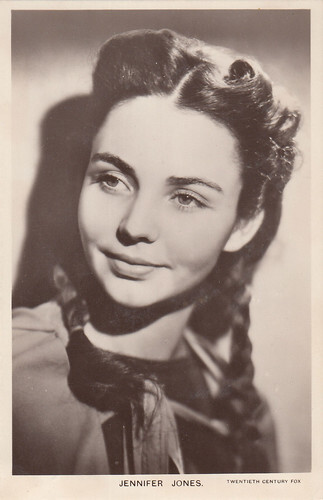
British postcard by Picturegoer, no. W127. Jennifer Jones in The Song of Bernadette (Henry King, 1943). Photo: Twentieth Century Fox.
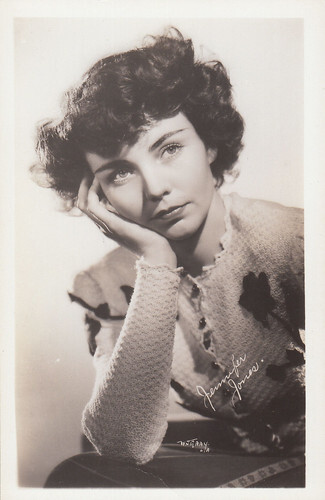
American postcard. Photo: W.J. Gray, L.A.
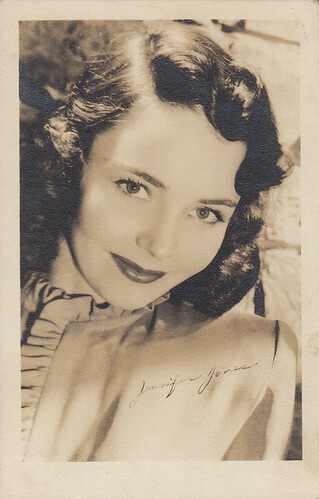
American postcard by the Selznick Studio, Culver City, California. Sent by mail in 1944.
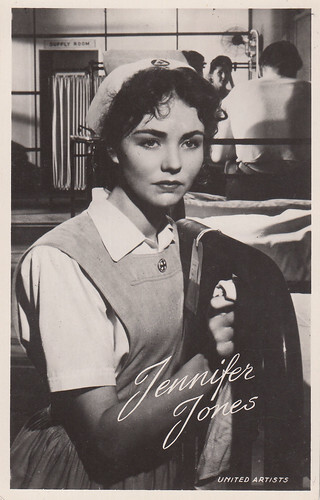
Vintage postcard. Photo: United Artists. Jennifer Jones in Since You Went Away (John Cromwell, 1944).
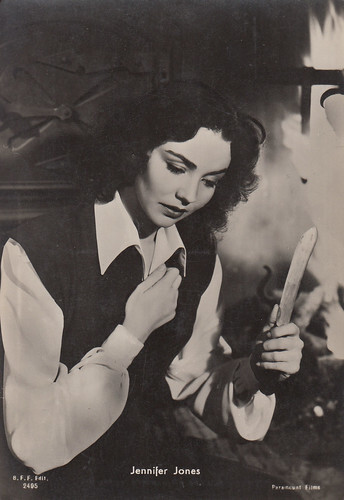
Italian postcard by Ballerini & Fratini, Firenze, no. 2495. Photo: Paramount Films. Jennifer Jones in Love Letters (William Dieterle, 1945).
Bitten by the acting bug.
Jennifer Jones was born Phylis Isley on the 2nd of March 1919 in Tulsa, Oklahoma, U.S.A. At the time, her parents, Phil Isley and Flora Mae Suber had their own travelling tent-show theatrical company, the 'Isley Stock Company'. At the end of the 1920s and the beginning of the 1930s, Phil Isley wisely purchased a number of movie theatres and became one of the prominent exhibitors in the Oklahoma-Texas area.
From an early age, Phylis dreamed of becoming an actress. In the autumn of 1936, she enrolled at Northwestern University, a college renowned for its drama department. Dissatisfied with the courses she was given, she decided she didn’t want to spend a second year there and quit.
After gaining acting experience, through her father’s connexions, in the 'Mansfield Players Stock Company', during their 1937 summer tour, Phylis entered the prestigious New York American Academy of Dramatic Arts in September.
That’s where she met an aspiring young actor named Robert Walker. They fell in love and left the Academy after one academic year. Thanks to her father, Phylis got her own weekly radio show in Tulsa, the 'Phylis Isley Radio Theater', at the end of 1938.
Phylis and Robert Walker were married on the 2nd of January 1939 and Phil Isley advised them to try their luck in Hollywood. Paramount was not impressed but Phylis was signed by Republic Studios, where she played opposite John Wayne in New Frontier (George Sherman, 1939) and was Gwen, Dick Tracy’s secretary, in the serial Dick Tracy’s G-Men (John English, William Witney, 1939). After those two films, she asked to be released from her contract. Back in New York, she gave birth to two sons, Robert Jr in April 1940 and Michael in March 1941.
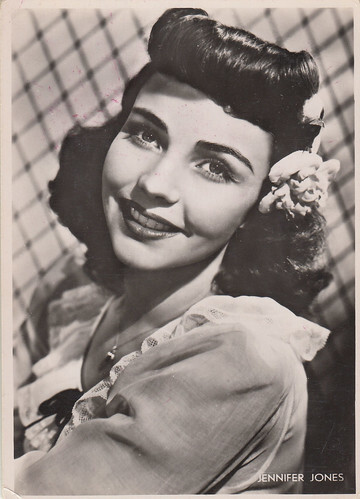
Dutch postcard by Uitgave P.F. Cladder, Amsterdam, no. 49-3.
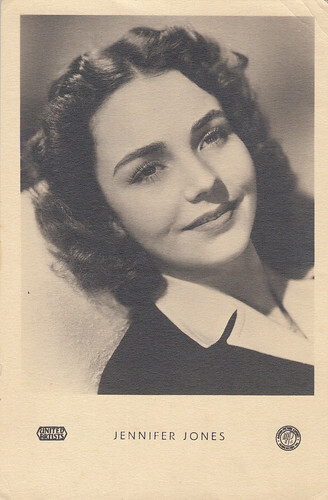
German postcard by Kitt photokarten, München, no. 606. Photo: United Artists.
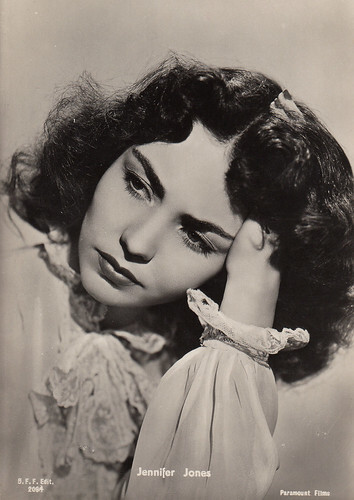
Italian postcard by Ballerini & Fratini, Firenze, no. 2084. Photo: Paramount Films.
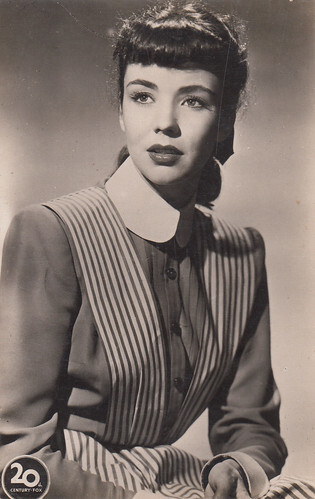
Spanish postcard by C.M.B., no. 59. Photo: 20th Century Fox. Jennifer Jones in Cluny Brown (Ernst Lubitsch, 1946).
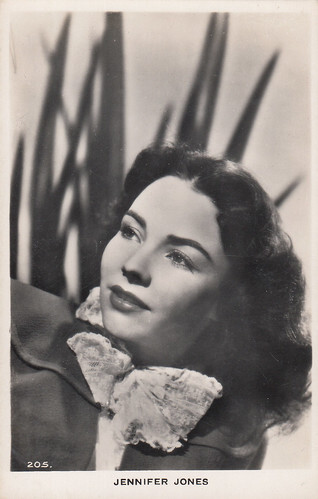
British postcard no. 205.
Groomed by David O’Selznick
When she learnt that a Chicago production of the Broadway hit 'Claudia' was going to be staged, Phylis decided to test for the title role but, in the end, it was Phyllis Thaxter who was chosen.
Kay Brown, David O’Selznick’s renowned and efficient New York representative, brought the young girl to the famous producer’s attention and arranged for an audition and a screen test.
An impressed Selznick, who owned the film rights to 'Claudia', decided to sign her in July 1941. A disappointed Phylis soon learned that she was never to play in Claudia (Edmund Goulding, 1943), which was finally filmed with Dorothy McGuire.
However, Selznick had started to take a deep personal interest in his latest discovery, whom he had decided to groom for stardom, and, in January 1942, her name was changed to Jennifer Jones.
He wanted his protegee to be given the much-coveted role of Saint Bernadette Soubirous in the forthcoming production The Song of Bernadette and began negotiating with 20th Century Fox executives to convince them that she would be an ideal choice. After a successful screen test, she got the part. The Song of Bernadette (Henry King, 1943) made Jennifer Jones a star and earned her a Best Actress Oscar. She suddenly became hot property in Hollywood.
Since you Went Away (John Cromwell, 1944), a sentimental drama about the effects of World War II on an upper-middle-class American family, Love Letters (William Dieterle, 1945), in which she played an amnesiac, and the comedy Cluny Brown (Ernst Lubitsch, 1946) successfully followed.
In 1946, Jennifer played sultry half-breed Pearl Chavez in the flamboyant Western Duel in the Sun (King Vidor, 1946). On the whole, it wasn’t favourably received by film critics. Furthermore, the Catholic Church found it morally objectionable. Nevertheless, people flocked to see it and it was a top box-office hit.
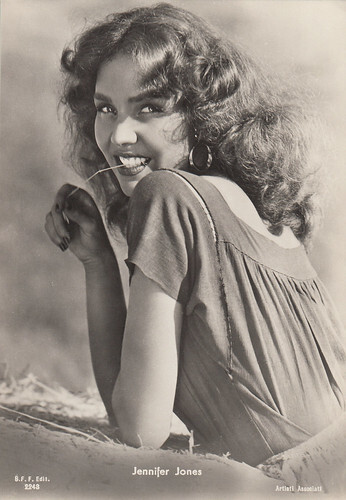
Italian postcard by Ballerini & Fratini, Firenze, no. 2248. Photo: United Artists. Jennifer Jones in Duel in the Sun (King Vidor, 1946).
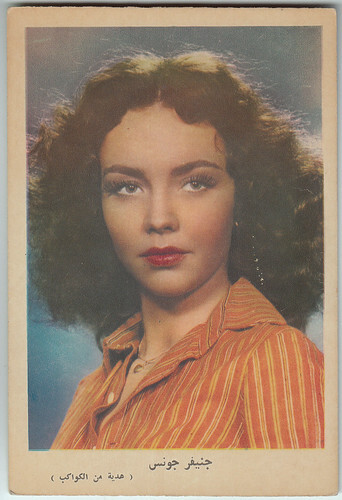
Egyptian postcard. Jennifer Jones in Duel in the Sun (King Vidor, 1946).
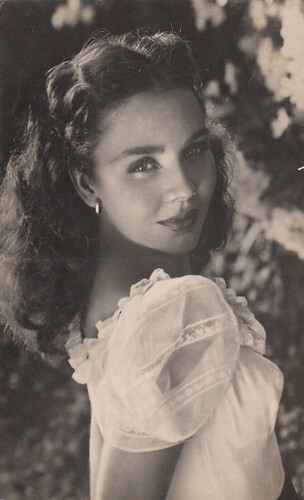
Spanish postcard by Soberanas, Barcelona, no. 341. Jennifer Jones in Duel in the Sun (King Vidor, 1946).
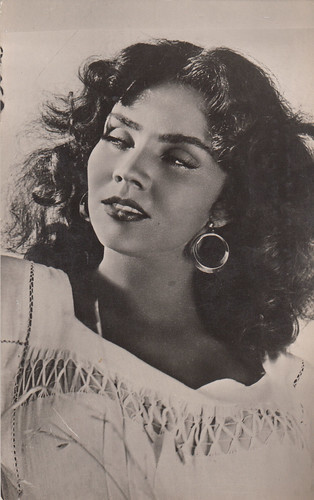
Spanish postcard. Jennifer Jones in Duel in the Sun (King Vidor, 1946).
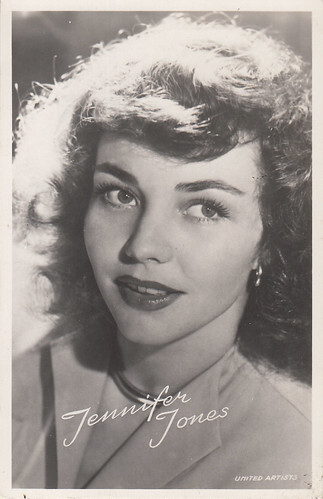
Dutch postcard by Takken, no. A.X. 451. Photo: United Artists.
A career of up and downs
Jennifer Jones then appeared in Portrait of Jennie (William Dieterle, 1949). It has since become a classic but was a flop at the time, as was They Were Strangers (John Huston, 1949). She also starred in Vincente Minnelli’s lavish M.G.M. production Madame Bovary (Vincente Minnelli, 1949). That same year, Jennifer Jones and David O’Selznick, after their respective divorces, married.
In England, Jennifer was directed by Michael Powell and Emeric Pressburger in Gone to Earth (1950). At its release in the U.K. in 1950, it failed to attract audiences. It met the same fate in 1952 when it was shown in the U.S., in a revised version, as The Wild Heart.
The public also didn’t respond warmly to Carrie (William Wyler, 1952), which was found too grim. Fortunately, Jennifer had a hit with Ruby Gentry (King Vidor, 1952), a steamy melodrama which was launched with the tagline "A Siren Who Wrecked a Whole Town - Man by Man - Sin by Sin".
In 1953, she went to Rome to co-star with Montgomery Clift in Vittorio de Sica ’s Stazione Termini (1953). In Italy, it didn’t meet the expected success. When, one year later, it was shown in the U.S. in a heavily cut version, as Indiscretion of an American Wife, it flopped. Audiences also stayed away from the offbeat Beat the Devil (John Huston, 1954).
Jennifer Jones came back to the top thanks to Love is a Many-Splendored Thing (Henry King, 1955), Good Morning Miss Dove (Henry Koster, 1955) and The Man in the Gray Flannel Suit (Nunnally Johnson, 1956).
After The Barretts of Wimpole Street (Sidney Franklin, 1957), she co-starred with Rock Hudson in A Farewell to Arms (Charles Vidor, 1957), which was severely panned by most reviewers. It made some financial profit for 20th Century Fox but its harsh critical reception hit Jennifer and her husband hard. Selznick never produced another movie.
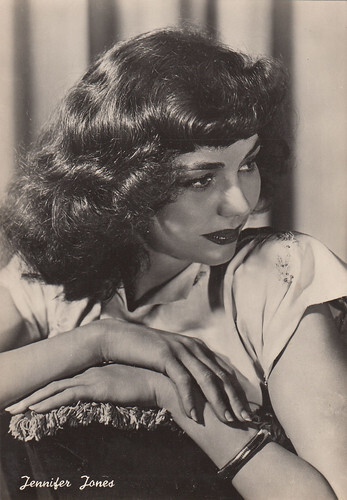
Italian postcard by Bromofoto, Milano, no. 148.
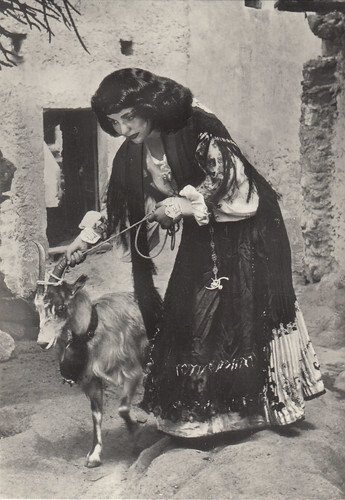
Italian postcard by Bromofoto, Milano, in the 'Costumi sardi' series. Collection: Marlene Pilaete. In this series, Bromofoto had the weird idea to put famous stars’ faces on the bodies of Sardinian people dressed in traditional costumes. They didn’t bother to mention the names of the stars on the back of the postcards. You will notice that Bromofoto used the same Jennifer Jones photo on their postcard no. 148.
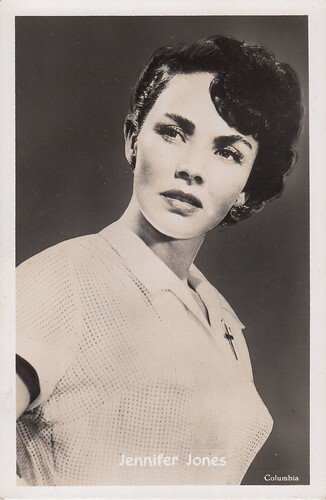
Belgian postcard by Nieuwe Merksemsche Chocolaterie S.P.R.L., Merksem Anvers, no. D7. Photo: Columbia. Jennifer Jones in We Were Strangers (John Huston, 1949).
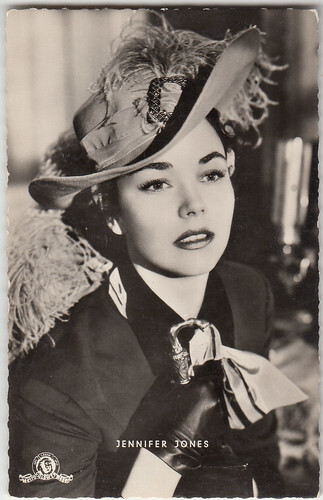
West-German postcard by Kunst und Bild Berlin, no. S 711. Photo: MGM. Jennifer Jones in Madame Bovary (Vincente Minnelli, 1949).
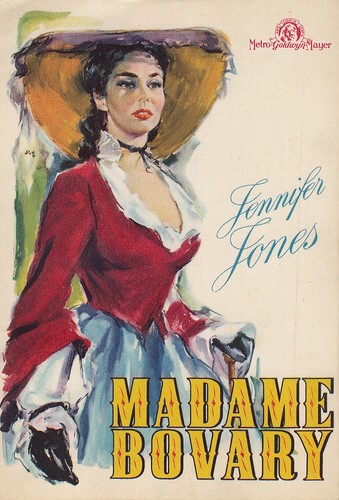
Italian promotional postcard for Madame Bovary (Vincente Minnelli, 1949) by Zincografica, Firenze.
The sixties: the difficult years
After a three-year absence from the screen, Jennifer Jones reappeared in Tender Is the Night (Henry King, 1961). It didn’t win the popular appeal and several critics found that she was too old for the part of Nicole.
At the beginning of the 1960s, Jennifer’s services were not in demand anymore and her career came to a standstill. David O’Selznick’s death in 1965 left her disoriented. She had lost the man who had been the driving force behind her professional life.
She then chose to accept a film offer from England but The Idol (Daniel Petrie, 1966) failed to generate interest and was not the kind of movie to inspire other producers to seek her out.
In 1967, she was found unconscious on a California beach, after an overdose of sleeping pills. She later declared that it was more a cry for help rather than a real desire to end her life.
Rather inexplicably, she accepted to play a former porno star in Angel, Angel, Down We Go (Robert Thom, 1969), which turned up to be so poor that it quickly vanished from the theatres. It was re-released in 1970 as Cult of the damned but it did no better.
Wanting to give a new direction to her life, she became involved, at the end of the 1960s, in the Los Angeles-based 'Manhattan Project', a program for emotionally disturbed youngsters and drug addicts, for which she proved to be a highly effective fund-raiser.
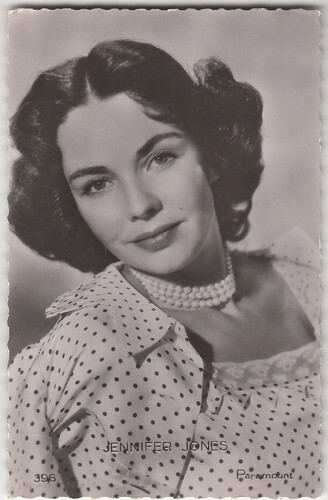
French postcard by Editions P.I., Paris, no. 210 D. Photo: Paramount. Collection: Marlene Pilaete.
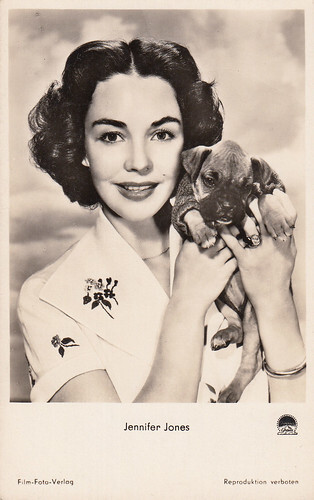
German postcard by Film-Foto-Verlag, Berlin-Tempelhof, no. FK 304. Photo: Paramount Pictures.
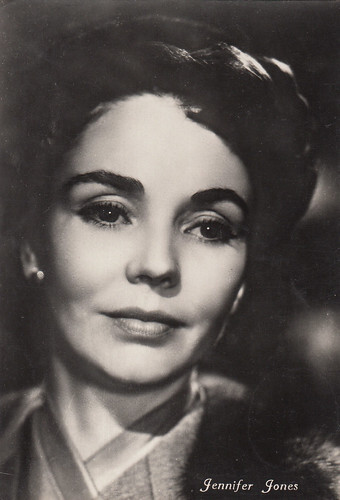
Italian postcard by Vetta Traldi, Milano, no. 10. Jennifer Jones in Stazione Termini/Indiscretion of an American Wife (Vittorio De Sica, 1953).
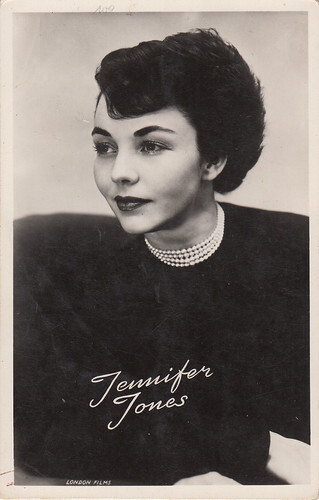
Vintage postcard. Photo: London Films.
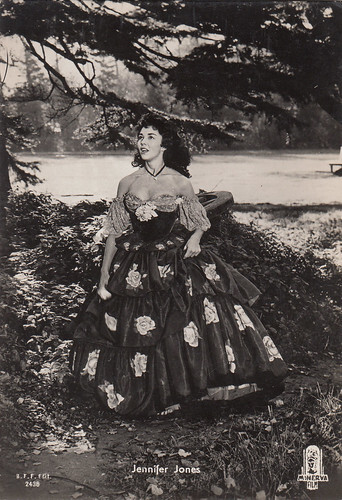
Italian postcard by Ballerini & Fratini, Firenze, no. 2438. Photo: Minerva Film. Jennifer Jones in Gone to Earth (Michael Powell, Emeric Pressburger, 1950).
A new chapter in her life
In 1971, she married multi-millionaire and art collector Norton Simon. Her husband encouraged her to make her screen comeback by joining the star-studded cast of one of the 1970s top-grossing blockbusters, The Towering Inferno (John Guillermin, 1974).
In May 1976, Mary Jennifer, the daughter she had from Selznick in 1954, committed suicide. A few weeks later, Jennifer’s father passed away. She overcame her grief by committing herself stronger to the cause of mental issues. As a result, the 'Jennifer Jones Simon Foundation for Mental Health and Education' was founded in 1980.
Her movie career was never reactivated, although she had been interested at one time to portray the murderess Jean Harris onscreen, the project didn’t come off. Jennifer and her husband also optioned the film rights to the novel 'Terms of Endearment' but, when she learnt that she was considered too old by director James Brooks to play the mother role, she gave up the idea. The part went to Shirley MacLaine , who got an Oscar for it.
In 1989, she was named Chairwoman of the famous Norton Simon Art Museum and stayed so until 2003, when she was given emeritus status. In the 1990s, her interest in the world of psychiatry still vivid, she worked as a paraprofessional therapist and volunteered as a counsellor at the Southern California Counseling Center in Beverly Hills.
Widowed in 1993, Jennifer Jones spent the last six years of her life with her son Robert Jr and his family and passed away on the 17th of December 2009.
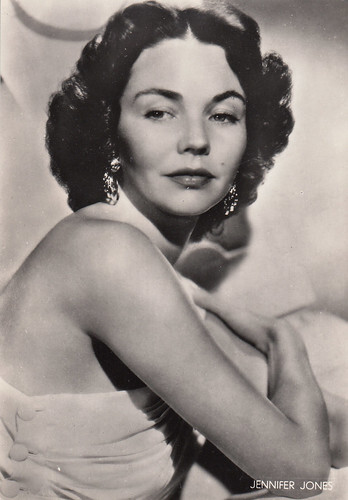
Italian postcard by Bromostampa, Milano, no. 342.
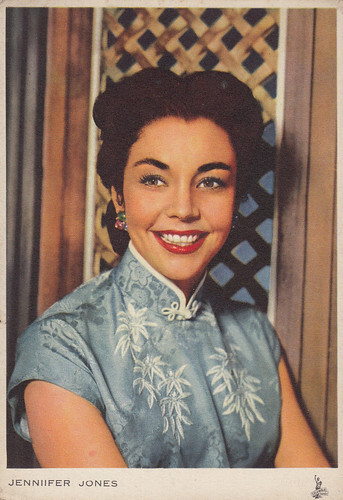
Argentinian postcard by Cromocart G.W., no. 147. Photo: Columbia. Jennifer Jones in Love is a Many-Splendored Thing (Henry King, 1955).
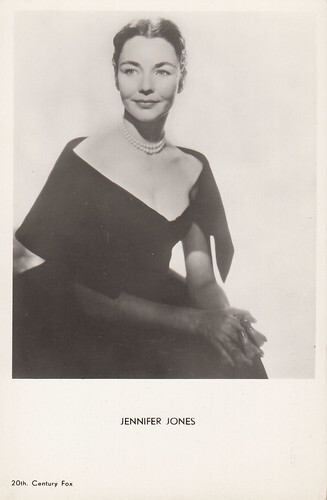
Vintage postcard. Photo: 20th Century Fox.
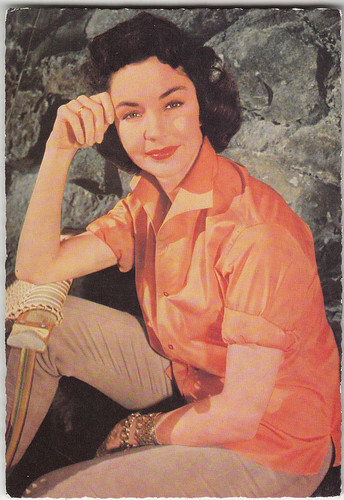
West-German postcard by WS Druck, Wanne-Eickel, no. F 112.
Text and postcards: Marlene Pilaete.
Her name will forever be linked to that of David O’Selznick. He made her a star and always kept a watchful eye on her career, although the choices he made for her didn’t always pay off. To be fair, several top-quality films such as Portrait of Jennie or Carrie didn’t deserve to be commercial failures. Onscreen, Jennifer Jones was a versatile actress and brought a special intensity to most of her roles. In private, she was known to be a rather shy and insecure person, who was never really at ease with stardom. She is one of my favourite actresses. So, I’m happy to pay homage to her through this post.

British postcard by Picturegoer, no. W127. Jennifer Jones in The Song of Bernadette (Henry King, 1943). Photo: Twentieth Century Fox.

American postcard. Photo: W.J. Gray, L.A.

American postcard by the Selznick Studio, Culver City, California. Sent by mail in 1944.

Vintage postcard. Photo: United Artists. Jennifer Jones in Since You Went Away (John Cromwell, 1944).

Italian postcard by Ballerini & Fratini, Firenze, no. 2495. Photo: Paramount Films. Jennifer Jones in Love Letters (William Dieterle, 1945).
Bitten by the acting bug.
Jennifer Jones was born Phylis Isley on the 2nd of March 1919 in Tulsa, Oklahoma, U.S.A. At the time, her parents, Phil Isley and Flora Mae Suber had their own travelling tent-show theatrical company, the 'Isley Stock Company'. At the end of the 1920s and the beginning of the 1930s, Phil Isley wisely purchased a number of movie theatres and became one of the prominent exhibitors in the Oklahoma-Texas area.
From an early age, Phylis dreamed of becoming an actress. In the autumn of 1936, she enrolled at Northwestern University, a college renowned for its drama department. Dissatisfied with the courses she was given, she decided she didn’t want to spend a second year there and quit.
After gaining acting experience, through her father’s connexions, in the 'Mansfield Players Stock Company', during their 1937 summer tour, Phylis entered the prestigious New York American Academy of Dramatic Arts in September.
That’s where she met an aspiring young actor named Robert Walker. They fell in love and left the Academy after one academic year. Thanks to her father, Phylis got her own weekly radio show in Tulsa, the 'Phylis Isley Radio Theater', at the end of 1938.
Phylis and Robert Walker were married on the 2nd of January 1939 and Phil Isley advised them to try their luck in Hollywood. Paramount was not impressed but Phylis was signed by Republic Studios, where she played opposite John Wayne in New Frontier (George Sherman, 1939) and was Gwen, Dick Tracy’s secretary, in the serial Dick Tracy’s G-Men (John English, William Witney, 1939). After those two films, she asked to be released from her contract. Back in New York, she gave birth to two sons, Robert Jr in April 1940 and Michael in March 1941.

Dutch postcard by Uitgave P.F. Cladder, Amsterdam, no. 49-3.

German postcard by Kitt photokarten, München, no. 606. Photo: United Artists.

Italian postcard by Ballerini & Fratini, Firenze, no. 2084. Photo: Paramount Films.

Spanish postcard by C.M.B., no. 59. Photo: 20th Century Fox. Jennifer Jones in Cluny Brown (Ernst Lubitsch, 1946).

British postcard no. 205.
Groomed by David O’Selznick
When she learnt that a Chicago production of the Broadway hit 'Claudia' was going to be staged, Phylis decided to test for the title role but, in the end, it was Phyllis Thaxter who was chosen.
Kay Brown, David O’Selznick’s renowned and efficient New York representative, brought the young girl to the famous producer’s attention and arranged for an audition and a screen test.
An impressed Selznick, who owned the film rights to 'Claudia', decided to sign her in July 1941. A disappointed Phylis soon learned that she was never to play in Claudia (Edmund Goulding, 1943), which was finally filmed with Dorothy McGuire.
However, Selznick had started to take a deep personal interest in his latest discovery, whom he had decided to groom for stardom, and, in January 1942, her name was changed to Jennifer Jones.
He wanted his protegee to be given the much-coveted role of Saint Bernadette Soubirous in the forthcoming production The Song of Bernadette and began negotiating with 20th Century Fox executives to convince them that she would be an ideal choice. After a successful screen test, she got the part. The Song of Bernadette (Henry King, 1943) made Jennifer Jones a star and earned her a Best Actress Oscar. She suddenly became hot property in Hollywood.
Since you Went Away (John Cromwell, 1944), a sentimental drama about the effects of World War II on an upper-middle-class American family, Love Letters (William Dieterle, 1945), in which she played an amnesiac, and the comedy Cluny Brown (Ernst Lubitsch, 1946) successfully followed.
In 1946, Jennifer played sultry half-breed Pearl Chavez in the flamboyant Western Duel in the Sun (King Vidor, 1946). On the whole, it wasn’t favourably received by film critics. Furthermore, the Catholic Church found it morally objectionable. Nevertheless, people flocked to see it and it was a top box-office hit.

Italian postcard by Ballerini & Fratini, Firenze, no. 2248. Photo: United Artists. Jennifer Jones in Duel in the Sun (King Vidor, 1946).

Egyptian postcard. Jennifer Jones in Duel in the Sun (King Vidor, 1946).

Spanish postcard by Soberanas, Barcelona, no. 341. Jennifer Jones in Duel in the Sun (King Vidor, 1946).

Spanish postcard. Jennifer Jones in Duel in the Sun (King Vidor, 1946).

Dutch postcard by Takken, no. A.X. 451. Photo: United Artists.
A career of up and downs
Jennifer Jones then appeared in Portrait of Jennie (William Dieterle, 1949). It has since become a classic but was a flop at the time, as was They Were Strangers (John Huston, 1949). She also starred in Vincente Minnelli’s lavish M.G.M. production Madame Bovary (Vincente Minnelli, 1949). That same year, Jennifer Jones and David O’Selznick, after their respective divorces, married.
In England, Jennifer was directed by Michael Powell and Emeric Pressburger in Gone to Earth (1950). At its release in the U.K. in 1950, it failed to attract audiences. It met the same fate in 1952 when it was shown in the U.S., in a revised version, as The Wild Heart.
The public also didn’t respond warmly to Carrie (William Wyler, 1952), which was found too grim. Fortunately, Jennifer had a hit with Ruby Gentry (King Vidor, 1952), a steamy melodrama which was launched with the tagline "A Siren Who Wrecked a Whole Town - Man by Man - Sin by Sin".
In 1953, she went to Rome to co-star with Montgomery Clift in Vittorio de Sica ’s Stazione Termini (1953). In Italy, it didn’t meet the expected success. When, one year later, it was shown in the U.S. in a heavily cut version, as Indiscretion of an American Wife, it flopped. Audiences also stayed away from the offbeat Beat the Devil (John Huston, 1954).
Jennifer Jones came back to the top thanks to Love is a Many-Splendored Thing (Henry King, 1955), Good Morning Miss Dove (Henry Koster, 1955) and The Man in the Gray Flannel Suit (Nunnally Johnson, 1956).
After The Barretts of Wimpole Street (Sidney Franklin, 1957), she co-starred with Rock Hudson in A Farewell to Arms (Charles Vidor, 1957), which was severely panned by most reviewers. It made some financial profit for 20th Century Fox but its harsh critical reception hit Jennifer and her husband hard. Selznick never produced another movie.

Italian postcard by Bromofoto, Milano, no. 148.

Italian postcard by Bromofoto, Milano, in the 'Costumi sardi' series. Collection: Marlene Pilaete. In this series, Bromofoto had the weird idea to put famous stars’ faces on the bodies of Sardinian people dressed in traditional costumes. They didn’t bother to mention the names of the stars on the back of the postcards. You will notice that Bromofoto used the same Jennifer Jones photo on their postcard no. 148.

Belgian postcard by Nieuwe Merksemsche Chocolaterie S.P.R.L., Merksem Anvers, no. D7. Photo: Columbia. Jennifer Jones in We Were Strangers (John Huston, 1949).

West-German postcard by Kunst und Bild Berlin, no. S 711. Photo: MGM. Jennifer Jones in Madame Bovary (Vincente Minnelli, 1949).

Italian promotional postcard for Madame Bovary (Vincente Minnelli, 1949) by Zincografica, Firenze.
The sixties: the difficult years
After a three-year absence from the screen, Jennifer Jones reappeared in Tender Is the Night (Henry King, 1961). It didn’t win the popular appeal and several critics found that she was too old for the part of Nicole.
At the beginning of the 1960s, Jennifer’s services were not in demand anymore and her career came to a standstill. David O’Selznick’s death in 1965 left her disoriented. She had lost the man who had been the driving force behind her professional life.
She then chose to accept a film offer from England but The Idol (Daniel Petrie, 1966) failed to generate interest and was not the kind of movie to inspire other producers to seek her out.
In 1967, she was found unconscious on a California beach, after an overdose of sleeping pills. She later declared that it was more a cry for help rather than a real desire to end her life.
Rather inexplicably, she accepted to play a former porno star in Angel, Angel, Down We Go (Robert Thom, 1969), which turned up to be so poor that it quickly vanished from the theatres. It was re-released in 1970 as Cult of the damned but it did no better.
Wanting to give a new direction to her life, she became involved, at the end of the 1960s, in the Los Angeles-based 'Manhattan Project', a program for emotionally disturbed youngsters and drug addicts, for which she proved to be a highly effective fund-raiser.

French postcard by Editions P.I., Paris, no. 210 D. Photo: Paramount. Collection: Marlene Pilaete.

German postcard by Film-Foto-Verlag, Berlin-Tempelhof, no. FK 304. Photo: Paramount Pictures.

Italian postcard by Vetta Traldi, Milano, no. 10. Jennifer Jones in Stazione Termini/Indiscretion of an American Wife (Vittorio De Sica, 1953).

Vintage postcard. Photo: London Films.

Italian postcard by Ballerini & Fratini, Firenze, no. 2438. Photo: Minerva Film. Jennifer Jones in Gone to Earth (Michael Powell, Emeric Pressburger, 1950).
A new chapter in her life
In 1971, she married multi-millionaire and art collector Norton Simon. Her husband encouraged her to make her screen comeback by joining the star-studded cast of one of the 1970s top-grossing blockbusters, The Towering Inferno (John Guillermin, 1974).
In May 1976, Mary Jennifer, the daughter she had from Selznick in 1954, committed suicide. A few weeks later, Jennifer’s father passed away. She overcame her grief by committing herself stronger to the cause of mental issues. As a result, the 'Jennifer Jones Simon Foundation for Mental Health and Education' was founded in 1980.
Her movie career was never reactivated, although she had been interested at one time to portray the murderess Jean Harris onscreen, the project didn’t come off. Jennifer and her husband also optioned the film rights to the novel 'Terms of Endearment' but, when she learnt that she was considered too old by director James Brooks to play the mother role, she gave up the idea. The part went to Shirley MacLaine , who got an Oscar for it.
In 1989, she was named Chairwoman of the famous Norton Simon Art Museum and stayed so until 2003, when she was given emeritus status. In the 1990s, her interest in the world of psychiatry still vivid, she worked as a paraprofessional therapist and volunteered as a counsellor at the Southern California Counseling Center in Beverly Hills.
Widowed in 1993, Jennifer Jones spent the last six years of her life with her son Robert Jr and his family and passed away on the 17th of December 2009.

Italian postcard by Bromostampa, Milano, no. 342.

Argentinian postcard by Cromocart G.W., no. 147. Photo: Columbia. Jennifer Jones in Love is a Many-Splendored Thing (Henry King, 1955).

Vintage postcard. Photo: 20th Century Fox.

West-German postcard by WS Druck, Wanne-Eickel, no. F 112.
Text and postcards: Marlene Pilaete.
Published on August 28, 2022 22:00
August 27, 2022
Til Schweiger
Handsome actor, director, and producer Til Schweiger (1963) is one of Germany's most successful filmmakers. Since 1990, no other German actor has drawn more people to the cinemas.
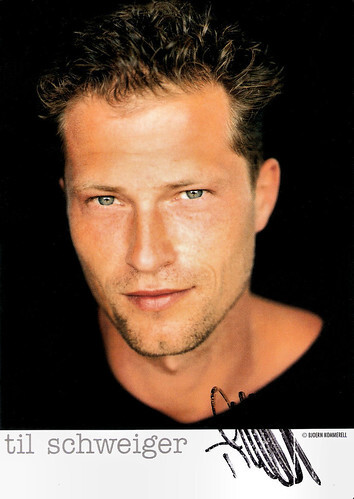
German autograph card. Photo: Bjoern Kommerell.
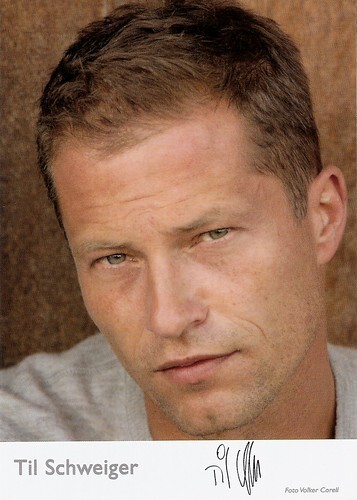
German postcard. Photo: Volker Corell.

German autograph card. Photo: Mathias Bothor.
Hunky Object Of Desire
Tilman Valentin ‘Til’ Schweiger was born in Freiburg, West Germany, in 1963. His parents were both teachers. He grew up with his two brothers in Heuchelheim near Giessen in Hesse, where he went to school.
First, he studied German and Medicine at the University, but in 1986 he chose for acting lessons at the drama school Der Keller in Cologne. After graduation in 1989, he played at several theatres in Cologne and Bonn. He first appeared onscreen in the TV series Lindenstraße (1989-1992). His first film role came with Manta, Manta/Racin' in the Street (Wolfgang Büld, 1991).
His international breakthrough followed with the comedy Der bewegte Mann/Maybe, Maybe Not (Sönke Wortmann, 1994), co-starring Joachim Król and Katja Riemann. Schweiger was a sensation as the hunky object of desire for both the women and the men in the film.
Der bewegte Mann was developed from the gay comics 'Der bewegte Mann' and 'Pretty Baby' by cult cartoonist Ralf König. With 6.5 million visitors in Germany, the film was the third biggest box office hit of the year in Germany. It also won several awards in Germany, including the German media award Bambi.
In 1995, Schweiger married American model Dana Carlson. The couple has four children: Valentin Florian Schweiger (1995), Luna Marie Schweiger (1997), Lilli Camille Schweiger (1998), and Emma Tiger Schweiger (2002).
His next film, Männerpension/Jailbirds (Detlev Buck, 1996) was again loaded with prizes, including a Bambi and a Jupiter as Best German film of the Year, and a Goldene Leinwand (Golden Screen) for its results at the German box offices.
In 1997, Schweiger made his debut as a producer and (uncredited) co-director with the crime comedy Knockin' on Heaven's Door (Thomas Jahn, 1997). The film is about two young terminal cancer patients (Jan Josef Liefers and Schweiger) who decide to take one last trip to the sea. However, the car they've stolen belongs to two thieves and contains a million marks. Soon they're being pursued by both thugs and cops. Knockin' on Heaven's Door became a cult favourite among cinema audiences worldwide.
Next, Schweiger directed, produced and starred in the action thriller Der Eisbär/The Polar Bear (Granz Henman, Til Schweiger, 1998).
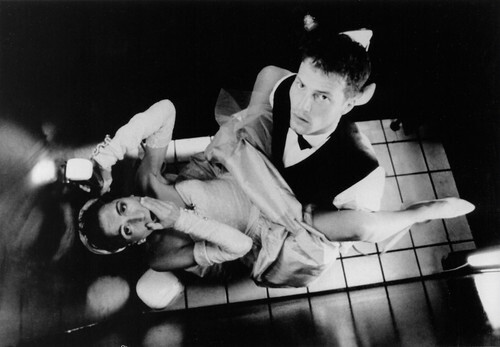
German press photo. Til Schweiger in Der bewegte Mann/Maybe, Maybe Not (Sönke Wortmann, 1994).
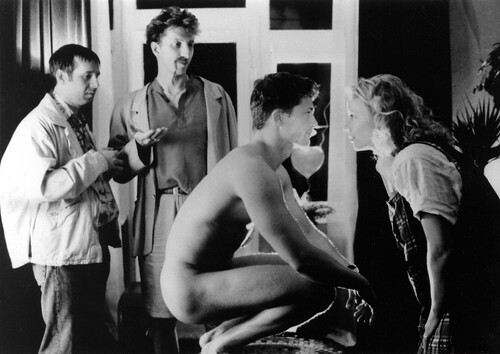
German press photo. Joachim Król, Til Schweiger and Katja Riemann in Der bewegte Mann/Maybe, Maybe Not (Sönke Wortmann, 1994).
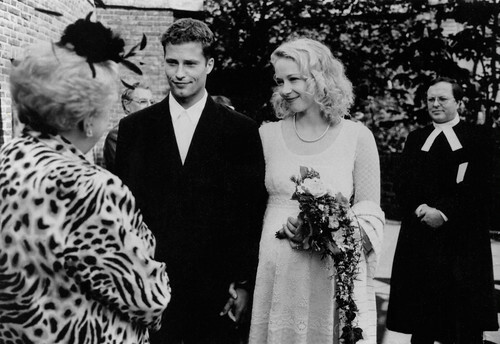
German press photo. Til Schweiger and Katja Riemann in Der bewegte Mann/Maybe, Maybe Not (Sönke Wortmann, 1994).
Big-budget Action Flops
Til Schweiger made his American acting debut in the crime thriller Judas Kiss (Sebastian Gutierrez, 1998), starring Alan Rickman and Emma Thompson.
It was followed by supporting parts in productions like the action films The Replacement Killers (Antoine Fuqua, 1998) starring Chow Yun-fat and Mira Sorvino, and Driven (Renny Harlin, 2001), starring Sylvester Stallone. Both were disappointing box office flops.
Smaller films were SLC Punk! (James Merendino, 1998) and the TV movie Joe and Max (Steve James, 2002), based on the legendary 1936 boxing fight of African-American heavyweight Joe Louis (Leonard Roberts) vs. German counterpart Max Schmeling (Schweiger), and Schmeling's secret heroism during World War II.
Like his earlier big-budget action films, Lara Croft Tomb Raider: The Cradle of Life (Jan de Bont, 2003), starring Angelina Jolie as Lara Croft, was another box office disappointment.
Next, he played supporting parts in King Arthur (Antoine Fuqua, 2004) featuring Clive Owen, the World War II submarine film In Enemy Hands/U-Boat (Tony Giglio, 2004), starring William H. Macy, and as Lucky Luke in the French Western comedy Les Dalton/The Daltons (Philippe Haïm, 2004), based on the popular comic by Morris.
In Germany, he appeared in (T)Raumschiff Surprise – Periode 1/Dreamship Surprise (Michael Herbig, 2004) in which several Star Trek and Star Wars characters are parodied. The Science Fiction satire draw 9.2 million visitors in Germany and was his most popular German production ever.
In 2005, Schweiger and his wife Dana Carlson separated, but they never divorced. Since 2010, Schweiger has been in a relationship with model Svenja Holtmann.
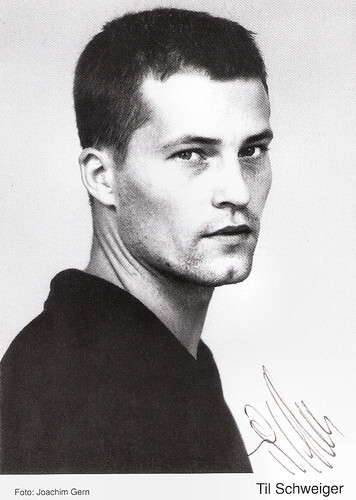
German autograph card. Photo: Joachim Gern.
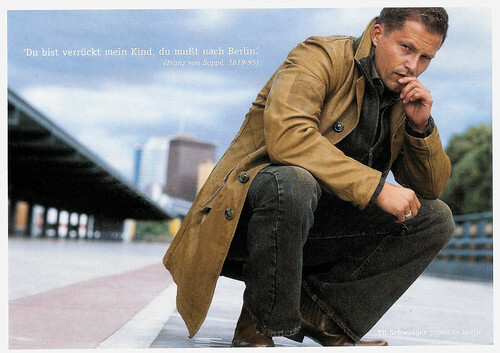
German postcard by Peek & Cloppenburg.

Promotion card for Skiny. Source: Til Schweiger @ Flickr.
Back To Berlin
After the separation from his wife Dana, Til Schweiger moved to Berlin and started his own production company, Barefoot Films. He wrote, directed, and starred in the romantic comedy Barfuß/Barefoot (2005), which won the Bambi award as the Best German Film of 2005.
His next production, Keinohrhasen/Rabbit Without Ears (2007), which he wrote, directed, starred in and produced, was a surprise hit in Germany. With a box office result of USD 74,000,000, the romantic comedy, co-starring Nora Tschirner, became one of the most successful films in German theatres ever. The film won a Bambi, a Bavarian Film Award, the German Comedy Award, two DIVA Awards, a Jupiter Award and the Ernst Lubitsch Award.
The sequel, Zweiohrküken/Rabbit Without Ears 2 (2008) was also a huge success. Schweiger then went on to direct, produce and star in 1½ Ritter – Auf der Suche nach der hinreißenden Herzelinde/1½ Knights – In Search of the Ravishing Princess Herzelinde (2008), which was slashed by the critics, but also proved to be another cinema hit.
In Kokowääh (2011), Schweiger's daughter Emma stars beside him, and the film is also directed, co-written and produced by him. Kokowääh (referring to Coq au vin) received better reviews and was another popular success. Father and daughter reprised their roles in the sequel Kokowääh 2 (2013).
Besides his own films, Schweiger also played in many other films. He was unforgettable as the steely psychopath Sgt. Hugo Stiglitz, infamous for his brutal and sadistic ways of murdering Nazis in Quentin Tarantino's Inglourious Basterds (2009).
His recent international screen appearances were in the romantic comedy New Year's Eve (Garry Marshall, 2011), the action film The Courier (Hany Abu-Assad, 2011) with Mickey Rourke, and as an international criminal in the romantic spy comedy This Means War (McG, 2012), with Chris Pine and Reese Witherspoon. He can also be seen in Muppets Most Wanted (James Bobin, 2014).
According to the website Inside Kino , no other German actor has more star power and has drawn more people to international cinemas since 1990, than Til Schweiger.
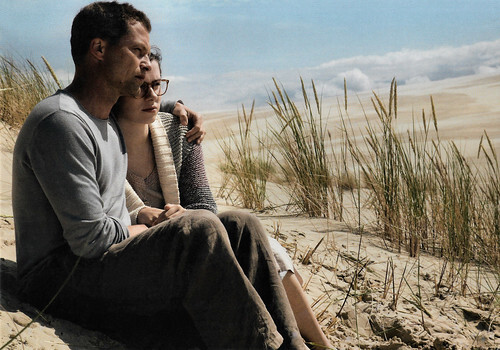
German promotion card by Barefoot Film / Warner Bros Entertainment GmbH / Rothkirch / Cartoon Film / Seven Pictures Film GmbH, 2009. Photo: Warner Bros. Til Schweiger and Nora Tschirner in Zweiohrküken/Rabbit Without Ears 2 (Til Schweiger, 2008).
German trailer Der bewegte Mann (1994). Source: Unseen Trailers (YouTube).
Sources: AllMovie, Inside Kino, Wikipedia and .

German autograph card. Photo: Bjoern Kommerell.

German postcard. Photo: Volker Corell.

German autograph card. Photo: Mathias Bothor.
Hunky Object Of Desire
Tilman Valentin ‘Til’ Schweiger was born in Freiburg, West Germany, in 1963. His parents were both teachers. He grew up with his two brothers in Heuchelheim near Giessen in Hesse, where he went to school.
First, he studied German and Medicine at the University, but in 1986 he chose for acting lessons at the drama school Der Keller in Cologne. After graduation in 1989, he played at several theatres in Cologne and Bonn. He first appeared onscreen in the TV series Lindenstraße (1989-1992). His first film role came with Manta, Manta/Racin' in the Street (Wolfgang Büld, 1991).
His international breakthrough followed with the comedy Der bewegte Mann/Maybe, Maybe Not (Sönke Wortmann, 1994), co-starring Joachim Król and Katja Riemann. Schweiger was a sensation as the hunky object of desire for both the women and the men in the film.
Der bewegte Mann was developed from the gay comics 'Der bewegte Mann' and 'Pretty Baby' by cult cartoonist Ralf König. With 6.5 million visitors in Germany, the film was the third biggest box office hit of the year in Germany. It also won several awards in Germany, including the German media award Bambi.
In 1995, Schweiger married American model Dana Carlson. The couple has four children: Valentin Florian Schweiger (1995), Luna Marie Schweiger (1997), Lilli Camille Schweiger (1998), and Emma Tiger Schweiger (2002).
His next film, Männerpension/Jailbirds (Detlev Buck, 1996) was again loaded with prizes, including a Bambi and a Jupiter as Best German film of the Year, and a Goldene Leinwand (Golden Screen) for its results at the German box offices.
In 1997, Schweiger made his debut as a producer and (uncredited) co-director with the crime comedy Knockin' on Heaven's Door (Thomas Jahn, 1997). The film is about two young terminal cancer patients (Jan Josef Liefers and Schweiger) who decide to take one last trip to the sea. However, the car they've stolen belongs to two thieves and contains a million marks. Soon they're being pursued by both thugs and cops. Knockin' on Heaven's Door became a cult favourite among cinema audiences worldwide.
Next, Schweiger directed, produced and starred in the action thriller Der Eisbär/The Polar Bear (Granz Henman, Til Schweiger, 1998).

German press photo. Til Schweiger in Der bewegte Mann/Maybe, Maybe Not (Sönke Wortmann, 1994).

German press photo. Joachim Król, Til Schweiger and Katja Riemann in Der bewegte Mann/Maybe, Maybe Not (Sönke Wortmann, 1994).

German press photo. Til Schweiger and Katja Riemann in Der bewegte Mann/Maybe, Maybe Not (Sönke Wortmann, 1994).
Big-budget Action Flops
Til Schweiger made his American acting debut in the crime thriller Judas Kiss (Sebastian Gutierrez, 1998), starring Alan Rickman and Emma Thompson.
It was followed by supporting parts in productions like the action films The Replacement Killers (Antoine Fuqua, 1998) starring Chow Yun-fat and Mira Sorvino, and Driven (Renny Harlin, 2001), starring Sylvester Stallone. Both were disappointing box office flops.
Smaller films were SLC Punk! (James Merendino, 1998) and the TV movie Joe and Max (Steve James, 2002), based on the legendary 1936 boxing fight of African-American heavyweight Joe Louis (Leonard Roberts) vs. German counterpart Max Schmeling (Schweiger), and Schmeling's secret heroism during World War II.
Like his earlier big-budget action films, Lara Croft Tomb Raider: The Cradle of Life (Jan de Bont, 2003), starring Angelina Jolie as Lara Croft, was another box office disappointment.
Next, he played supporting parts in King Arthur (Antoine Fuqua, 2004) featuring Clive Owen, the World War II submarine film In Enemy Hands/U-Boat (Tony Giglio, 2004), starring William H. Macy, and as Lucky Luke in the French Western comedy Les Dalton/The Daltons (Philippe Haïm, 2004), based on the popular comic by Morris.
In Germany, he appeared in (T)Raumschiff Surprise – Periode 1/Dreamship Surprise (Michael Herbig, 2004) in which several Star Trek and Star Wars characters are parodied. The Science Fiction satire draw 9.2 million visitors in Germany and was his most popular German production ever.
In 2005, Schweiger and his wife Dana Carlson separated, but they never divorced. Since 2010, Schweiger has been in a relationship with model Svenja Holtmann.

German autograph card. Photo: Joachim Gern.

German postcard by Peek & Cloppenburg.

Promotion card for Skiny. Source: Til Schweiger @ Flickr.
Back To Berlin
After the separation from his wife Dana, Til Schweiger moved to Berlin and started his own production company, Barefoot Films. He wrote, directed, and starred in the romantic comedy Barfuß/Barefoot (2005), which won the Bambi award as the Best German Film of 2005.
His next production, Keinohrhasen/Rabbit Without Ears (2007), which he wrote, directed, starred in and produced, was a surprise hit in Germany. With a box office result of USD 74,000,000, the romantic comedy, co-starring Nora Tschirner, became one of the most successful films in German theatres ever. The film won a Bambi, a Bavarian Film Award, the German Comedy Award, two DIVA Awards, a Jupiter Award and the Ernst Lubitsch Award.
The sequel, Zweiohrküken/Rabbit Without Ears 2 (2008) was also a huge success. Schweiger then went on to direct, produce and star in 1½ Ritter – Auf der Suche nach der hinreißenden Herzelinde/1½ Knights – In Search of the Ravishing Princess Herzelinde (2008), which was slashed by the critics, but also proved to be another cinema hit.
In Kokowääh (2011), Schweiger's daughter Emma stars beside him, and the film is also directed, co-written and produced by him. Kokowääh (referring to Coq au vin) received better reviews and was another popular success. Father and daughter reprised their roles in the sequel Kokowääh 2 (2013).
Besides his own films, Schweiger also played in many other films. He was unforgettable as the steely psychopath Sgt. Hugo Stiglitz, infamous for his brutal and sadistic ways of murdering Nazis in Quentin Tarantino's Inglourious Basterds (2009).
His recent international screen appearances were in the romantic comedy New Year's Eve (Garry Marshall, 2011), the action film The Courier (Hany Abu-Assad, 2011) with Mickey Rourke, and as an international criminal in the romantic spy comedy This Means War (McG, 2012), with Chris Pine and Reese Witherspoon. He can also be seen in Muppets Most Wanted (James Bobin, 2014).
According to the website Inside Kino , no other German actor has more star power and has drawn more people to international cinemas since 1990, than Til Schweiger.

German promotion card by Barefoot Film / Warner Bros Entertainment GmbH / Rothkirch / Cartoon Film / Seven Pictures Film GmbH, 2009. Photo: Warner Bros. Til Schweiger and Nora Tschirner in Zweiohrküken/Rabbit Without Ears 2 (Til Schweiger, 2008).
German trailer Der bewegte Mann (1994). Source: Unseen Trailers (YouTube).
Sources: AllMovie, Inside Kino, Wikipedia and .
Published on August 27, 2022 22:00
August 26, 2022
TV dreamboats of the 1950s and 1960s
Summer is not officially over yet, but we have to return to our jobs or schools, and happily, the new television season is starting again. Of course, many people are watching their favourite series online now, but many other people still love to see these series together on the couch. In the 1950s and 1960s, everybody was doing that and American broadcasters like NBC and CBS produced these series for the whole world to enjoy. Interestingly, many hunky young actors became stars in these series. Fanboys and fangirls everywhere collected their postcards on which they often posed shirtless. We were too young to see most of these series at the time, but we love to collect these postcards now which must have given lots of fans romantic dreams once.
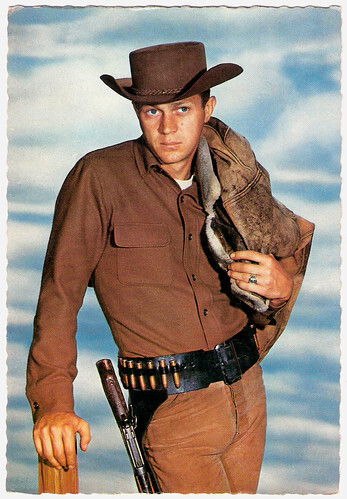
French postcard by Publistar, Marseille, no. 920. Photo: United-Press. Steve McQueen in Wanted: Dead or Alive (1958-1961).
Steve McQueen (1930-1980) was the ultra-cool Hollywood star of the 1960s and is still an icon of our popular culture. McQueen's first breakout role came on television. He appeared on Dale Robertson's NBC Western series Tales of Wells Fargo as Bill Longley. McQueen next filmed a pilot episode for what became the series titled Wanted: Dead or Alive, which aired on CBS in September 1958. This became his breakout role. He would later cross over into comparable status on the big screen, making him the first TV star to do so.
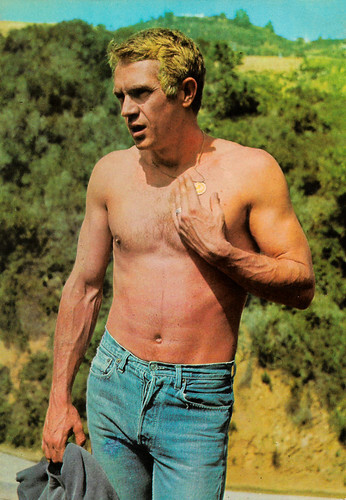
Spanish postcard by Postal Oscarcolor, no. 330.
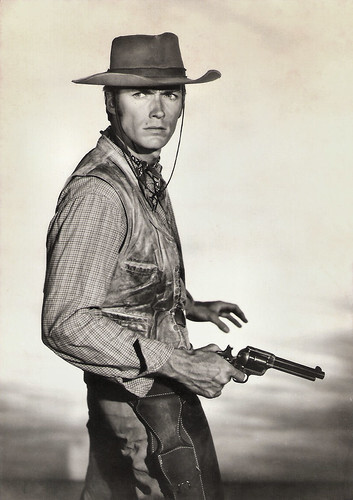
British postcard by D. Constance Ltd, London, no. 106. Photo: Reisfeld / Ufa. Clint Eastwood in the TV series Rawhide (1959–1966).
Before he rose to fame as the Man with No Name in Sergio Leone's classic Spaghetti Westerns Per un pugno di dollari/A Fistful of Dollars (1964), Per qualche dollaro in più/For a Few Dollars More (1965), and Il buono, il brutto, il cattivo/The Good, the Bad and the Ugly (1966), Clint Eastwood (1930) was a TV star as Rowdy Yates in the Western series Rawhide (1959–1966).
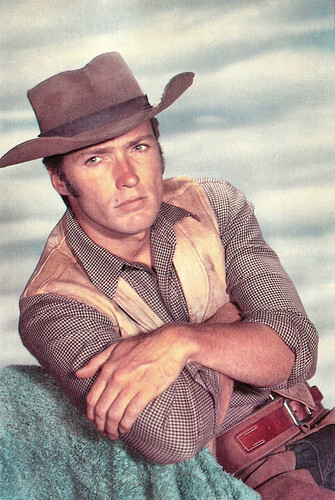
American postcard by the American Postcard Co. Inc., no. TV22, 1984. Photo: Viacom International Inc. Clint Eastwood as Rowdy Yates in Rawhide (1959–1966).
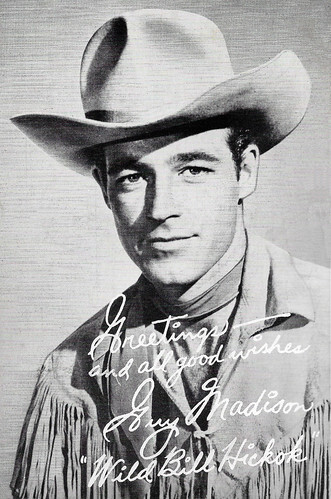
American Arcade postcard. Guy Madison in the TV series Adventures of Wild Bill Hickok (1951-1958).
Handsome American leading man Guy Madison (1922-1996) appeared in 85 films, on radio, and on television. In the 1940s, he started as a fresh-faced dreamboat. He became a hero to the Baby Boom generation as James Butler Hickock in the television series Adventures of Wild Bill Hickok (1951-1958). After the Hickok series ended, Madison became a star of European cinema.
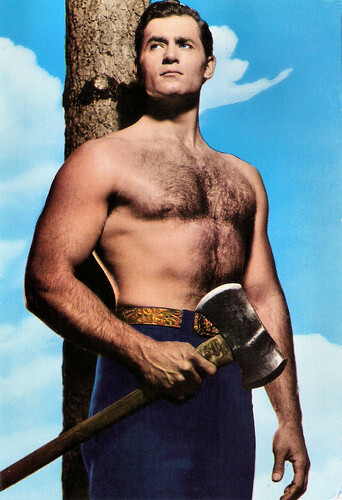
Spanish postcard by Raker, no. 1155, 1965. Photo: Clint Walker in the TV series Cheyenne (1955-1962).
Heavy set, athletic Clint Walker (1927) is a retired American actor and singer. In the 1950s, Walker with his broad shoulders and slim waist almost single-handedly started the Western craze on TV in his role as Cheyenne Bodie in Cheyenne (1955-1962).
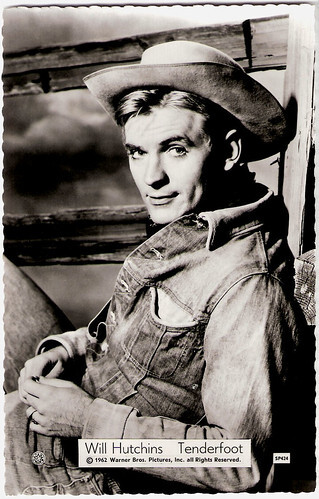
British postcard by Star, no. SP424. Photo: Warner Bros. Pictures, 1962. Will Hutchins in the TV series Sugarfoot/Tenderfoot (1957-1961).
Will Hutchins played the fledgling frontier lawyer Tom Brewster and Jack Elam as sidekick Toothy Thompson. Brewster was a correspondence-school graduate whose apparent lack of cowboy skills earned him the peculiar nickname 'Sugarfoot'. Brewster never used firearms, preferring to vanquish villains with his roping skills if friendly persuasion failed. He was reluctant to use firearms, but able and willing to do so as a last resort. During the same period, other similar shows would appear, including Maverick with James Garner and Jack Kelly, Cheyenne with Clint Walker, Bronco with Ty Hardin, Lawman with John Russell, and Colt .45 with Wayde Preston. Hutchins appeared as Sugarfoot in crossover episodes of Cheyenne, Maverick, and Bronco.
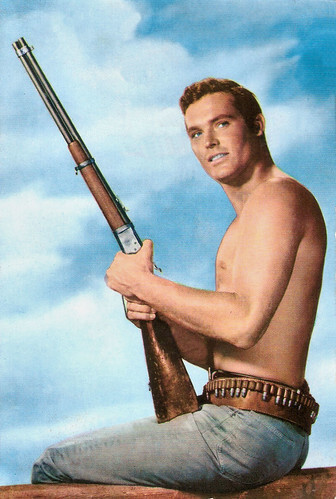
Spanish postcard by Ediciones Este, no. 7 T, 1963. Photo: Warner Bros. Ty Hardin in the TV series Bronco (1958-1962).
American actor Ty Hardin (1930-2017) is probably best known as TV cowboy Bronco. Though born as Jr. Orison Whipple Hungerford (!) in New York City, Ty Hardin was raised in Texas and, after military service during the Korean War, took some classes at Texas A&M. He then moved west to California and won some minor roles in B movies, credited as Ty Hungerford. When TV's Clint Walker insisted on improvements in his Cheyenne (1955) contract, Warner Brothers countered by bringing in Ty as a possible replacement. Soon, Ty had his own show, Bronco, which ran from 1958 to 1962. From here, he moved into a brief flurry of film activity.
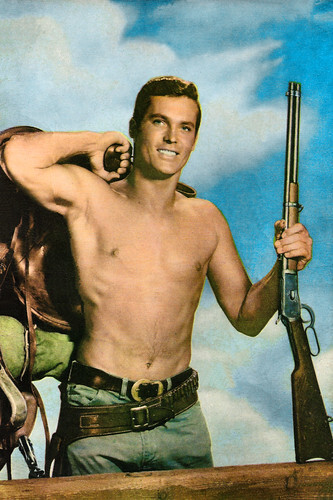
Spanish postcard by Ediciones Este, no. 8 T, 1963. Photo: Warner Bros. Ty Hardin in the TV series Bronco (1958-1962).
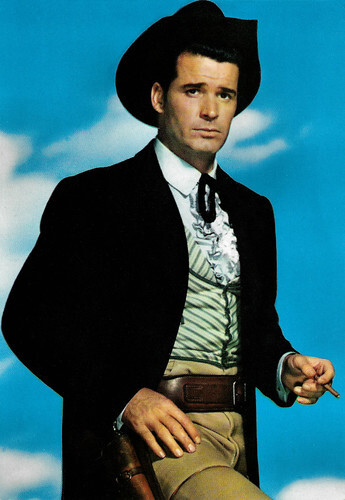
Spanish postcard by CyA, no. 22. Photo: Warner Bros. James Garner in the TV series Maverick (1957-1960).
James Garner (1928-2014) became known to a wider audience with the role of professional gambler Bret Maverick in the Western TV series Maverick (1957-1960) opposite Jack Kelly as his brother Bart Maverick. Maverick played poker on riverboats and in saloons while traveling incessantly through the 19th-century American frontier. When Garner left the series in 1960, Roger Moore played for a while cousin Beau, namesake nephew of Beau 'Pappy' Maverick. Beau returned from an extended stay in England to meet cousin Bart. Years later, Garner and Kelly reappeared as Bret and Bart Maverick in a made-for-television film titled The New Maverick (Hy Averback, 1978) written by Juanita Bartlett, and in the series Bret Maverick (1981-1982).
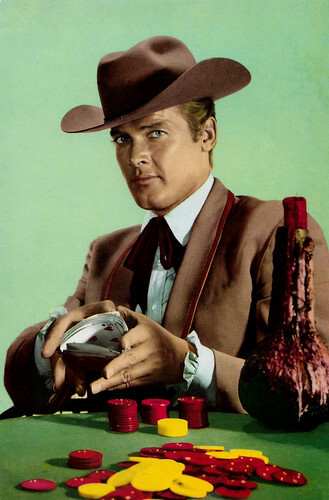
Spanish postcard by Ediciones Este, no. 36. Roger Moore in Maverick (1959-1961).
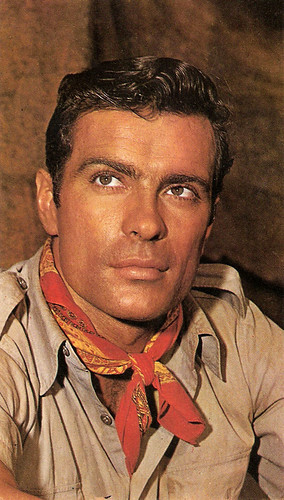
French postcard by Publistar, offered by Corvisart, Epinal, no. 919. Photo: United-Press.
American actor, artist, and author Gardner McKay (1932-2001) was best known for the lead role in the TV series Adventures in Paradise (1959-1962), based loosely on the writings of James Michener. He quit acting and became a writer in 1970.
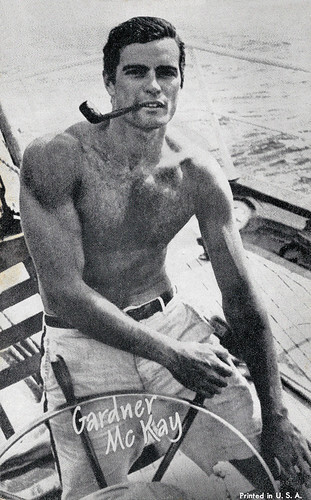
American Arcade postcard. Gardner McKay in Adventures in Paradise (1959-1962).
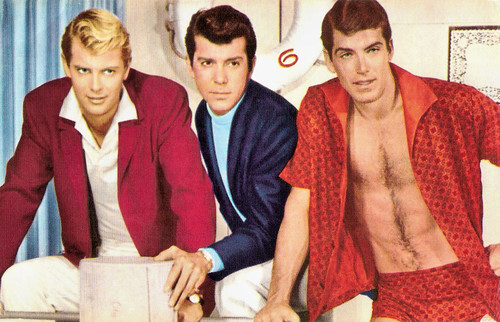
Spanish postcard by Oscarcolor, no. 16-T. Photo: Warner Bros. Troy Donahue , Lee Patterson, and Van Williams in the TV series Surfside 6 (1960-1962).
Surfside 6 was about the adventures of three hip private detectives, Ken (Van Williams), Dave (Lee Patterson) and Sandy ( Troy Donahue ). The three live on and work out of a houseboat in Miami, Florida. A yacht, belonging to socialite Daphne (Diane McBain), is anchored next to their houseboat. While not pursuing criminals, they spend time at the Fontainebleau Hotel chasing Cha Cha (Margarita Sierra) who works as an entertainer in the Boom Boom Room.
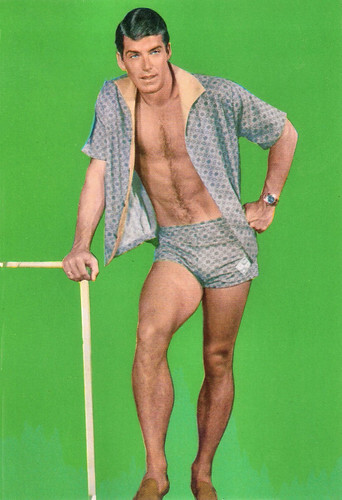
Spanish postcard by Oscarcolor, no. 252. Photo: Warner Bros. Van Williams in the TV series Surfside 6 (1960-1962).
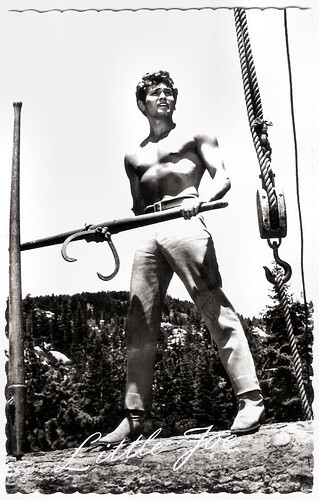
German postcard by Filmbilder-Vertrieb Ernst Freihoff, Essen, no. AX 5597. Photo: Michael Landon in the TV series Bonanza (1959-1973).
Michael Landon played Little Joe, the youngest and most handsome of the Cartwright brothers in the legendary American Western series Bonanza (1959-1973). Ben Cartwright (Lorne Greene) and his sons Hoss (Dan Blocker), Adam (Pernell Roberts) and Little Joe (Michael Landon) had many adventures while running and defending their Ponderosa Ranch in Nevada and helping the surrounding community.
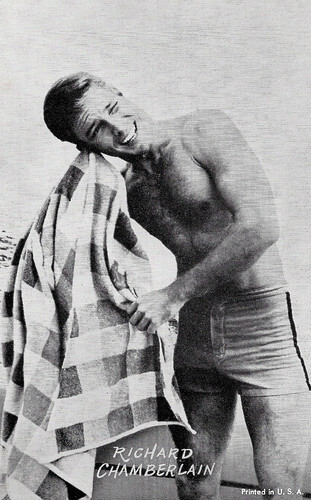
American Arcade card.
Impeccably handsome American actor Richard Chamberlain (1934) was TV's leading heartthrob because of his title role in the medical series Dr. Kildare (1961-1966). The slim, butter-haired hunk with the near-perfect Ivy-League charm and smooth, intelligent demeanour, had the distaff fans fawning unwavering over him through the series' run.
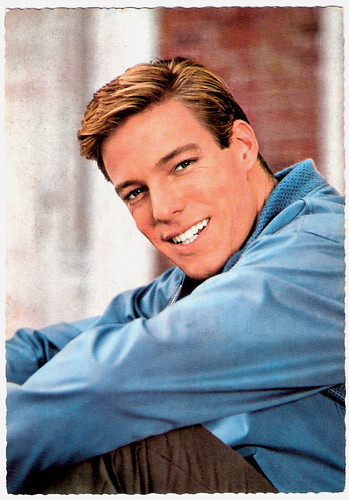
German postcard by Krüger, no. 902/240.
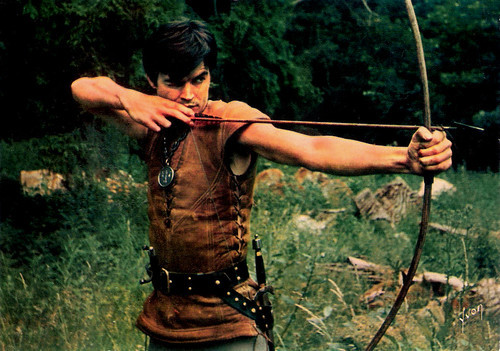
French postcard by Éditions d'art Yvon, Arcueil, no. 2. Photo: O.R.T.F. / Télé France Film / Photo Bruguière. Jean-Claude Drouot in the TV series Thierry la Fronde (1963-1966).
Belgian actor Jean-Claude Drouot (1938) started his acting career with a boom in the French cult TV series Thierry La Fronde (1963-1966) and with Agnes Varda’s controversial masterpiece Le Bonheur (1965). Although he went on to appear in many film, TV and stage roles he would never completely lose the image of Thierry la Fronde, the French Robin Hood.
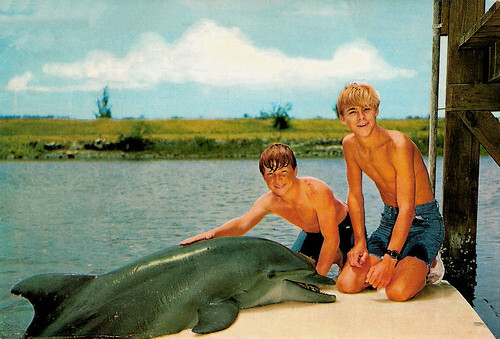
Dutch postcard by MUVA, Valkenburg. Luke Halpin and Tommy Norden in the NBC TV series Flipper (1964-1967). Sent by mail in 1968.
The American Children's television program Flipper was originally broadcast on NBC from 19 September 1964, until 15 April 1967. There were 3 seasons and 88 episodes of 25 minutes. Flipper, a bottlenose dolphin, is the companion animal of Porter Ricks (Brian Kelly), Chief Warden at fictional Coral Key Park and Marine Preserve in southern Florida, and his two young sons 15-year-old Sandy (Luke Halpin) and 10-year-old Bud (Tommy Norden). Flipper was played by three dolphins named Mitzi, Little Bit, and Mr. Gipper. Mitzi did the close-up shots, but she wasn't very athletic, so Little Bit and Mr. Gipper did the stunt work. Today, Luke Halpin lives in Florida, where he works as a pilot and marine technician for a film production company. After two other TV series, Tommy Norden left Hollywood to join the family business.
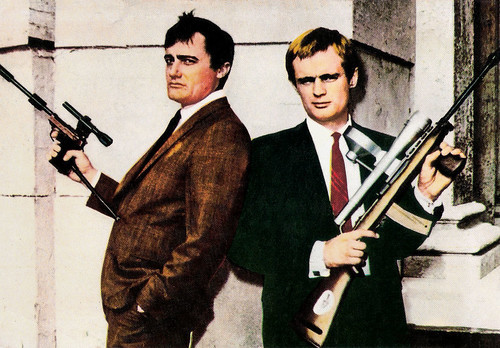
Spanish postcard by Postal Oscar Color S.A., Hospitalet (Barcelona), no. 727. Robert Vaughn and David McCallum in the American TV series The Man from U.N.C.L.E. (1964–1968).
American actor Robert Vaughn (1932-2016) played elegant, dark-haired Napoleon Solo in The Man from U.N.C.L.E. (1964-1968). The Spy series was television’s answer to James Bond. Together with his partner in the series, David McCallum (1933) as blond Russian Illya Kuryakin, Vaughn set 1960s TV’s standard for suavity and crimebusting cool. They played two top Agents of the United Network Command for Law and Enforcement (U.N.C.L.E.) who fight the enemies of peace, particularly the forces of the evil organisation T.H.R.U.S.H. (Technological Hierarchy for the Removal of Undesirables and the Subjugation of Humanity). Both agents use charm, wit, and a never-ending assortment of gadgets. The series’s international popularity led to back-to-back of Golden Globe nominations for Vaughn as Best TV Star in 1965-1966.
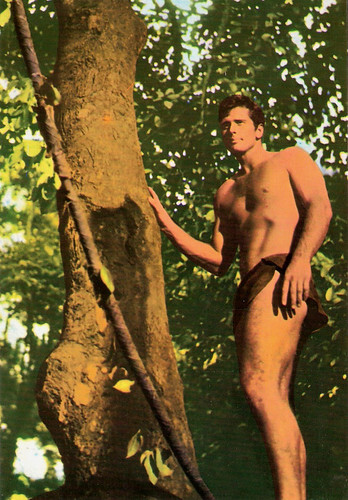
British postcard by Klasik Kards, no. 1588. Ron Ely in the TV series Tarzan (1966-1968).
After the huge success of Tarzan on the big screen, Producer Sy Weintraub, who took over the Tarzan franchise in the mid-1950s from Sol L. Lesser, took the ape man from the silver screen to television. In the American-Mexican series Tarzan (1966-1968), Ron Ely starred as Tarzan (Lord Greystoke), already well educated and fed up with civilisation. He returns to the jungle and, more or less assisted by chimpanzee Cheetah and orphan boy Jai (Manuel Padilla Jr., who had starred in the Tarzan films with Mike Henry), wages war against poachers and other bad guys. There was no Jane in the series.
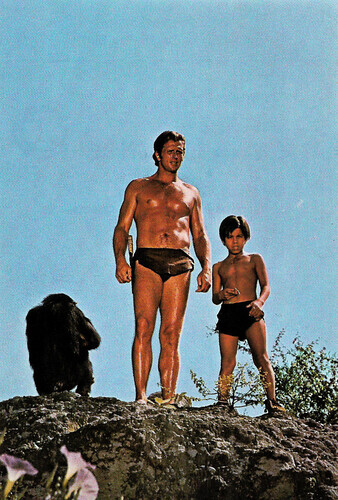
German collectors card by Penny in the series 'Unsere Bambi-Lieblinge', no. 27. Ron Ely as Tarzan and Manuel Padilla Jr. as Jai with Cheeta in the TV series Tarzan (1966-1968).
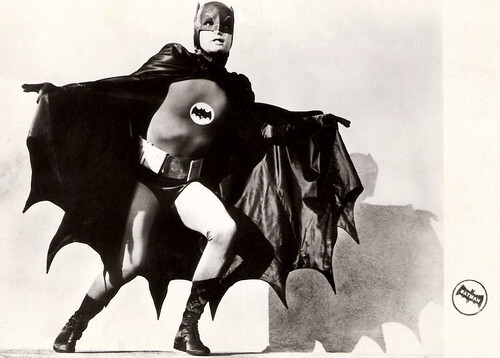
Dutch postcard by KRO. Adam West in the TV series Batman (1966-1968).
At the beginning of 1966, everything turned Batman. The TV show dominated television, merchandising - an advertisement for the show in the US even made it to the Super Bowl! The show even was made into a theatrically released movie, also starring Adam West as Batman / Bruce Wayne and Burt Ward as Robin / Dick Grayson. In the Netherlands, the show was broadcasted by the KRO, which made this postcard for many fans.
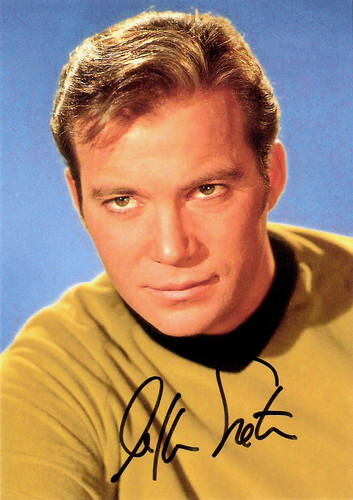
Vintage autograph card. William Shatner as Captain Kirk in the American TV series Star Trek (1966-1969).
Captain James Tiberius 'Jim' Kirk is the main character in the classic American TV series Star Trek . As the captain of the starship USS Enterprise, Kirk leads his crew as they explore "where no man has gone before". Kirk, played by William Shatner, first appears in the broadcast pilot episode of Star Trek: The Original Series, 'The Man Trap' (1966). Shatner continued in the role for the show's three seasons, and later provided the voice of the animated version of Kirk in Star Trek: The Animated Series (1973–74). Shatner returned to the role for Star Trek: The Motion Picture (1979) and in six subsequent films.

French postcard by Publistar, Marseille, no. 920. Photo: United-Press. Steve McQueen in Wanted: Dead or Alive (1958-1961).
Steve McQueen (1930-1980) was the ultra-cool Hollywood star of the 1960s and is still an icon of our popular culture. McQueen's first breakout role came on television. He appeared on Dale Robertson's NBC Western series Tales of Wells Fargo as Bill Longley. McQueen next filmed a pilot episode for what became the series titled Wanted: Dead or Alive, which aired on CBS in September 1958. This became his breakout role. He would later cross over into comparable status on the big screen, making him the first TV star to do so.

Spanish postcard by Postal Oscarcolor, no. 330.

British postcard by D. Constance Ltd, London, no. 106. Photo: Reisfeld / Ufa. Clint Eastwood in the TV series Rawhide (1959–1966).
Before he rose to fame as the Man with No Name in Sergio Leone's classic Spaghetti Westerns Per un pugno di dollari/A Fistful of Dollars (1964), Per qualche dollaro in più/For a Few Dollars More (1965), and Il buono, il brutto, il cattivo/The Good, the Bad and the Ugly (1966), Clint Eastwood (1930) was a TV star as Rowdy Yates in the Western series Rawhide (1959–1966).

American postcard by the American Postcard Co. Inc., no. TV22, 1984. Photo: Viacom International Inc. Clint Eastwood as Rowdy Yates in Rawhide (1959–1966).

American Arcade postcard. Guy Madison in the TV series Adventures of Wild Bill Hickok (1951-1958).
Handsome American leading man Guy Madison (1922-1996) appeared in 85 films, on radio, and on television. In the 1940s, he started as a fresh-faced dreamboat. He became a hero to the Baby Boom generation as James Butler Hickock in the television series Adventures of Wild Bill Hickok (1951-1958). After the Hickok series ended, Madison became a star of European cinema.

Spanish postcard by Raker, no. 1155, 1965. Photo: Clint Walker in the TV series Cheyenne (1955-1962).
Heavy set, athletic Clint Walker (1927) is a retired American actor and singer. In the 1950s, Walker with his broad shoulders and slim waist almost single-handedly started the Western craze on TV in his role as Cheyenne Bodie in Cheyenne (1955-1962).

British postcard by Star, no. SP424. Photo: Warner Bros. Pictures, 1962. Will Hutchins in the TV series Sugarfoot/Tenderfoot (1957-1961).
Will Hutchins played the fledgling frontier lawyer Tom Brewster and Jack Elam as sidekick Toothy Thompson. Brewster was a correspondence-school graduate whose apparent lack of cowboy skills earned him the peculiar nickname 'Sugarfoot'. Brewster never used firearms, preferring to vanquish villains with his roping skills if friendly persuasion failed. He was reluctant to use firearms, but able and willing to do so as a last resort. During the same period, other similar shows would appear, including Maverick with James Garner and Jack Kelly, Cheyenne with Clint Walker, Bronco with Ty Hardin, Lawman with John Russell, and Colt .45 with Wayde Preston. Hutchins appeared as Sugarfoot in crossover episodes of Cheyenne, Maverick, and Bronco.

Spanish postcard by Ediciones Este, no. 7 T, 1963. Photo: Warner Bros. Ty Hardin in the TV series Bronco (1958-1962).
American actor Ty Hardin (1930-2017) is probably best known as TV cowboy Bronco. Though born as Jr. Orison Whipple Hungerford (!) in New York City, Ty Hardin was raised in Texas and, after military service during the Korean War, took some classes at Texas A&M. He then moved west to California and won some minor roles in B movies, credited as Ty Hungerford. When TV's Clint Walker insisted on improvements in his Cheyenne (1955) contract, Warner Brothers countered by bringing in Ty as a possible replacement. Soon, Ty had his own show, Bronco, which ran from 1958 to 1962. From here, he moved into a brief flurry of film activity.

Spanish postcard by Ediciones Este, no. 8 T, 1963. Photo: Warner Bros. Ty Hardin in the TV series Bronco (1958-1962).

Spanish postcard by CyA, no. 22. Photo: Warner Bros. James Garner in the TV series Maverick (1957-1960).
James Garner (1928-2014) became known to a wider audience with the role of professional gambler Bret Maverick in the Western TV series Maverick (1957-1960) opposite Jack Kelly as his brother Bart Maverick. Maverick played poker on riverboats and in saloons while traveling incessantly through the 19th-century American frontier. When Garner left the series in 1960, Roger Moore played for a while cousin Beau, namesake nephew of Beau 'Pappy' Maverick. Beau returned from an extended stay in England to meet cousin Bart. Years later, Garner and Kelly reappeared as Bret and Bart Maverick in a made-for-television film titled The New Maverick (Hy Averback, 1978) written by Juanita Bartlett, and in the series Bret Maverick (1981-1982).

Spanish postcard by Ediciones Este, no. 36. Roger Moore in Maverick (1959-1961).

French postcard by Publistar, offered by Corvisart, Epinal, no. 919. Photo: United-Press.
American actor, artist, and author Gardner McKay (1932-2001) was best known for the lead role in the TV series Adventures in Paradise (1959-1962), based loosely on the writings of James Michener. He quit acting and became a writer in 1970.

American Arcade postcard. Gardner McKay in Adventures in Paradise (1959-1962).

Spanish postcard by Oscarcolor, no. 16-T. Photo: Warner Bros. Troy Donahue , Lee Patterson, and Van Williams in the TV series Surfside 6 (1960-1962).
Surfside 6 was about the adventures of three hip private detectives, Ken (Van Williams), Dave (Lee Patterson) and Sandy ( Troy Donahue ). The three live on and work out of a houseboat in Miami, Florida. A yacht, belonging to socialite Daphne (Diane McBain), is anchored next to their houseboat. While not pursuing criminals, they spend time at the Fontainebleau Hotel chasing Cha Cha (Margarita Sierra) who works as an entertainer in the Boom Boom Room.

Spanish postcard by Oscarcolor, no. 252. Photo: Warner Bros. Van Williams in the TV series Surfside 6 (1960-1962).

German postcard by Filmbilder-Vertrieb Ernst Freihoff, Essen, no. AX 5597. Photo: Michael Landon in the TV series Bonanza (1959-1973).
Michael Landon played Little Joe, the youngest and most handsome of the Cartwright brothers in the legendary American Western series Bonanza (1959-1973). Ben Cartwright (Lorne Greene) and his sons Hoss (Dan Blocker), Adam (Pernell Roberts) and Little Joe (Michael Landon) had many adventures while running and defending their Ponderosa Ranch in Nevada and helping the surrounding community.

American Arcade card.
Impeccably handsome American actor Richard Chamberlain (1934) was TV's leading heartthrob because of his title role in the medical series Dr. Kildare (1961-1966). The slim, butter-haired hunk with the near-perfect Ivy-League charm and smooth, intelligent demeanour, had the distaff fans fawning unwavering over him through the series' run.

German postcard by Krüger, no. 902/240.

French postcard by Éditions d'art Yvon, Arcueil, no. 2. Photo: O.R.T.F. / Télé France Film / Photo Bruguière. Jean-Claude Drouot in the TV series Thierry la Fronde (1963-1966).
Belgian actor Jean-Claude Drouot (1938) started his acting career with a boom in the French cult TV series Thierry La Fronde (1963-1966) and with Agnes Varda’s controversial masterpiece Le Bonheur (1965). Although he went on to appear in many film, TV and stage roles he would never completely lose the image of Thierry la Fronde, the French Robin Hood.

Dutch postcard by MUVA, Valkenburg. Luke Halpin and Tommy Norden in the NBC TV series Flipper (1964-1967). Sent by mail in 1968.
The American Children's television program Flipper was originally broadcast on NBC from 19 September 1964, until 15 April 1967. There were 3 seasons and 88 episodes of 25 minutes. Flipper, a bottlenose dolphin, is the companion animal of Porter Ricks (Brian Kelly), Chief Warden at fictional Coral Key Park and Marine Preserve in southern Florida, and his two young sons 15-year-old Sandy (Luke Halpin) and 10-year-old Bud (Tommy Norden). Flipper was played by three dolphins named Mitzi, Little Bit, and Mr. Gipper. Mitzi did the close-up shots, but she wasn't very athletic, so Little Bit and Mr. Gipper did the stunt work. Today, Luke Halpin lives in Florida, where he works as a pilot and marine technician for a film production company. After two other TV series, Tommy Norden left Hollywood to join the family business.

Spanish postcard by Postal Oscar Color S.A., Hospitalet (Barcelona), no. 727. Robert Vaughn and David McCallum in the American TV series The Man from U.N.C.L.E. (1964–1968).
American actor Robert Vaughn (1932-2016) played elegant, dark-haired Napoleon Solo in The Man from U.N.C.L.E. (1964-1968). The Spy series was television’s answer to James Bond. Together with his partner in the series, David McCallum (1933) as blond Russian Illya Kuryakin, Vaughn set 1960s TV’s standard for suavity and crimebusting cool. They played two top Agents of the United Network Command for Law and Enforcement (U.N.C.L.E.) who fight the enemies of peace, particularly the forces of the evil organisation T.H.R.U.S.H. (Technological Hierarchy for the Removal of Undesirables and the Subjugation of Humanity). Both agents use charm, wit, and a never-ending assortment of gadgets. The series’s international popularity led to back-to-back of Golden Globe nominations for Vaughn as Best TV Star in 1965-1966.

British postcard by Klasik Kards, no. 1588. Ron Ely in the TV series Tarzan (1966-1968).
After the huge success of Tarzan on the big screen, Producer Sy Weintraub, who took over the Tarzan franchise in the mid-1950s from Sol L. Lesser, took the ape man from the silver screen to television. In the American-Mexican series Tarzan (1966-1968), Ron Ely starred as Tarzan (Lord Greystoke), already well educated and fed up with civilisation. He returns to the jungle and, more or less assisted by chimpanzee Cheetah and orphan boy Jai (Manuel Padilla Jr., who had starred in the Tarzan films with Mike Henry), wages war against poachers and other bad guys. There was no Jane in the series.

German collectors card by Penny in the series 'Unsere Bambi-Lieblinge', no. 27. Ron Ely as Tarzan and Manuel Padilla Jr. as Jai with Cheeta in the TV series Tarzan (1966-1968).

Dutch postcard by KRO. Adam West in the TV series Batman (1966-1968).
At the beginning of 1966, everything turned Batman. The TV show dominated television, merchandising - an advertisement for the show in the US even made it to the Super Bowl! The show even was made into a theatrically released movie, also starring Adam West as Batman / Bruce Wayne and Burt Ward as Robin / Dick Grayson. In the Netherlands, the show was broadcasted by the KRO, which made this postcard for many fans.

Vintage autograph card. William Shatner as Captain Kirk in the American TV series Star Trek (1966-1969).
Captain James Tiberius 'Jim' Kirk is the main character in the classic American TV series Star Trek . As the captain of the starship USS Enterprise, Kirk leads his crew as they explore "where no man has gone before". Kirk, played by William Shatner, first appears in the broadcast pilot episode of Star Trek: The Original Series, 'The Man Trap' (1966). Shatner continued in the role for the show's three seasons, and later provided the voice of the animated version of Kirk in Star Trek: The Animated Series (1973–74). Shatner returned to the role for Star Trek: The Motion Picture (1979) and in six subsequent films.
Published on August 26, 2022 22:00
August 25, 2022
Michael J. Fox
Michael J. Fox (1961) is a Canadian-born actor, best known for his roles as Alex P. Keaton in the TV series Family Ties (1982-1989) and as Marty McFly in the Back to the Future trilogy. He also played Mike Flaherty in the television series Spin City.
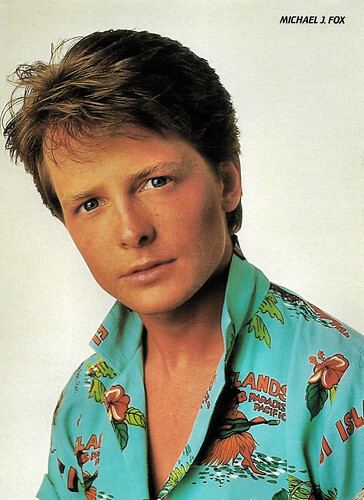
British postcard by Holmes McDougall Ltd, Edinburgh, Scotland, no. PC240. Photo: Minerva, 1987.
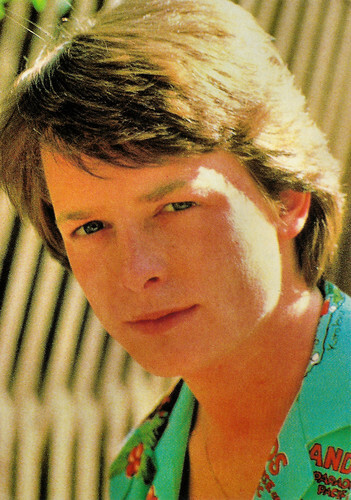
Italian postcard by Vittorius, Roma, no. VR 501.
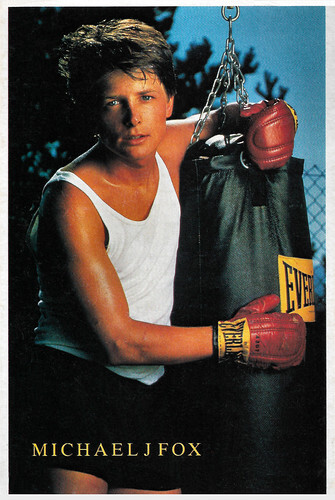
British postcard by Just Seventeen. Photo: Mark Hanauer. Caption: One of a set of four postcards from Just Seventeen - Britain's brightest weekly girl's magazine.
The time-travelling teen Marty McFly
Michael J. Fox is the stage name of Michael Andrew Fox, who was born in Edmonton, Alberta in 1961. His parents are Phyllis Fox (née Piper), a payroll clerk, and William Fox. They moved their 10-year-old son, his three sisters, Kelli, Karen, and Jacki, and his brother Steven, to Vancouver, British Columbia, after his father, a sergeant in the Canadian Army Signal Corps, retired.
During these years Michael developed his desire to act. Fox uses 'J.' as the second initial, in homage to actor Michael J. Pollard. He did not choose 'Michael A. Fox", as this could possibly be associated with arrogance (a fox). His first role was at the age of twelve in the popular drama series The Beachcombers (1973) about the adventures of a professional lumber salvager and his friends in British Columbia. At 15 he successfully auditioned for the role of a 10-year-old in a series called Leo and Me (1978).
At 18 he moved to Los Angeles and he was surviving on boxes of macaroni and cheese until he was able to get his green card. His first role in a film was in Letters From Frank (Edward Parone, 1979) starring Art Carney. Things started breaking for Fox in 1980, when he won a regular role on the weekly series Palmerstown, U.S.A. (1980-1981) and a supporting part in the theatrical film Midnight Madness (Michael Nankin, David Wechter, 1980).
At 5'4" (163 cm), the baby-faced Fox was able to play adolescents and teenagers well into his twenties; during the early stages of his career, however, his height lost him as many roles as he won. In 1982, Fox rose to fame in the television long-running sitcom Family Ties (1982-1989), in which he played Alex P. Keaton, the conservative, college-educated son of a hippie-era couple. He was only chosen after Matthew Broderick, who was originally considered for the role, refused to have a long-term television obligation. Before the series ran its course, Fox had won three Emmys, one of them for an unforgettable "one-man show" in which his character soliloquized over the suicide of a close friend.
In 1982, he made a splash in the cinemas with Class of 1984 (Mark L. Lester, 1982), a mix between Dangerous Minds and A Clockwork Orange, starring Perry King. He also starred in the feature films High School U.S.A. (Rod Amateau, 1983), Teen Wolf (Rod Daniel, 1985) and Poison Ivy (Larry Elikann, 1985).
His real breakthrough came with his role as the time-travelling teen Marty McFly in Back to the Future (Robert Zemeckis, 1985), in which he starred with Christopher Lloyd. The role of Marty McFly was initially intended for Eric Stoltz because Fox was shooting Family Ties. But during the shoot, filmmakers found Stolz unsuitable for the role and asked Fox for the role. Back to the Future (1985) was an enormous hit which spawned two sequels, Back to the Future Part II (Robert Zemeckis, 1989) and Back to the Future Part III (Robert Zemeckis, 1990).
Hal Erickson at AllMovie : "Not all of Fox's subsequent movie projects were so successful -- although several of them, notably The Secret of My Success (Herbert Ross, 1987) and Casualties of War (Brian De Palma, 1989), were commendable efforts that expanded Fox's range. In later years, the actor seemed to be having difficulty finding the vehicle that would put him back on top, although he continued to keep busy."
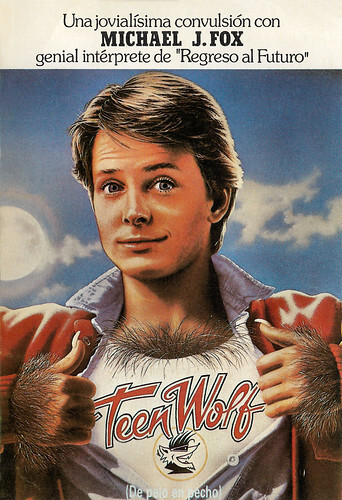
Spanish postcard by Rovensa. Photo: CB Films. Michael J. Fox in Teen Wolf (Rod Daniel, 1985). Caption (flip side): Tu seras mi lobo! (You will be my wolf!).
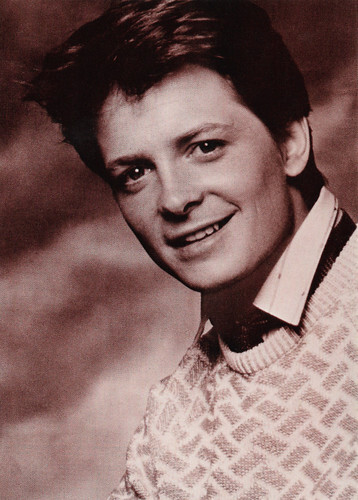
Vintage postcard.
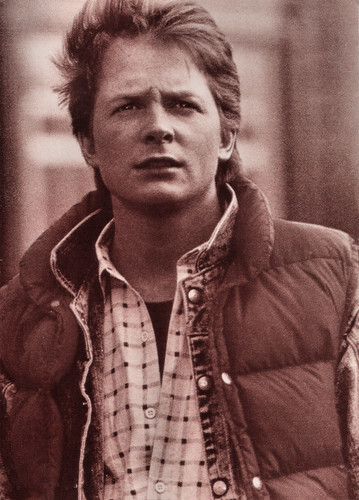
Vintage postcard. Michael J. Fox in Back to the Future (Robert Zemeckis, 1985).

Dutch collectors card.
Diagnosed with Parkinson's disease
In the fall of 1996, Michael J. Fox returned to television in the ABC sitcom Spin City (1996-2001), of which he was also a co-producer. He starred in the series as Michael Flaherty, the Deputy Mayor of New York City. That same year, he could also be seen in the films Mars Attacks! (Tim Burton, 1996) with Jack Nicholson and The Frighteners (Peter Jackson, 1996).
In 1998, Fox revealed that he was diagnosed with Parkinson's disease. When filming Doc Hollywood (Michael Caton-Jones, 1991), he noticed his finger twitching and was unable to control it. He then saw a doctor and was diagnosed with Parkinson's. Due to his Parkinson's disease, he often hid his left hand in his pocket during his run on Spin City.
In 1999, he lent his talents to another wee character, voicing the title role of Stuart Little (Rob Minkoff, 1999), the film adaptation of E.B. White's beloved children's book about a walking, talking mouse. In 2000, he decided to retire as an actor and was succeeded in Spin City by Charlie Sheen. Since then, Fox has been a fundraiser for stem cell research. He believes that this technique can help cure neurological diseases in the future.
In the following decades, he was mainly a voice actor in animated films, including Stuart Little 2 (Rob Minkoff, 2002). In 2006, he did have a guest role in several episodes of the series Boston Legal, which earned him an Emmy nomination. In 2011 and 2017, he starred 'as himself' in the series Curb Your Enthusiasm. Thanks to the new medication, he was able to act again. In 2013 he starred in the comedy television series, The Michael J. Fox Show, based on his own life. He also appeared in the popular TV series The Good Wife (2010-2016) starring Julianne Margulies.
Fox wrote four autobiographical books about his experiences with early-onset Parkinson's disease: 'Lucky Man: A Memoir' (2002), 'Always Looking Up: The Adventures of an Incurable Optimist' (2009), 'A Funny Thing Happened on the Way to the Future: Twists and Turns and Lessons Learned' (2010), and 'No Time Like the Future: An Optimist Considers Mortality' (2020). In these books, he candidly recounts his life before and after the diagnosis and how the initially difficult time turned into a very important period in his life. Since 1988, Michael J. Fox is married to Tracy Pollan, whom he met on the set of Family Ties. Together they have four children.

German collectors card by Bravo.

Spanish postcard by Papellini, Barcelona, no. 026. Photo: ACI.
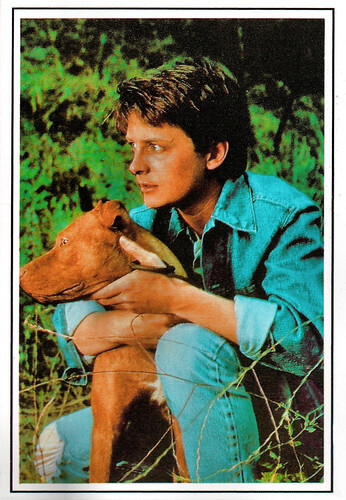
French postcard, no. SL 4077.
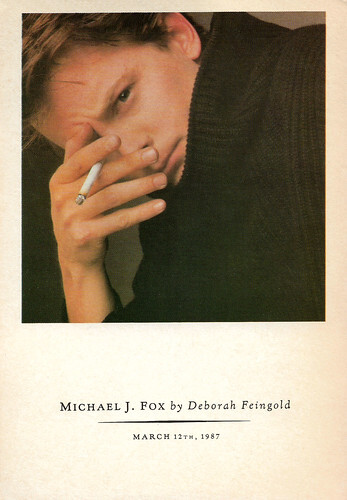
British postcard by Box Office, no. BOPC 3035. Photo: Deborah Feingold. Caption: March 12th, 1987.
Sources: Hal Erickson (AllMovie), Wikipedia (Dutch) and .

British postcard by Holmes McDougall Ltd, Edinburgh, Scotland, no. PC240. Photo: Minerva, 1987.

Italian postcard by Vittorius, Roma, no. VR 501.

British postcard by Just Seventeen. Photo: Mark Hanauer. Caption: One of a set of four postcards from Just Seventeen - Britain's brightest weekly girl's magazine.
The time-travelling teen Marty McFly
Michael J. Fox is the stage name of Michael Andrew Fox, who was born in Edmonton, Alberta in 1961. His parents are Phyllis Fox (née Piper), a payroll clerk, and William Fox. They moved their 10-year-old son, his three sisters, Kelli, Karen, and Jacki, and his brother Steven, to Vancouver, British Columbia, after his father, a sergeant in the Canadian Army Signal Corps, retired.
During these years Michael developed his desire to act. Fox uses 'J.' as the second initial, in homage to actor Michael J. Pollard. He did not choose 'Michael A. Fox", as this could possibly be associated with arrogance (a fox). His first role was at the age of twelve in the popular drama series The Beachcombers (1973) about the adventures of a professional lumber salvager and his friends in British Columbia. At 15 he successfully auditioned for the role of a 10-year-old in a series called Leo and Me (1978).
At 18 he moved to Los Angeles and he was surviving on boxes of macaroni and cheese until he was able to get his green card. His first role in a film was in Letters From Frank (Edward Parone, 1979) starring Art Carney. Things started breaking for Fox in 1980, when he won a regular role on the weekly series Palmerstown, U.S.A. (1980-1981) and a supporting part in the theatrical film Midnight Madness (Michael Nankin, David Wechter, 1980).
At 5'4" (163 cm), the baby-faced Fox was able to play adolescents and teenagers well into his twenties; during the early stages of his career, however, his height lost him as many roles as he won. In 1982, Fox rose to fame in the television long-running sitcom Family Ties (1982-1989), in which he played Alex P. Keaton, the conservative, college-educated son of a hippie-era couple. He was only chosen after Matthew Broderick, who was originally considered for the role, refused to have a long-term television obligation. Before the series ran its course, Fox had won three Emmys, one of them for an unforgettable "one-man show" in which his character soliloquized over the suicide of a close friend.
In 1982, he made a splash in the cinemas with Class of 1984 (Mark L. Lester, 1982), a mix between Dangerous Minds and A Clockwork Orange, starring Perry King. He also starred in the feature films High School U.S.A. (Rod Amateau, 1983), Teen Wolf (Rod Daniel, 1985) and Poison Ivy (Larry Elikann, 1985).
His real breakthrough came with his role as the time-travelling teen Marty McFly in Back to the Future (Robert Zemeckis, 1985), in which he starred with Christopher Lloyd. The role of Marty McFly was initially intended for Eric Stoltz because Fox was shooting Family Ties. But during the shoot, filmmakers found Stolz unsuitable for the role and asked Fox for the role. Back to the Future (1985) was an enormous hit which spawned two sequels, Back to the Future Part II (Robert Zemeckis, 1989) and Back to the Future Part III (Robert Zemeckis, 1990).
Hal Erickson at AllMovie : "Not all of Fox's subsequent movie projects were so successful -- although several of them, notably The Secret of My Success (Herbert Ross, 1987) and Casualties of War (Brian De Palma, 1989), were commendable efforts that expanded Fox's range. In later years, the actor seemed to be having difficulty finding the vehicle that would put him back on top, although he continued to keep busy."

Spanish postcard by Rovensa. Photo: CB Films. Michael J. Fox in Teen Wolf (Rod Daniel, 1985). Caption (flip side): Tu seras mi lobo! (You will be my wolf!).

Vintage postcard.

Vintage postcard. Michael J. Fox in Back to the Future (Robert Zemeckis, 1985).

Dutch collectors card.
Diagnosed with Parkinson's disease
In the fall of 1996, Michael J. Fox returned to television in the ABC sitcom Spin City (1996-2001), of which he was also a co-producer. He starred in the series as Michael Flaherty, the Deputy Mayor of New York City. That same year, he could also be seen in the films Mars Attacks! (Tim Burton, 1996) with Jack Nicholson and The Frighteners (Peter Jackson, 1996).
In 1998, Fox revealed that he was diagnosed with Parkinson's disease. When filming Doc Hollywood (Michael Caton-Jones, 1991), he noticed his finger twitching and was unable to control it. He then saw a doctor and was diagnosed with Parkinson's. Due to his Parkinson's disease, he often hid his left hand in his pocket during his run on Spin City.
In 1999, he lent his talents to another wee character, voicing the title role of Stuart Little (Rob Minkoff, 1999), the film adaptation of E.B. White's beloved children's book about a walking, talking mouse. In 2000, he decided to retire as an actor and was succeeded in Spin City by Charlie Sheen. Since then, Fox has been a fundraiser for stem cell research. He believes that this technique can help cure neurological diseases in the future.
In the following decades, he was mainly a voice actor in animated films, including Stuart Little 2 (Rob Minkoff, 2002). In 2006, he did have a guest role in several episodes of the series Boston Legal, which earned him an Emmy nomination. In 2011 and 2017, he starred 'as himself' in the series Curb Your Enthusiasm. Thanks to the new medication, he was able to act again. In 2013 he starred in the comedy television series, The Michael J. Fox Show, based on his own life. He also appeared in the popular TV series The Good Wife (2010-2016) starring Julianne Margulies.
Fox wrote four autobiographical books about his experiences with early-onset Parkinson's disease: 'Lucky Man: A Memoir' (2002), 'Always Looking Up: The Adventures of an Incurable Optimist' (2009), 'A Funny Thing Happened on the Way to the Future: Twists and Turns and Lessons Learned' (2010), and 'No Time Like the Future: An Optimist Considers Mortality' (2020). In these books, he candidly recounts his life before and after the diagnosis and how the initially difficult time turned into a very important period in his life. Since 1988, Michael J. Fox is married to Tracy Pollan, whom he met on the set of Family Ties. Together they have four children.

German collectors card by Bravo.

Spanish postcard by Papellini, Barcelona, no. 026. Photo: ACI.

French postcard, no. SL 4077.

British postcard by Box Office, no. BOPC 3035. Photo: Deborah Feingold. Caption: March 12th, 1987.
Sources: Hal Erickson (AllMovie), Wikipedia (Dutch) and .
Published on August 25, 2022 22:00
August 24, 2022
La gola (1918)
Francesca Bertini (1892-1985) was a majestic diva of the Italian silent cinema. She often played the 'femme fatale', with men devouring eyes, glamorous attire, clenched fists, and in opulent settings, but La gola/Gluttony (Camillo De Riso, 1918) was a comedy with a girly, wild Bertini who mocks society and arranged marriages. It was a part of the series I sette peccati capitali/The Seven Mortal Sins, based on the novel 'Les sept pêchés capitaux' (1847-1852) by Eugène Sue. Sue was a famed serial writer, well known for 'Les Mystères de Paris' (1842-1843). La gola was released in Spain as Gula and Ivo Blom found this colourful series of chocolate cards for this post.
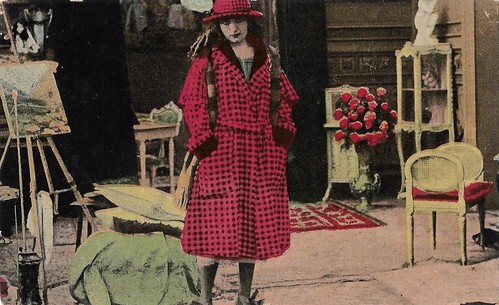
Spanish collectors card by Chocolat Imperiale, no. 2. Photo: Bertini Film / Caesar Film / Distr. J. Gurgui, Barcelona. Francesca Bertini in La gola (Camillo De Riso, 1918).
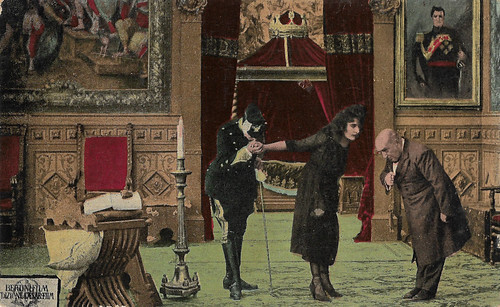
Spanish collectors card by Chocolat Imperiale, no. 2. Photo: Bertini Film / Caesar Film / Distr. J. Gurgui, Barcelona. Livio Pavanelli , Francesca Bertini, and Camillo De Riso in La gola (Camillo De Riso, 1918).
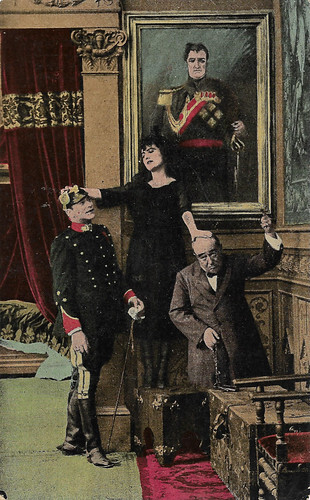
Spanish collectors card by Chocolat Imperiale, no. 3. Photo: Bertini Film / Caesar Film / Distr. J. Gurgui, Barcelona. Livio Pavanelli , Francesca Bertini , and Camillo De Riso in La gola (Camillo De Riso, 1918).
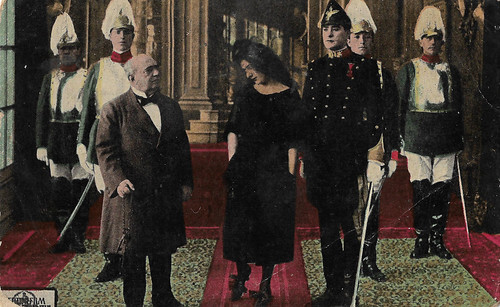
Spanish collectors card by Chocolat Imperiale, no. 4. Photo: Bertini Film / Caesar Film / Distr. J. Gurgui, Barcelona. Francesca Bertini , Camillo De Riso and Livio Pavanelli in La gola (Camillo De Riso, 1918).
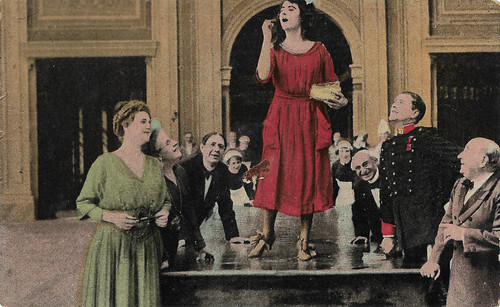
Spanish collectors card by Chocolat Imperiale, no. 5. Photo: Bertini Film / Caesar Film / Distr. J. Gurgui, Barcelona. Francesca Bertini , Camillo De Riso and Livio Pavanelli in La gola (Camillo De Riso, 1918).
Frescalinda crossdresses, changes, agitates, jumps onto balconies, makes up adventures...
In La gola/Gluttony (1918), Francesca Bertini plays the young countess Frescalinda Ciufettino who wants to marry the dashing Captain Gallardo Amore ( Livio Pavanelli ). Her parents want to marry her to an old, serious Royal Highness ( Camillo De Riso ) from a neighbouring nation. In order to avoid marrying this silly, arrogant creature, Frescalinda crossdresses, changes, agitates, jumps onto balconies, makes up adventures, continuously performs intellectual gymnastics, laughs, sings, and puts up charades, until she discovers the man's Achilles heel: his gluttony.
Italian critics were not mild at the time. Bertoldo, in the Turinese journal La vita cinematografica wrote in 1919 that the eighth sin was that Caesar Film took this novel as the inspiration for a series of films with Francesca Bertini . He considered La gola a mediocre comedy, lacking movement and 'brille'.
The Roman critic Carlo Zappio 'Zac' commented that film was the perfect means to show the physical defects of Bertini: crooked legs, too thin arms, a head disproportionate, and irregular teeth.
It was clear the audience thought otherwise and continued to flock to Bertini's films. The girly, wild Bertini mocking society and arranged marriages must have been very different from her femme fatale-like parts. The cards suggest a kind of Italian variation on certain German comedies, such as Ernst Lubitsch's Die Austernprinzessin/The Oyster Princess (1919), or the comedies with Dorrit Weixler .
La gola was scripted by Pio Vanzi, cinematographed by Luigi Filippo, while the art direction was by Alfredo Manzi. The film premiered in Rome on 17 January 1919. While the series of I sette peccati capitali was long believed lost, it was found at the Prague Film Institute, where it was carefully restored including the tinting. The films were shown at the festival Il Cinema Ritrovatto at Bologna. In 1991 the first restorations of L'avarizia and L'orgoglio were presented, while in 2003 the whole series was screened, including La gola.
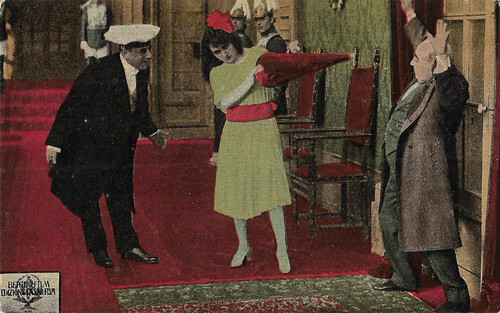
Spanish collectors card by Chocolat Imperiale, no. 6. Photo: Bertini Film / Caesar Film / Distr. J. Gurgui, Barcelona. Francesca Bertini and Camillo De Riso in La gola (Camillo De Riso, 1918).
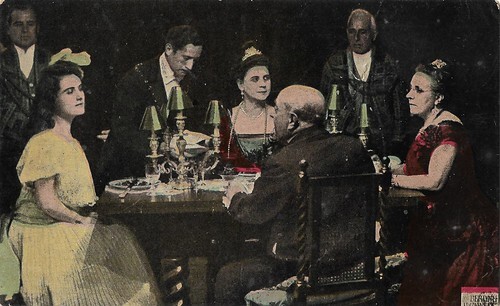
Spanish collectors card by Chocolat Imperiale, no. 7. Photo: Bertini Film / Caesar Film / Distr. J. Gurgui, Barcelona. Francesca Bertini and Camillo De Riso in La gola (Camillo De Riso, 1918).
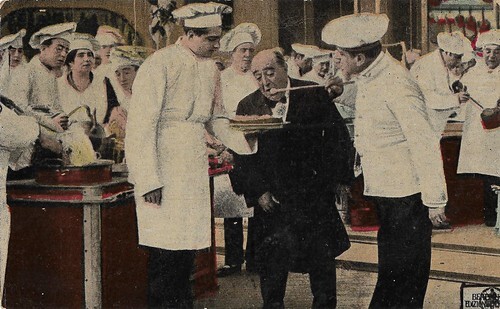
Spanish collectors card by Chocolat Imperiale, no. 8. Photo: Bertini Film / Caesar Film / Distr. J. Gurgui, Barcelona. Camillo De Riso in La gola (Camillo De Riso, 1918).
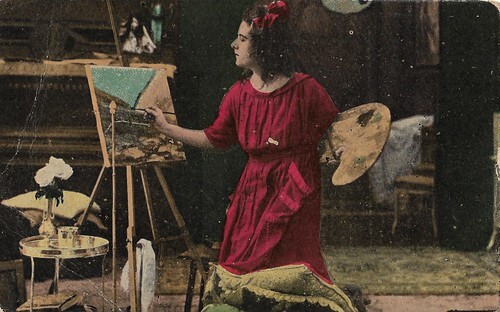
Spanish collectors card by Chocolat Imperiale, no. 9. Photo: Bertini Film / Caesar Film / Distr. J. Gurgui, Barcelona. Francesca Bertini in La gola (Camillo De Riso, 1918).
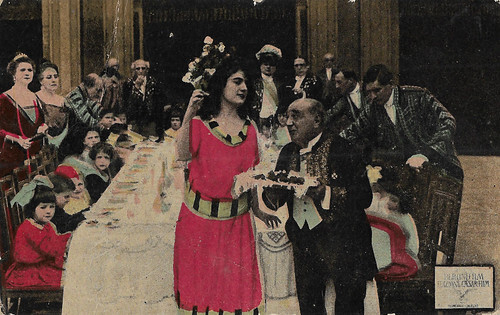
Spanish collectors card by Chocolat Imperiale, no. 10. Photo: Bertini Film / Caesar Film / Distr. J. Gurgui, Barcelona. Francesca Bertini and Camillo De Riso in La gola (Camillo De Riso, 1918).
Sources: Vittorio Martinelli (Il cinema muto italiano, Vol. 1918 - Italian) and IMDb.

Spanish collectors card by Chocolat Imperiale, no. 2. Photo: Bertini Film / Caesar Film / Distr. J. Gurgui, Barcelona. Francesca Bertini in La gola (Camillo De Riso, 1918).

Spanish collectors card by Chocolat Imperiale, no. 2. Photo: Bertini Film / Caesar Film / Distr. J. Gurgui, Barcelona. Livio Pavanelli , Francesca Bertini, and Camillo De Riso in La gola (Camillo De Riso, 1918).

Spanish collectors card by Chocolat Imperiale, no. 3. Photo: Bertini Film / Caesar Film / Distr. J. Gurgui, Barcelona. Livio Pavanelli , Francesca Bertini , and Camillo De Riso in La gola (Camillo De Riso, 1918).

Spanish collectors card by Chocolat Imperiale, no. 4. Photo: Bertini Film / Caesar Film / Distr. J. Gurgui, Barcelona. Francesca Bertini , Camillo De Riso and Livio Pavanelli in La gola (Camillo De Riso, 1918).

Spanish collectors card by Chocolat Imperiale, no. 5. Photo: Bertini Film / Caesar Film / Distr. J. Gurgui, Barcelona. Francesca Bertini , Camillo De Riso and Livio Pavanelli in La gola (Camillo De Riso, 1918).
Frescalinda crossdresses, changes, agitates, jumps onto balconies, makes up adventures...
In La gola/Gluttony (1918), Francesca Bertini plays the young countess Frescalinda Ciufettino who wants to marry the dashing Captain Gallardo Amore ( Livio Pavanelli ). Her parents want to marry her to an old, serious Royal Highness ( Camillo De Riso ) from a neighbouring nation. In order to avoid marrying this silly, arrogant creature, Frescalinda crossdresses, changes, agitates, jumps onto balconies, makes up adventures, continuously performs intellectual gymnastics, laughs, sings, and puts up charades, until she discovers the man's Achilles heel: his gluttony.
Italian critics were not mild at the time. Bertoldo, in the Turinese journal La vita cinematografica wrote in 1919 that the eighth sin was that Caesar Film took this novel as the inspiration for a series of films with Francesca Bertini . He considered La gola a mediocre comedy, lacking movement and 'brille'.
The Roman critic Carlo Zappio 'Zac' commented that film was the perfect means to show the physical defects of Bertini: crooked legs, too thin arms, a head disproportionate, and irregular teeth.
It was clear the audience thought otherwise and continued to flock to Bertini's films. The girly, wild Bertini mocking society and arranged marriages must have been very different from her femme fatale-like parts. The cards suggest a kind of Italian variation on certain German comedies, such as Ernst Lubitsch's Die Austernprinzessin/The Oyster Princess (1919), or the comedies with Dorrit Weixler .
La gola was scripted by Pio Vanzi, cinematographed by Luigi Filippo, while the art direction was by Alfredo Manzi. The film premiered in Rome on 17 January 1919. While the series of I sette peccati capitali was long believed lost, it was found at the Prague Film Institute, where it was carefully restored including the tinting. The films were shown at the festival Il Cinema Ritrovatto at Bologna. In 1991 the first restorations of L'avarizia and L'orgoglio were presented, while in 2003 the whole series was screened, including La gola.

Spanish collectors card by Chocolat Imperiale, no. 6. Photo: Bertini Film / Caesar Film / Distr. J. Gurgui, Barcelona. Francesca Bertini and Camillo De Riso in La gola (Camillo De Riso, 1918).

Spanish collectors card by Chocolat Imperiale, no. 7. Photo: Bertini Film / Caesar Film / Distr. J. Gurgui, Barcelona. Francesca Bertini and Camillo De Riso in La gola (Camillo De Riso, 1918).

Spanish collectors card by Chocolat Imperiale, no. 8. Photo: Bertini Film / Caesar Film / Distr. J. Gurgui, Barcelona. Camillo De Riso in La gola (Camillo De Riso, 1918).

Spanish collectors card by Chocolat Imperiale, no. 9. Photo: Bertini Film / Caesar Film / Distr. J. Gurgui, Barcelona. Francesca Bertini in La gola (Camillo De Riso, 1918).

Spanish collectors card by Chocolat Imperiale, no. 10. Photo: Bertini Film / Caesar Film / Distr. J. Gurgui, Barcelona. Francesca Bertini and Camillo De Riso in La gola (Camillo De Riso, 1918).
Sources: Vittorio Martinelli (Il cinema muto italiano, Vol. 1918 - Italian) and IMDb.
Published on August 24, 2022 22:00
Paul van Yperen's Blog
- Paul van Yperen's profile
- 13 followers
Paul van Yperen isn't a Goodreads Author
(yet),
but they
do have a blog,
so here are some recent posts imported from
their feed.



